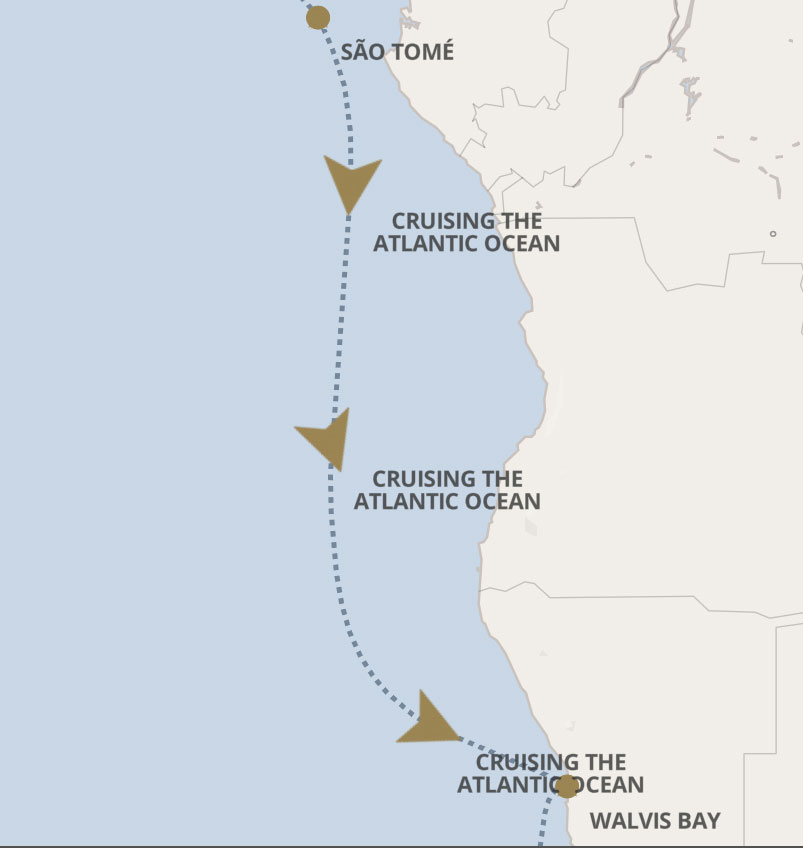
Barcelona to Cape Town
November 18 to December 13, 2023
Mike and Judy Henderson
We've visited most of the countries included in this cruise, but we still have a few to go - São Tomé and Príncipe, Namibia, and then South Africa.

+++++++++++++++++++++++++++++++++++++++++
12/5/2023 (Tuesday) We have a sea day today as we sail to São Tomé, and it's really appreciated. I'm feeling much better but Judy is still recovering from her cold.
Here's a side note on medical care on a cruise ship. Judy talked with a woman who said her husband had a cold and went to the medical department. The charge for his visit, a COVID test, and a medication was about $500. I'm sure they have travel medical insurance, but that's fairly expensive.
We took it easy and rested, but we did play trivia in the afternoon - we came out second!
After our visit to São Tomé we have three sea days before we get to Walvis Bay in Namibia.
+++++++++++++++++++++++++++++++++++++++++
12/6/2023 (Wednesday) We arrived at the city of São Tomé this morning and will tender in to the city. The island was uninhabited prior to the arrival of the Portuguese in 1470, who used the island to grow sugar cane.
I'm feeling well, almost back to normal, but Judy is still recovering. We learned this morning that our friend Richard came down with the same cold. We have three sea days after this stop, which will give them time to recover.
São Tomé has a connection to the 1492 Alhambra Decree by King Ferdinand and Queen Isabella expelling the Jews and Muslims from Spain. After the decree, some of the Jews of Spain fled to Portugal. On December 5, 1496, King Manuel I of Portugal signed the decree of expulsion of Jews and Muslims from Portugal to take effect by the end of October 1497. He did this under pressure from Spain.
It's difficult to find a definitive source, but in 1496 or 1497, Manuel I seized and deported almost 2,000 Jewish children under the age of ten (some as young as two) to São Tomé to be converted to Christianity and to work as slaves on the sugar plantations. Reports are that a year after arrival, only 600 of the children were still alive.
It is difficult to comprehend such an act of cruelty.
[Side note]
While I was researching this issue regarding São Tomé, I learned quite a bit about the persecution of Jews and Muslims in Spain about that time. It did not start in 1492, but went back centuries. Over time a majority of the Jews and Muslims converted to Christianity (at least in appearance) in order to avoid persecution, and eventually, expulsion. They were known as Converso, people who had converted to Christianity. Those Jews who pretended to convert but maintained their practices in secret were known as crypto-Jews. Many of these people were successful in business and government, and that caused envy among the long-time Christians who wanted the positions the Converso held in society and business (and especially their wealth). Spain and Portugal eventually passed laws known as Limpieza de Sangre (essentially, purity of blood)(see also here). These laws prohibited anyone with even one Jewish or Muslim ancestor from holding any government position, and caused them to be shunned in society. Note the similarity to Nazi Germany prior to WWII.
One wag pointed out that, under these laws, Jesus would not have been able to even be a porter in a Spanish cathedral.
This attitude was common in the US south after the Civil War, and probably up until about 1950. Anyone with a black ancestor could not be a part of polite society and could not marry into a prominent white family.
[End side note.]
São Tomé and Príncipe (English: Saint Thomas and Prince) are two islands off the equatorial coast of West Africa. They are about half the size of Maui (372 sq. miles compared to 727 sq. miles for Maui). The official language is Portuguese. Most of the people (80%) are Christians.
The primary export is cocoa, followed by copra, palm kernels, and Robusta coffee. Side note: Robusta coffee is generally considered inferior to Arabica coffee. The cocoa is mainly shipped to Europe and the US for the making of chocolate.
The island of São Tomé is just above the equator, so we will cross the equator shorty after we weigh anchor at 4pm. The crew has organized a King Neptune's Court (also see here and here) for 5pm today on the pool deck. Pollywogs will have the option to participate. I'll have pictures. Judy and I are Shellbacks, from our trip to the Galapagos.
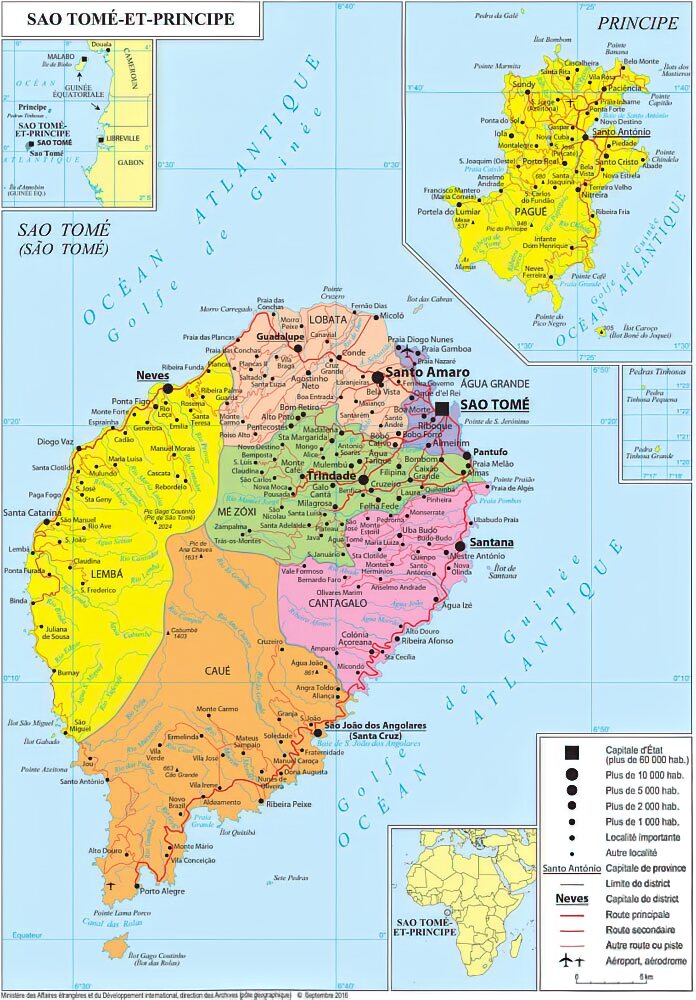
We had a later departure this morning, 11:15, which gave us time to recover a bit, but Judy did not feel well enough to go on the excursion. I went by myself.
We are using the tenders to go between the ship and dock this morning. One of the tenders returning to the ship. I took this from the restaurant while we were having breakfast.

After gathering in the theatre and getting a ticket, we boarded the tender. Although the sea was fairly calm, the tender was bouncing up and down quite a bit. It was interesting getting aboard:-)
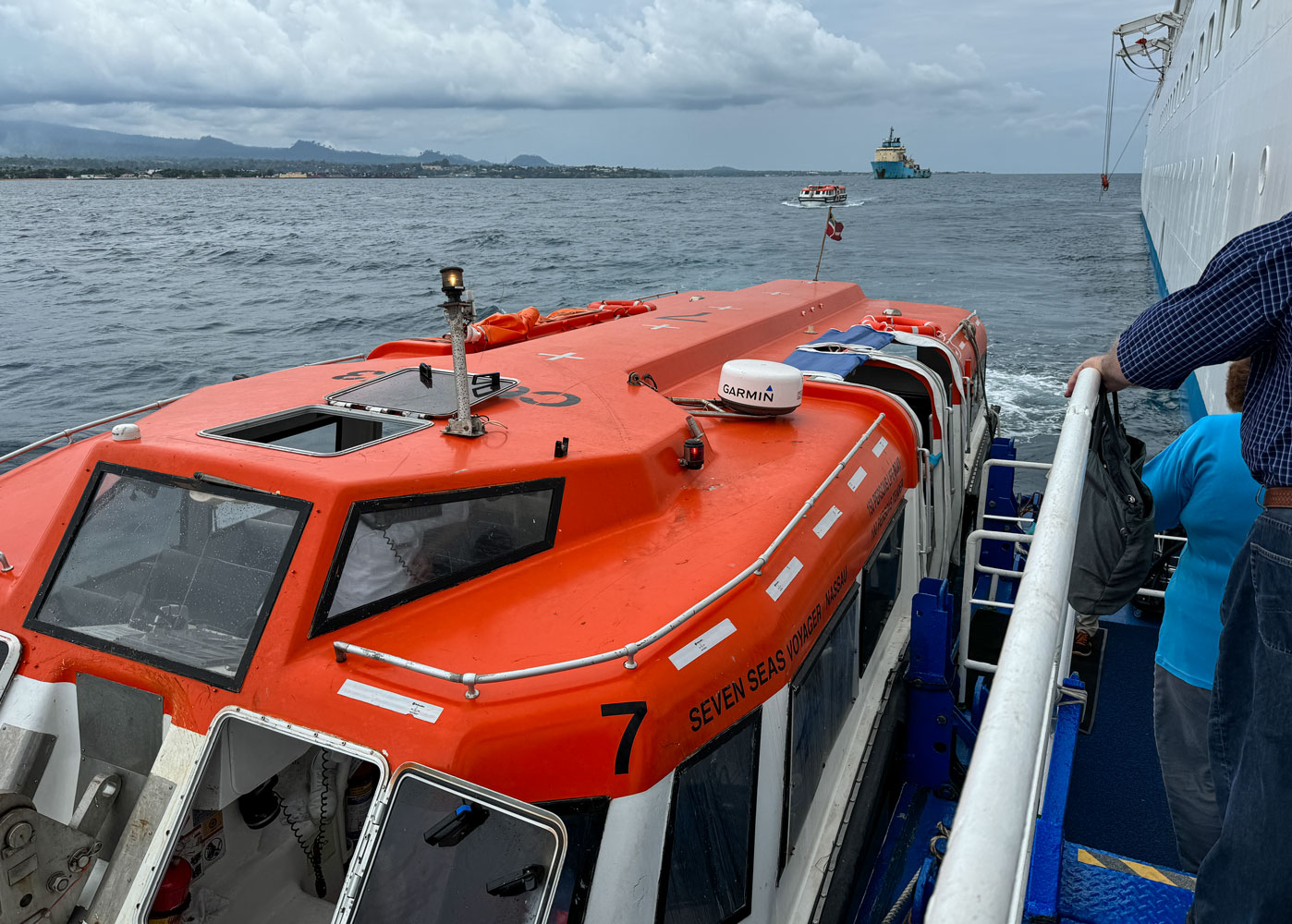
The buses were waiting, and we boarded. It's a smaller bus.
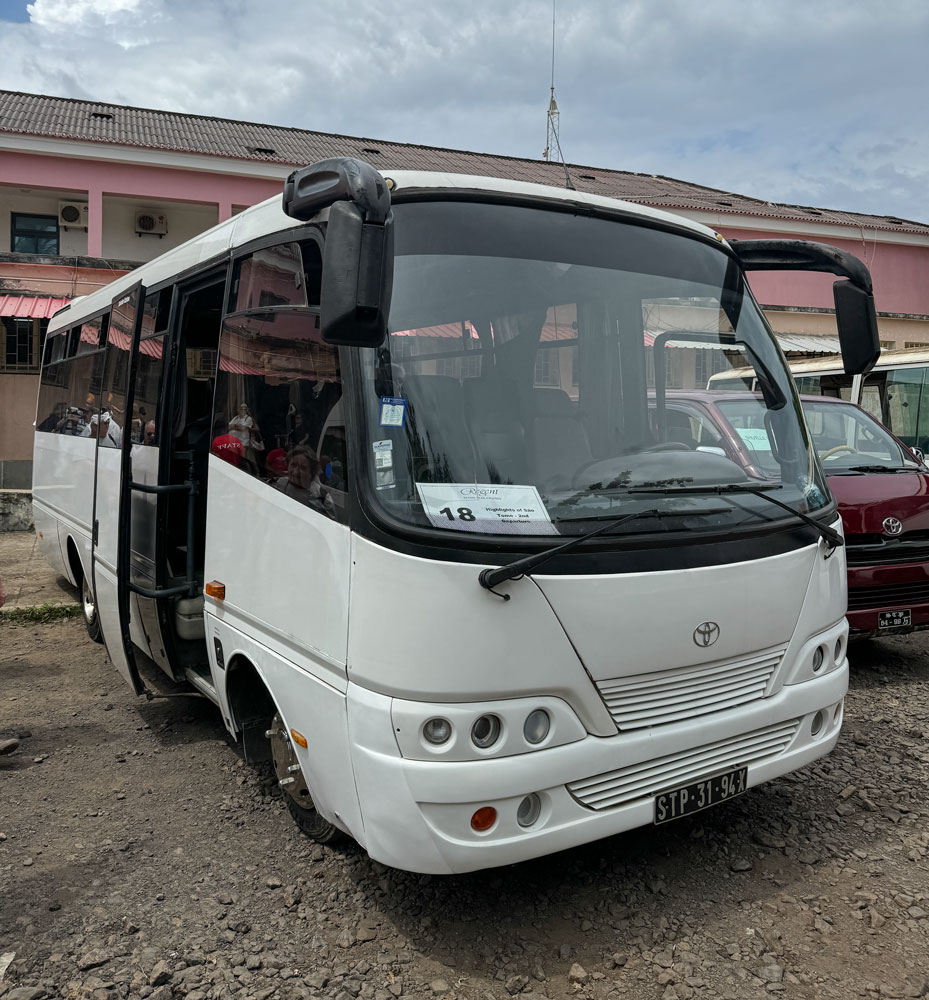
As we left the dock area it was obvious that São Tomé is a poor country, but perhaps a bit better maintained than Ghana or Togo.
They took us first to the town of Pantufo, and Igreja de São Pedro (Church of Saint Peter) where a group of musicians and dancers were gathering.
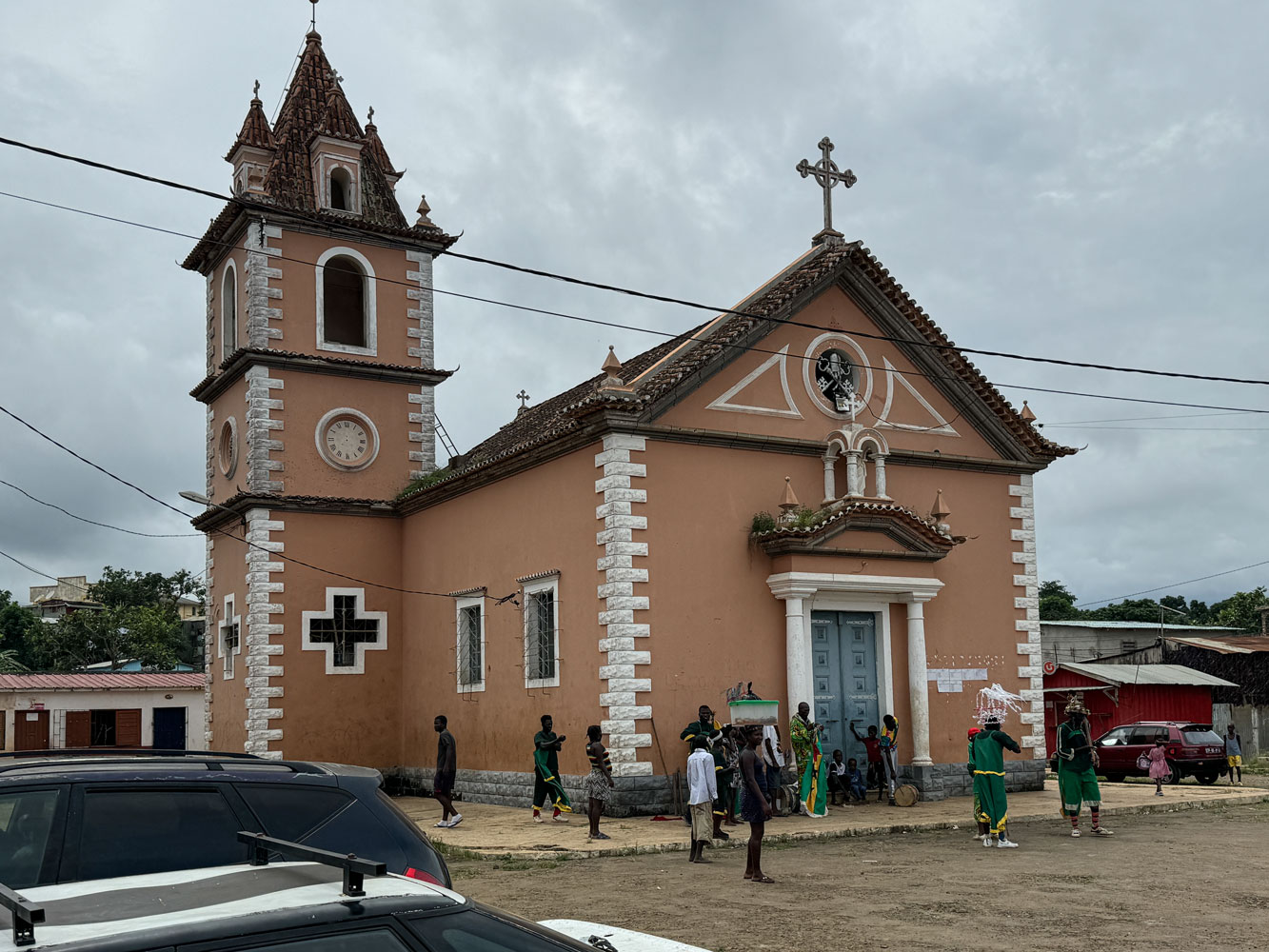
They eventually got organized and began their dance.
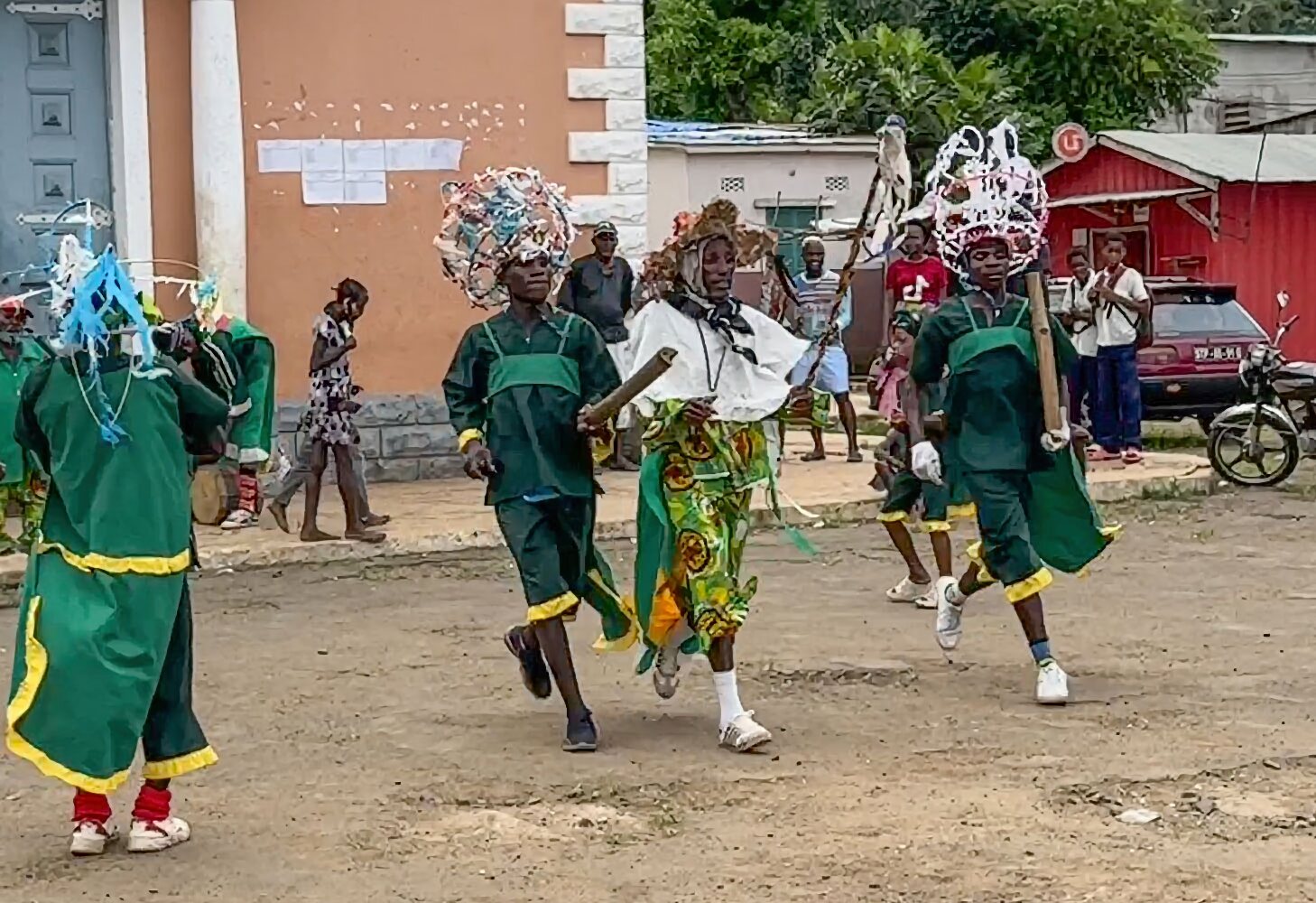
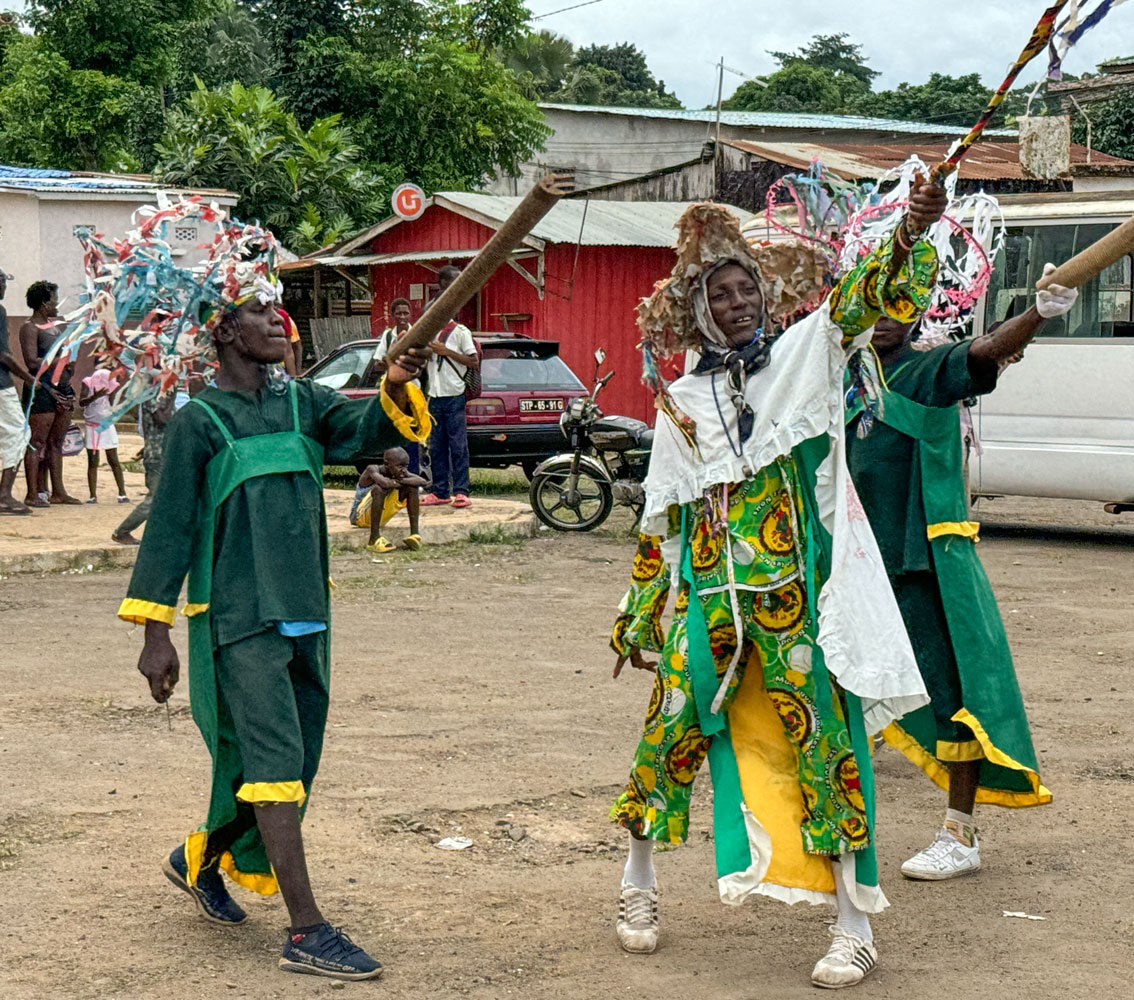
I don't know if there was some symbolism to the dance. The tour guide didn't give us any information.
Then they took us a bit further into Pantufo where a woman was selling grilled fish in the shade of a tree. Here, the guide is purchasing some fish for us to sample. I'm not really a fish eater, so I passed.
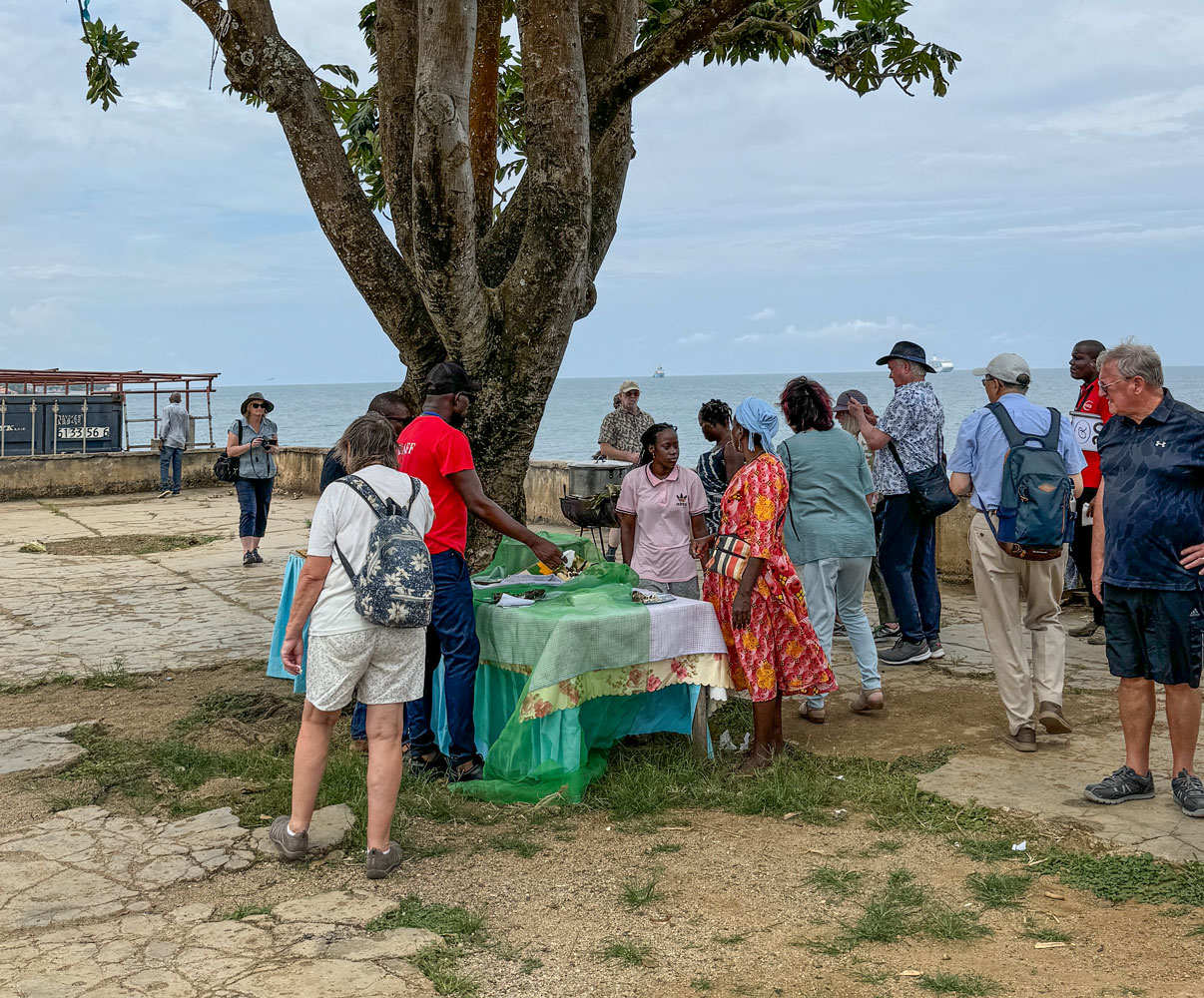
The grill with the fish.
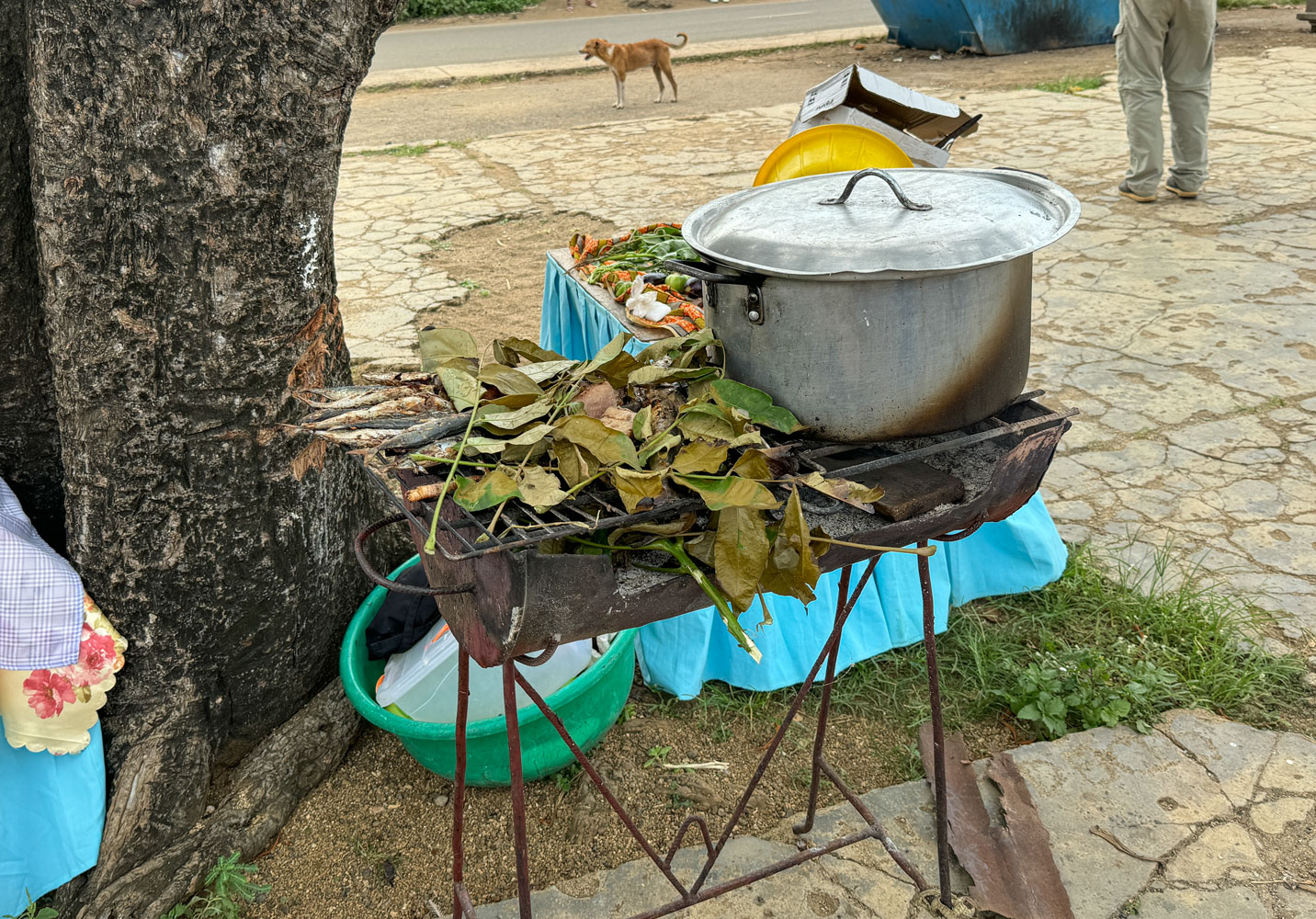
And a closer view.

From here, we went back to the city of São Tomé and Our Lady of Grace Cathedral.
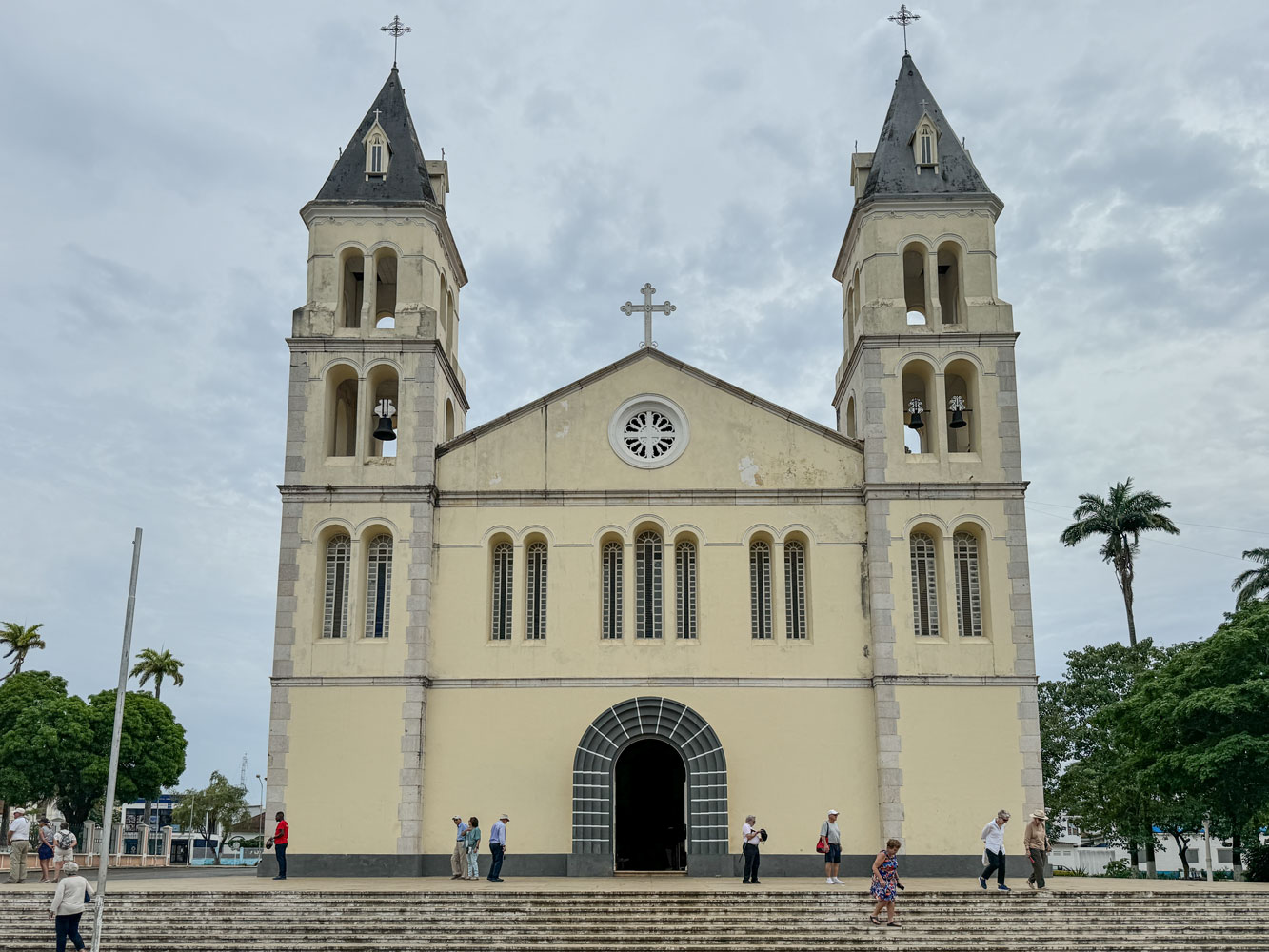
A view inside the cathedral.
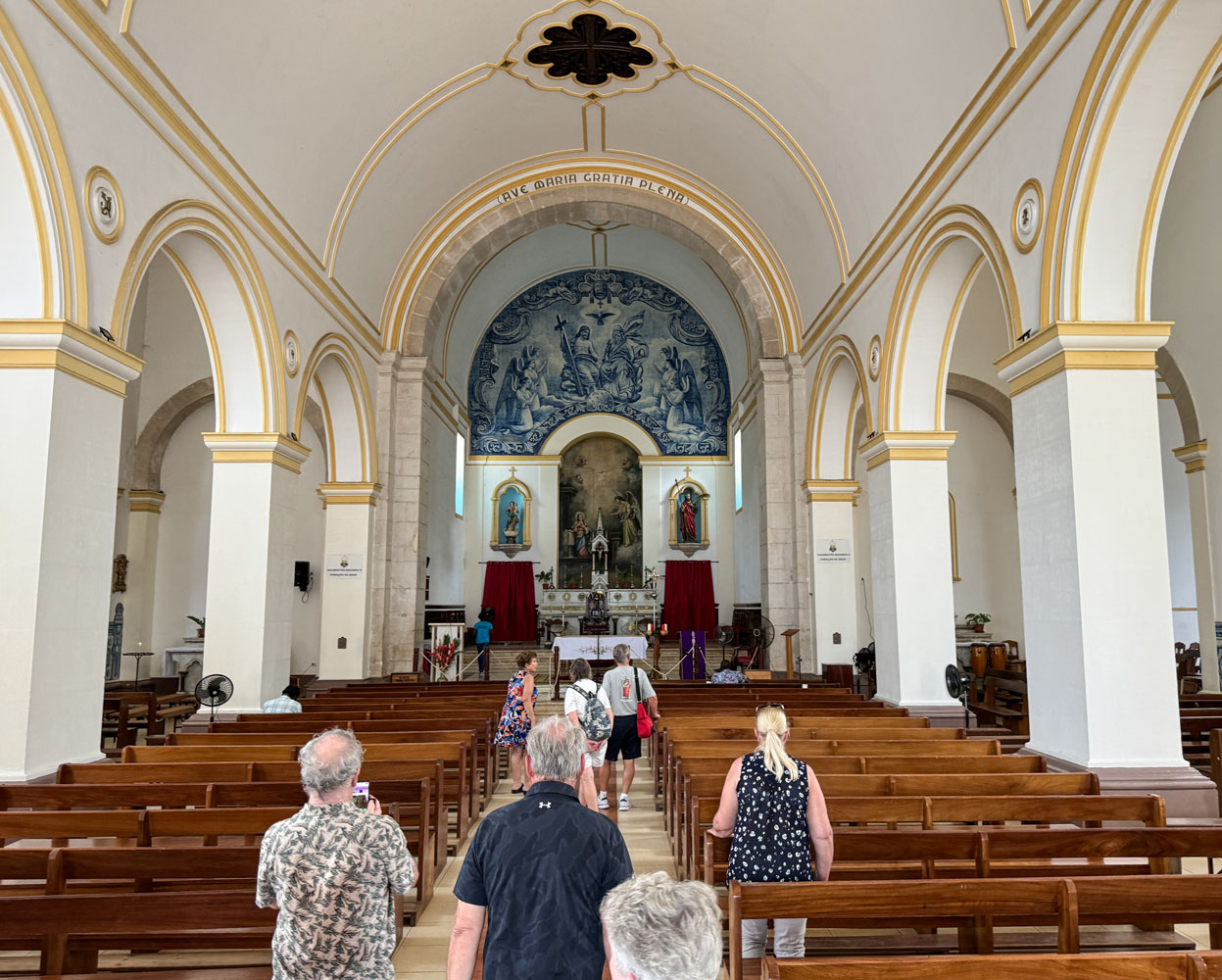
A closer view of the altar area.
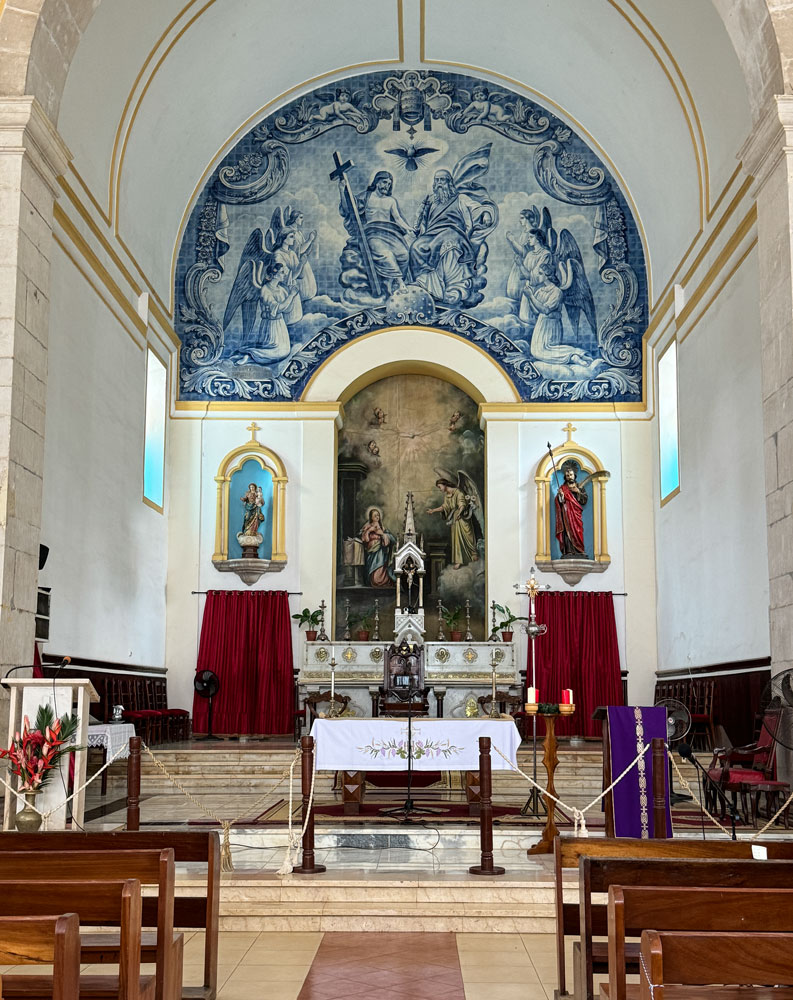
Nearby was the Presidential Palace. I learned later that you were not supposed to take pictures of the palace, but I had already done so.
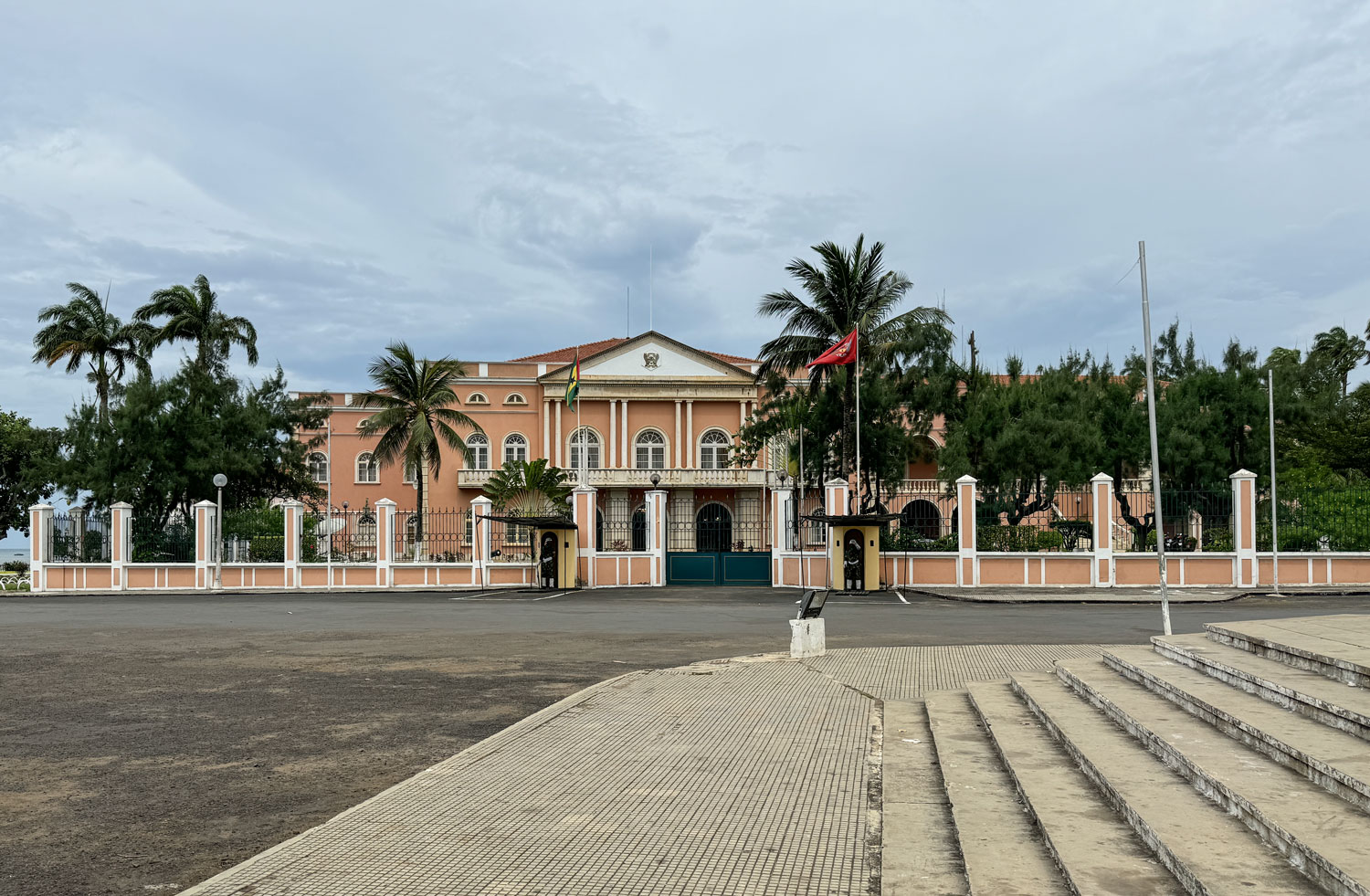
From the Cathedral we walked toward the Praça da Independência. We stopped at a very high end shop near the plaza. It was way out of place, for the neighborhood.
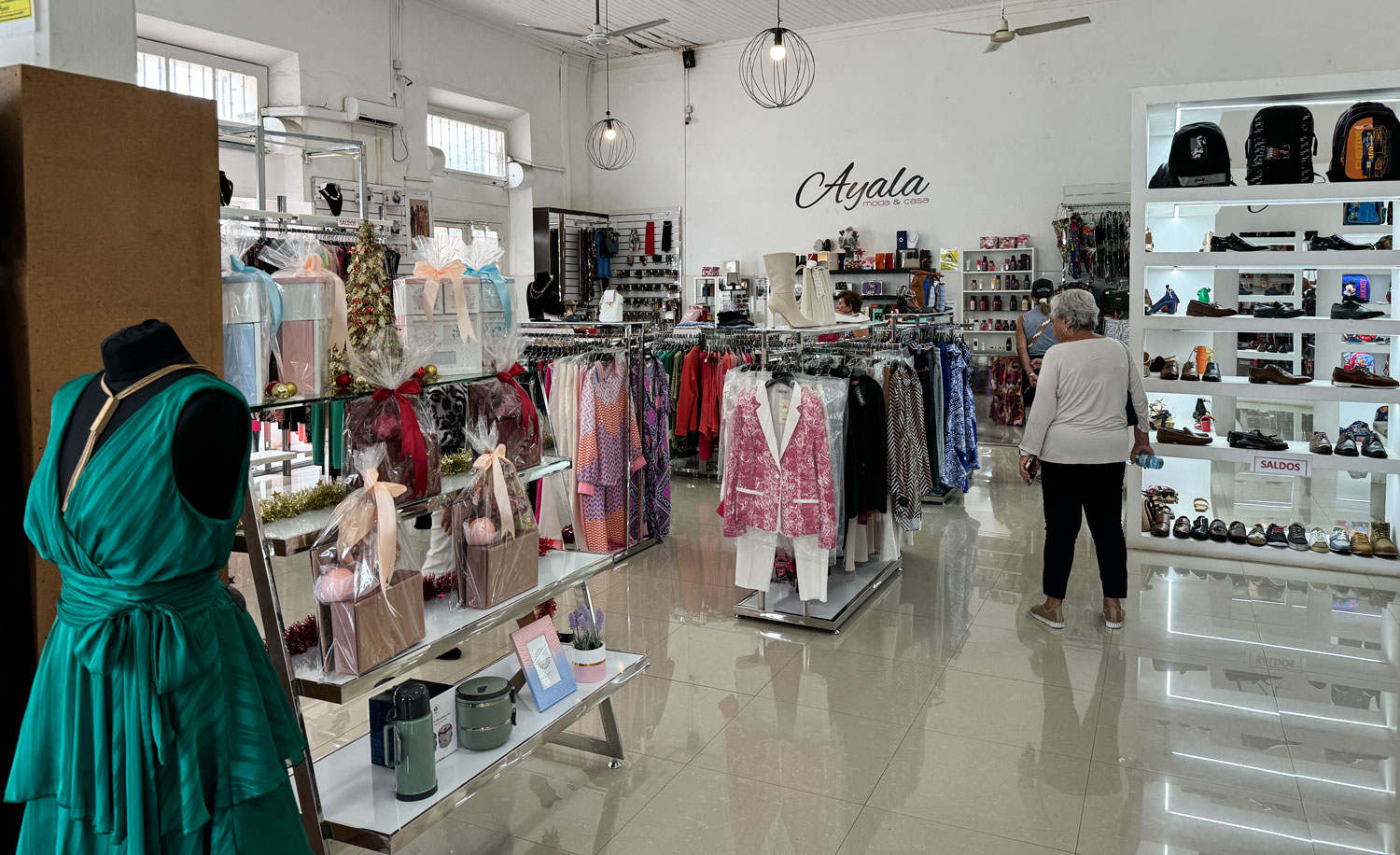
Across the street was the Plaza, and there was a group of dancers performing in the plaza. Again, I don't know what the dance was suppose to symbolize - whether there was a story behind it - but it went on forever. The dancers appear to be dressed as certain characters in a story or a ceremony.
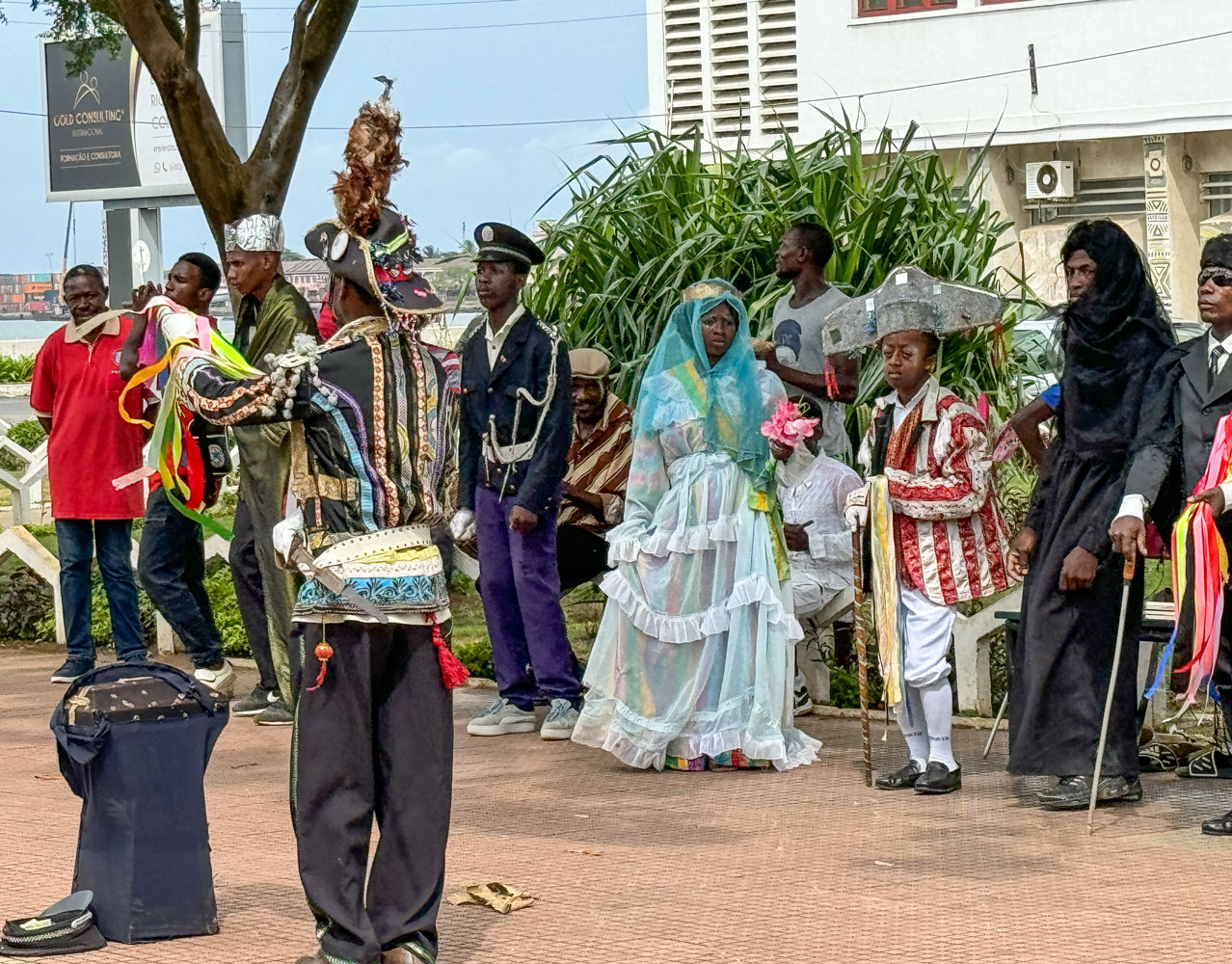
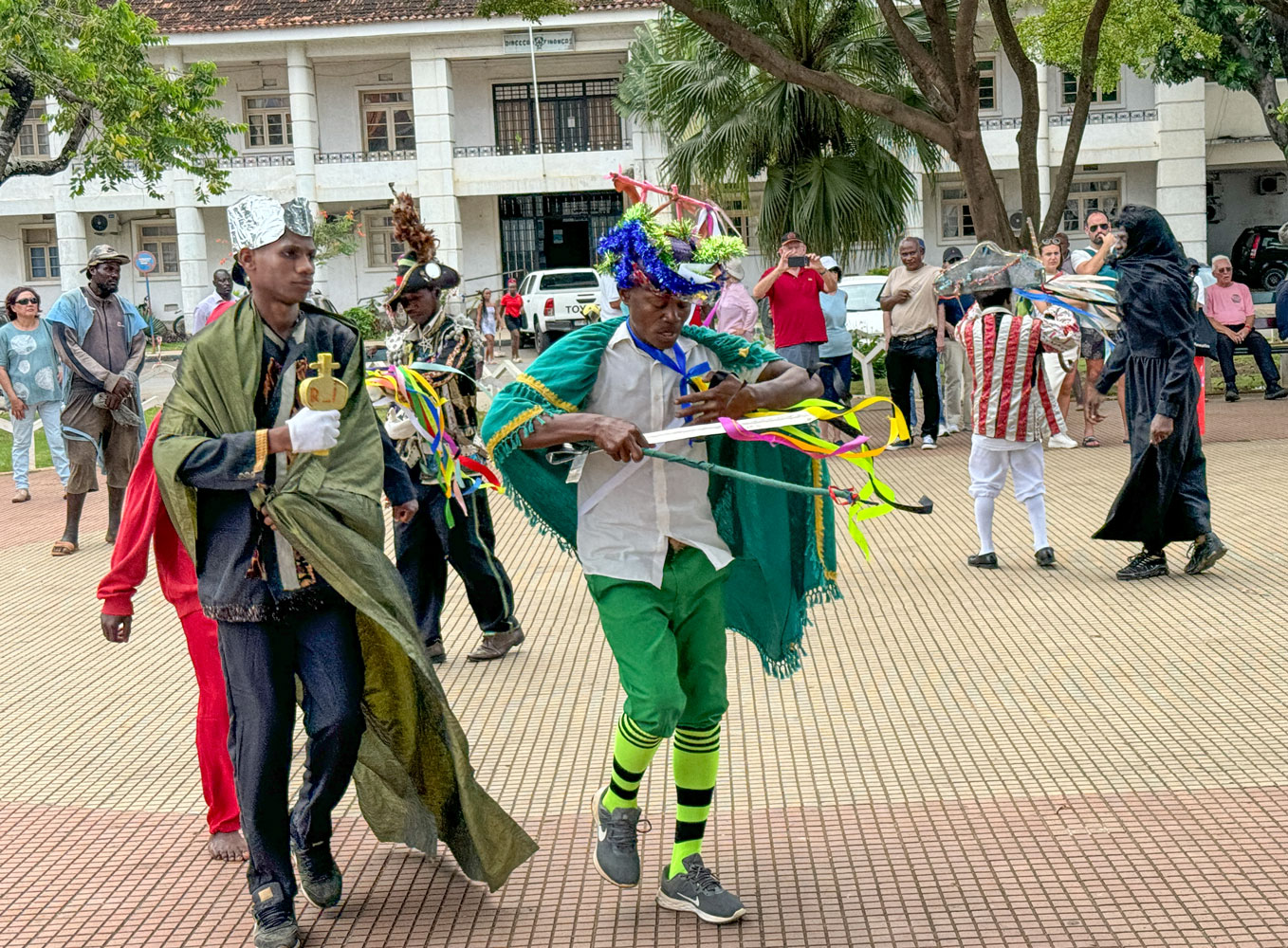
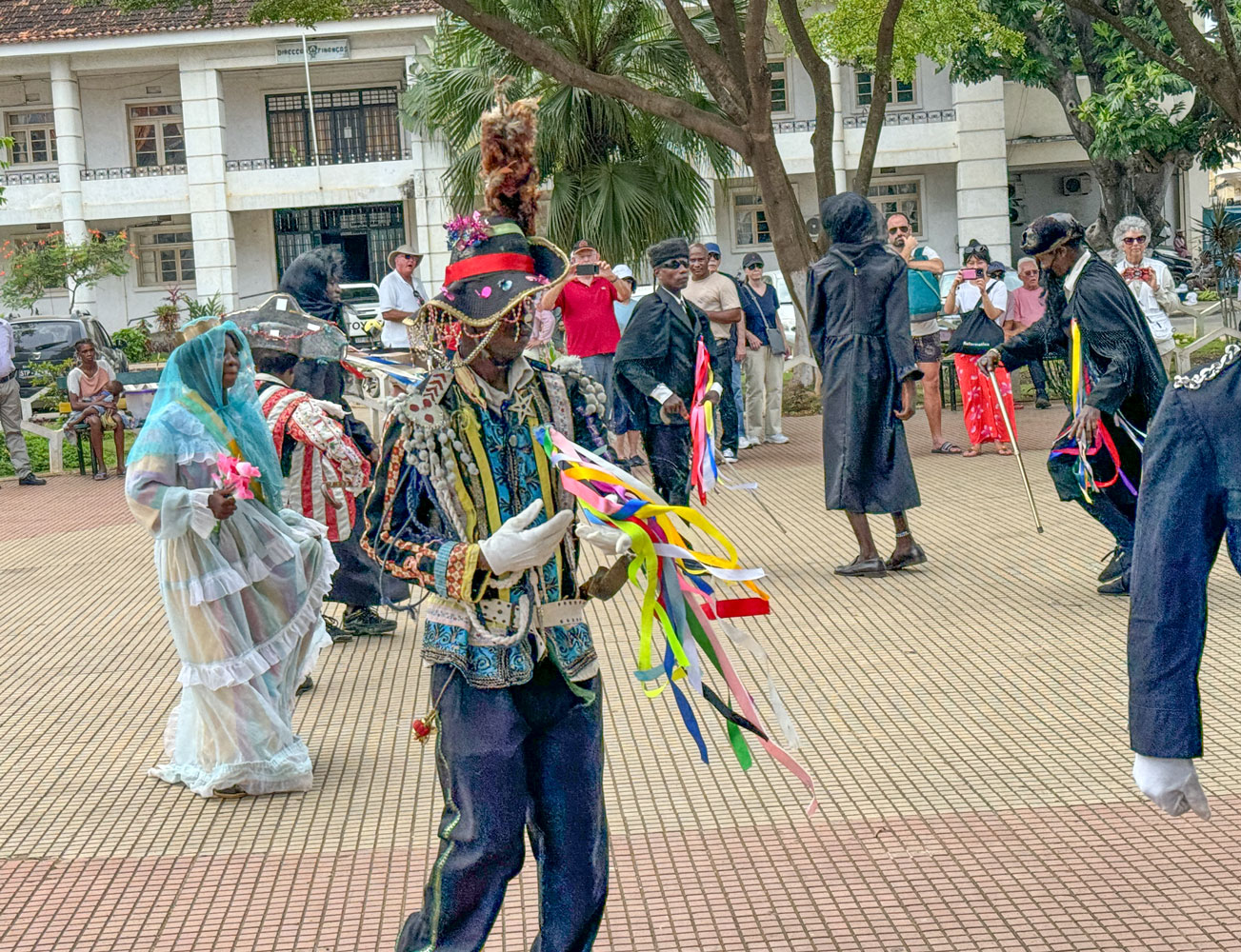
Next, we went to the most interesting place on the excursion - a chocolate shop!
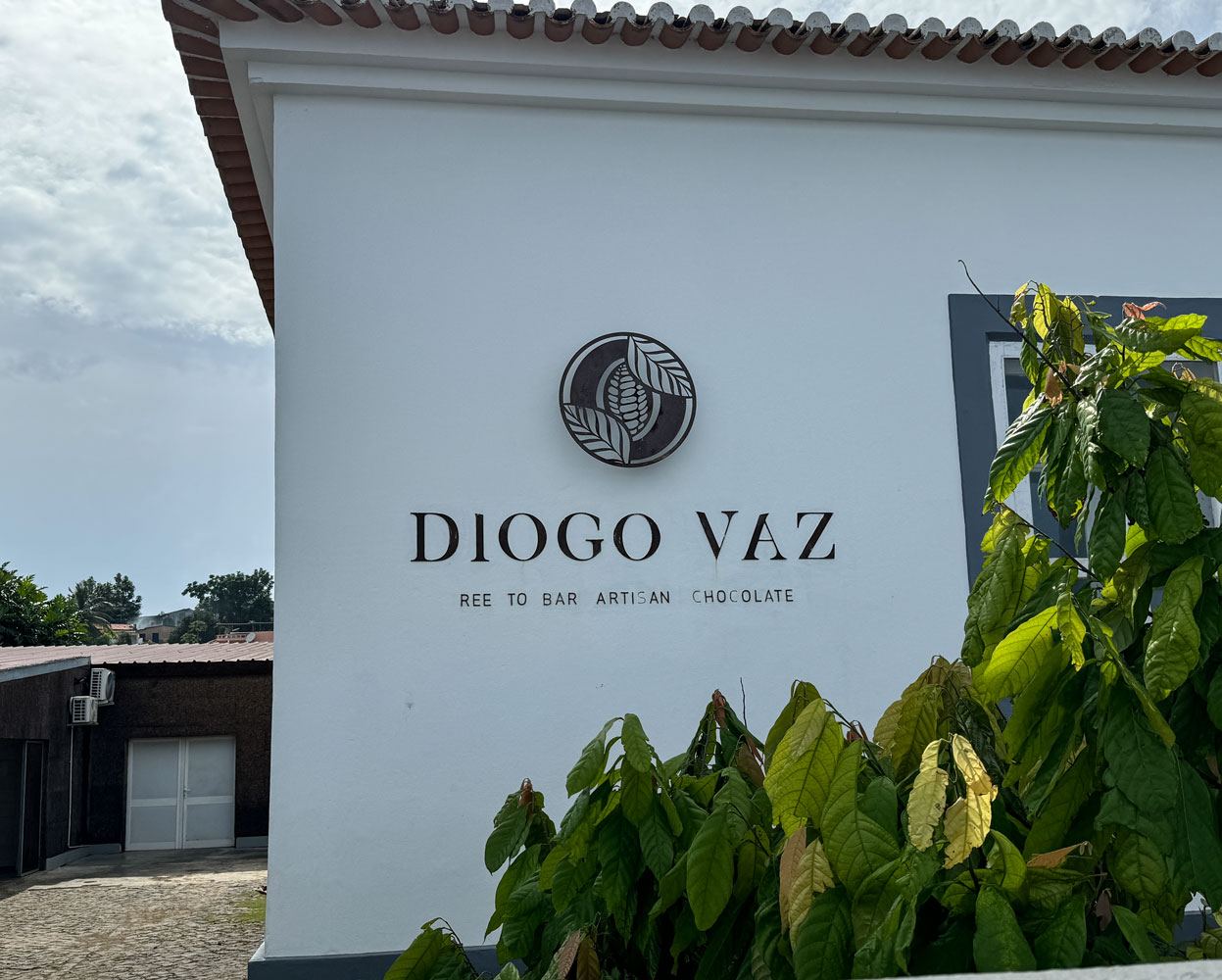
They were sampling four different kinds of their bar chocolate - a 70%, two 75%, and an 85%. The 85% was too bitter for me, I really preferred the 70%.
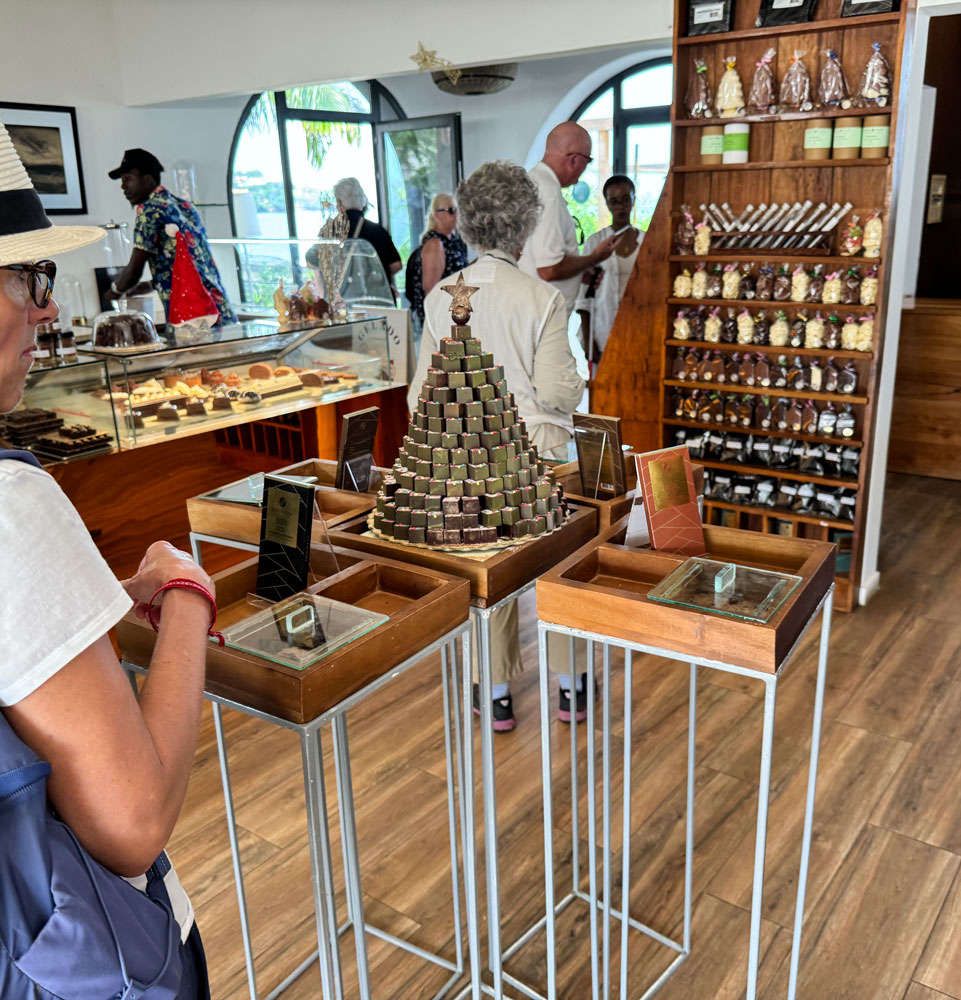
This gal was helping us select chocolate. She spoke English with almost no accent.
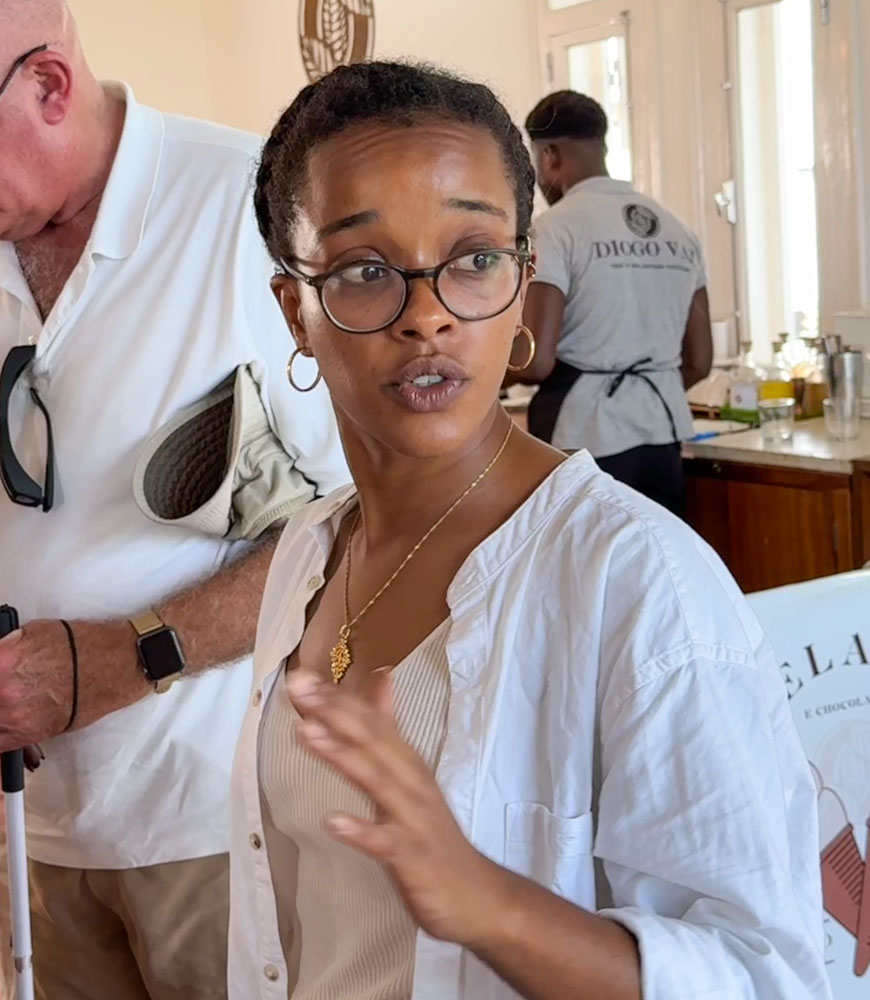
Of course, I had to buy a few bars of the chocolate - I'm a sucker for a pretty face. I got one bar of the 70% and one each of the 75%'s.
As the last event of the tour, we went to the São Sebastião Museum. It was built as a fortress by the Portuguese in 1566 and was converted into a museum. There's a lighthouse associated with the museum.
The entrance is the doorway in the center of the picture.
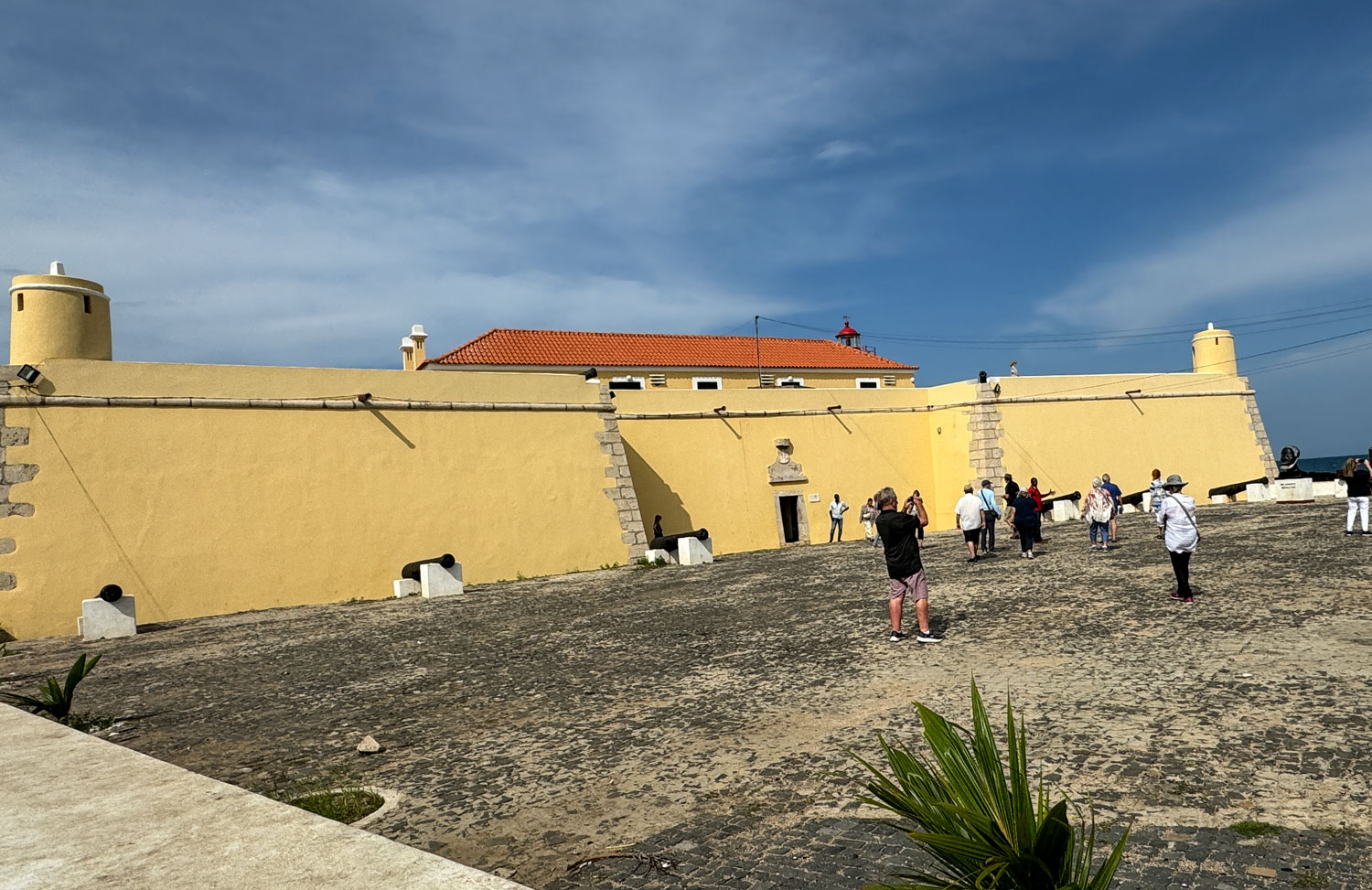
The fort is built with a central courtyard, with two stories of rooms around the courtyard. This stairway leads to the rampart, showing the lighthouse.
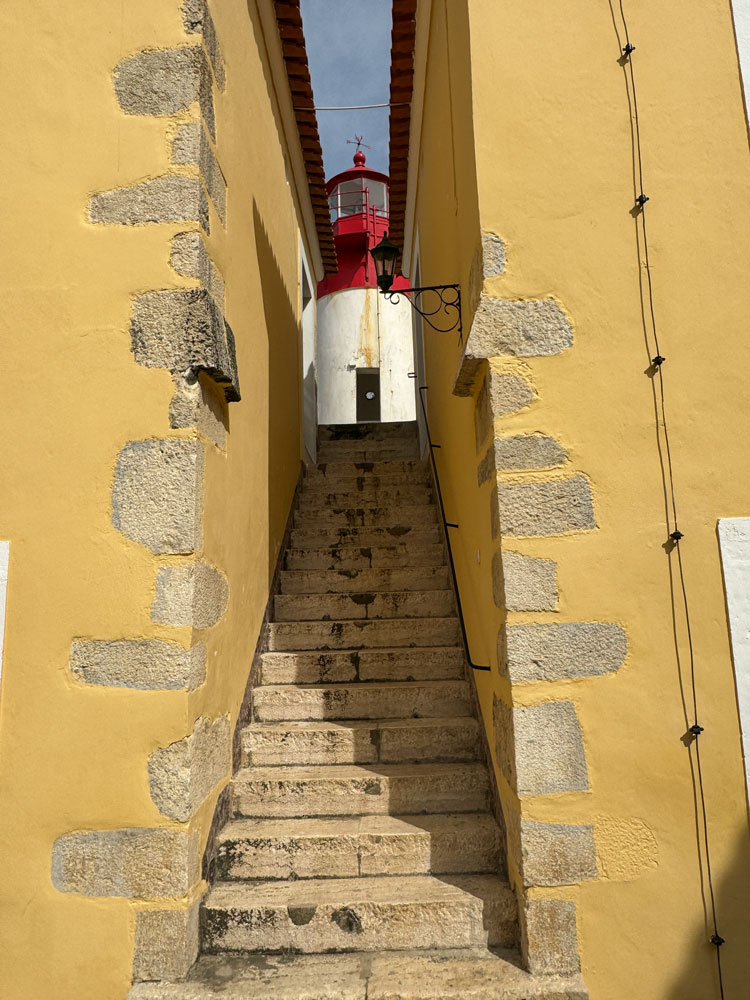
As I turned around, there were Sue and Eric coming down the stairs on the other side of the courtyard. They were on a different tour and were also finishing at the museum.
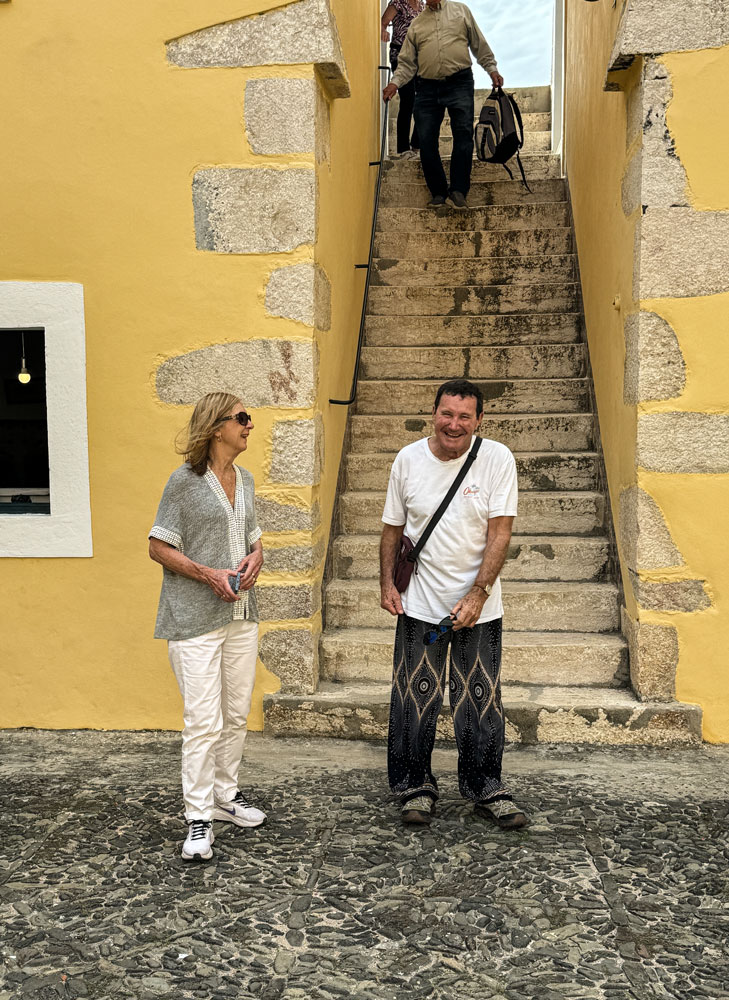
A few exhibits in the museum. A table and dishes used by the officers of the fort. The dishes were made in England. The white panel in the background is not a movie screen. It's a panel that was moved by a worker to provide a breeze for those dining.
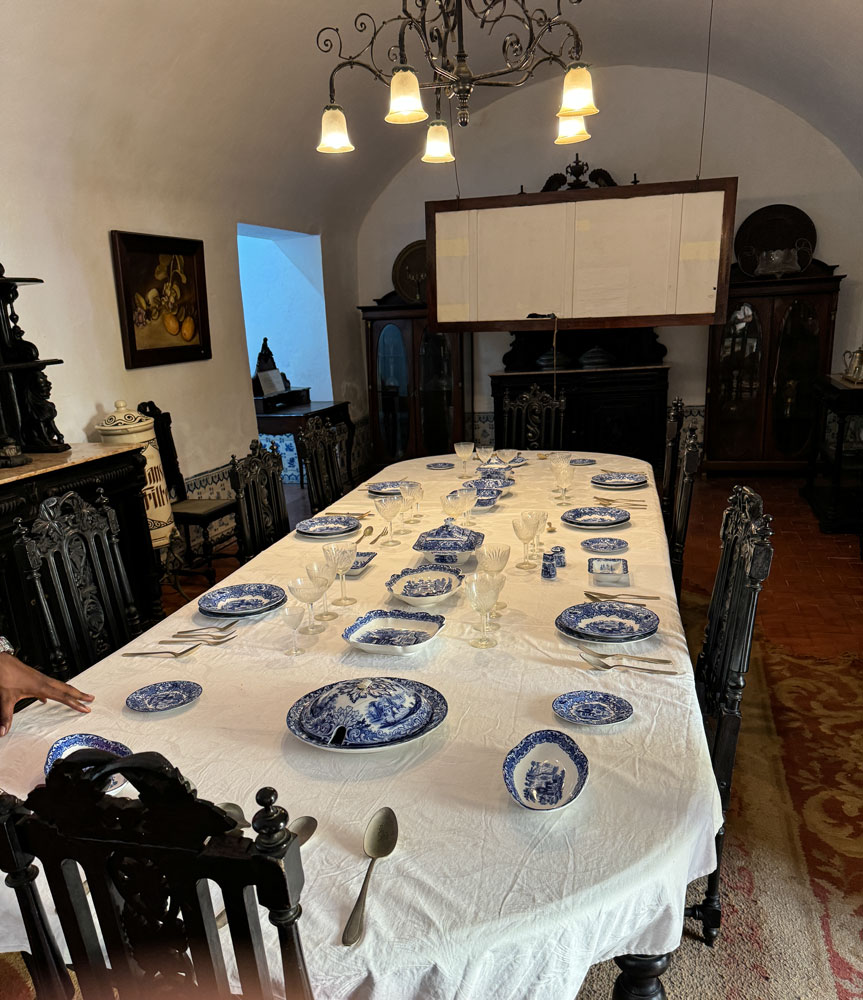
I was told that this strange piece of furniture had something to do with wine. I'm amazed at what the craftsmen of that time could build - this is exceptionally fine work. I don't know where it was built, perhaps England or Portugal.
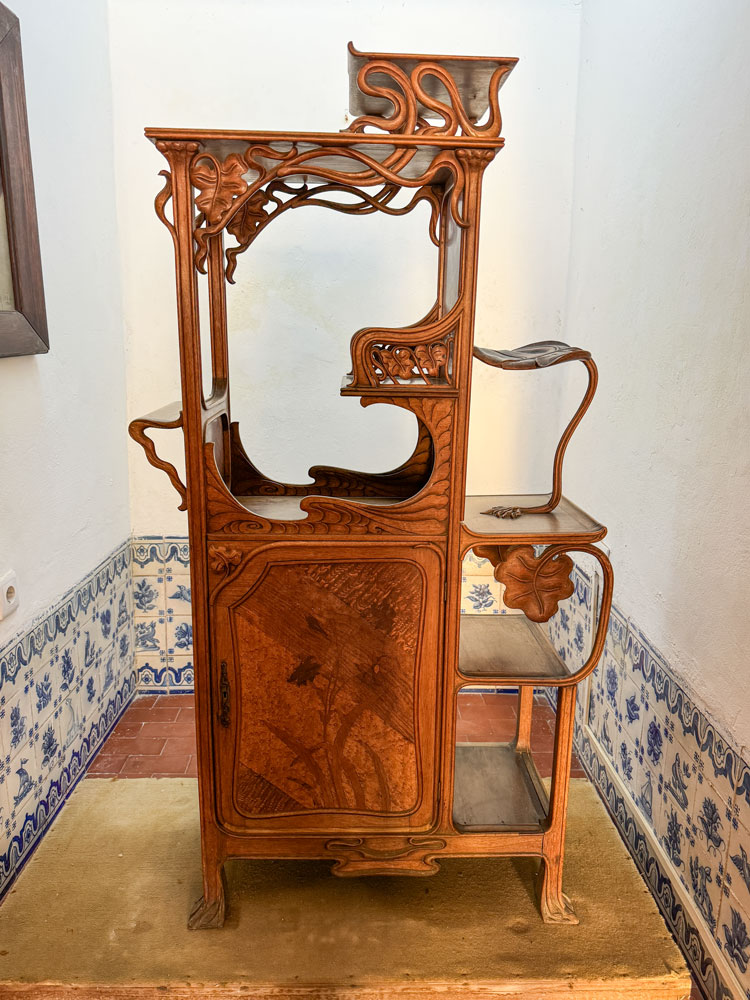
I climbed the stairs to the rampart. There was a nice view all around.

We returned to the dock, and the tender was just arriving.
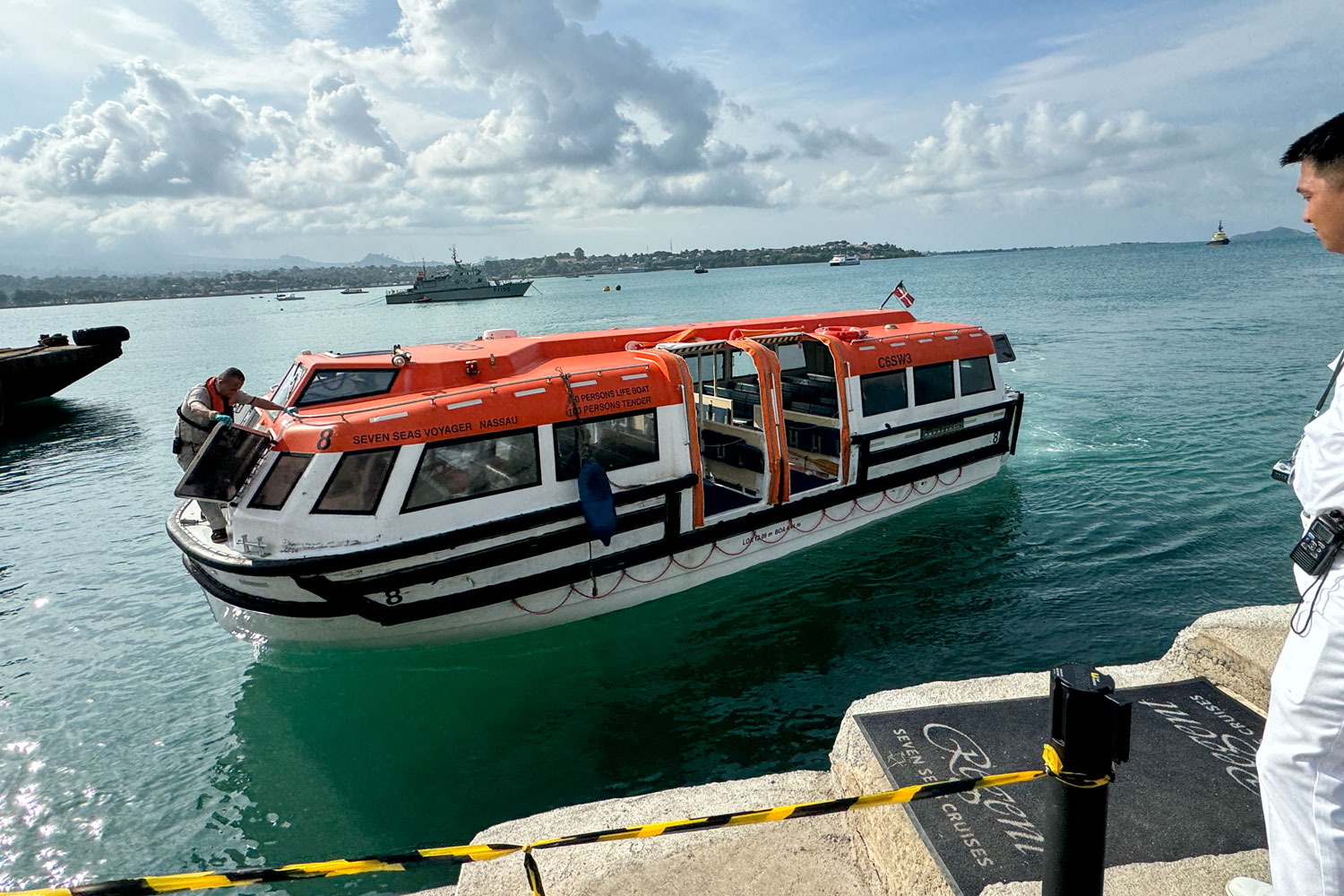
Leaving the port gave a good view of the museum/fort.
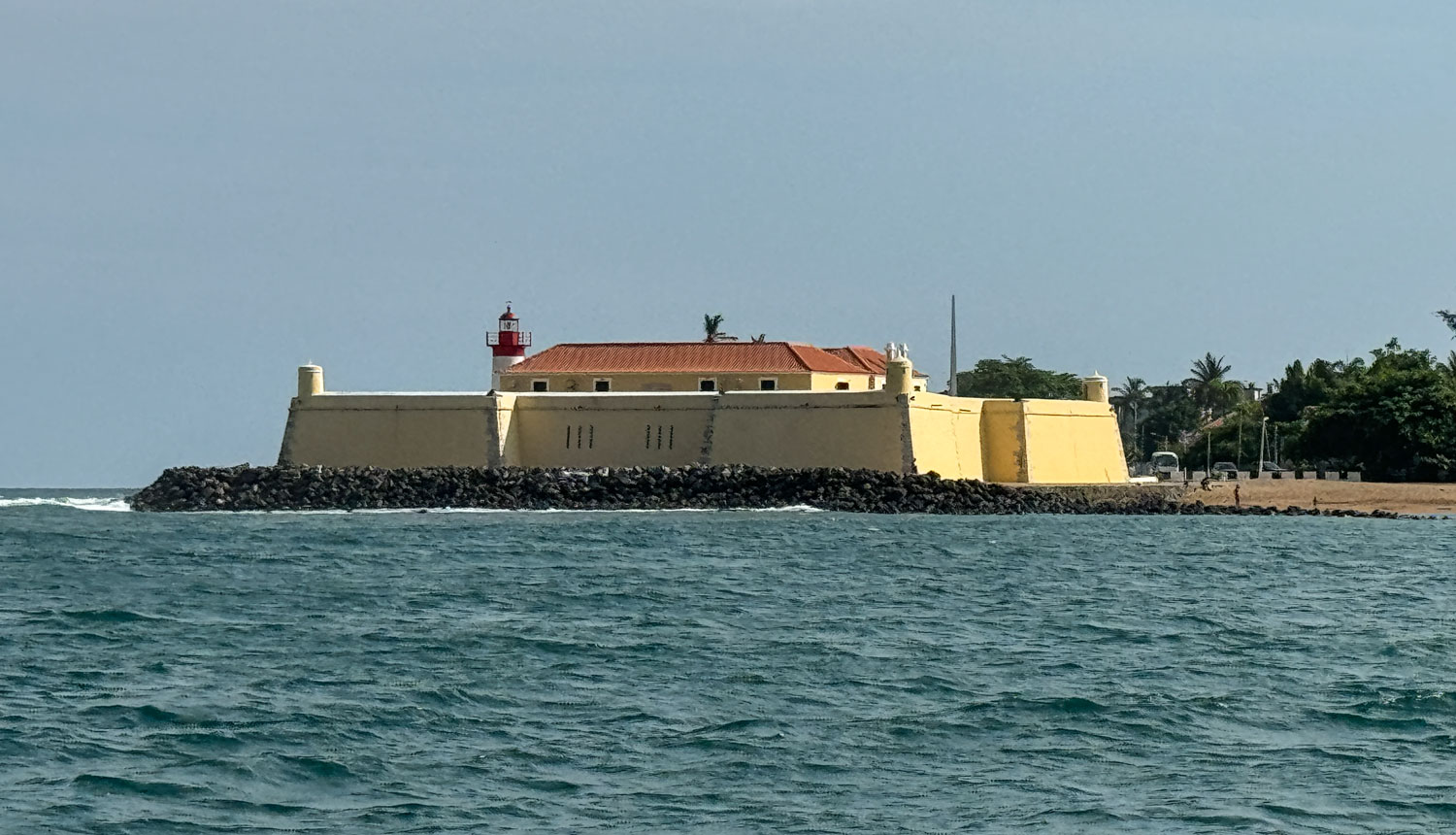
The ship weighed anchor at 4pm, and we sailed south. We met in the theater to play trivia. If all had gone as planned, we'd cross the Equator about 5pm. and that's when King Neptune's Court was scheduled. We were actually a bit late, but King Neptune still had his court at 5pm. And that's the next story.
****************************
At 5pm, there was an announcement over the PA system that King Neptune had taken over the ship because there were reports that slimy pollywogs are attempting to cross the Equator without the King's permission. Due to that, King Neptune would hold a court to judge these slimy pollywogs, and if they were found worthy, they would be promoted to shellbacks.
With that, King Neptune and Queen Neptuna with their court of mermaids and mermen marched out onto the top deck, and after circling the deck, descended to the pool deck.
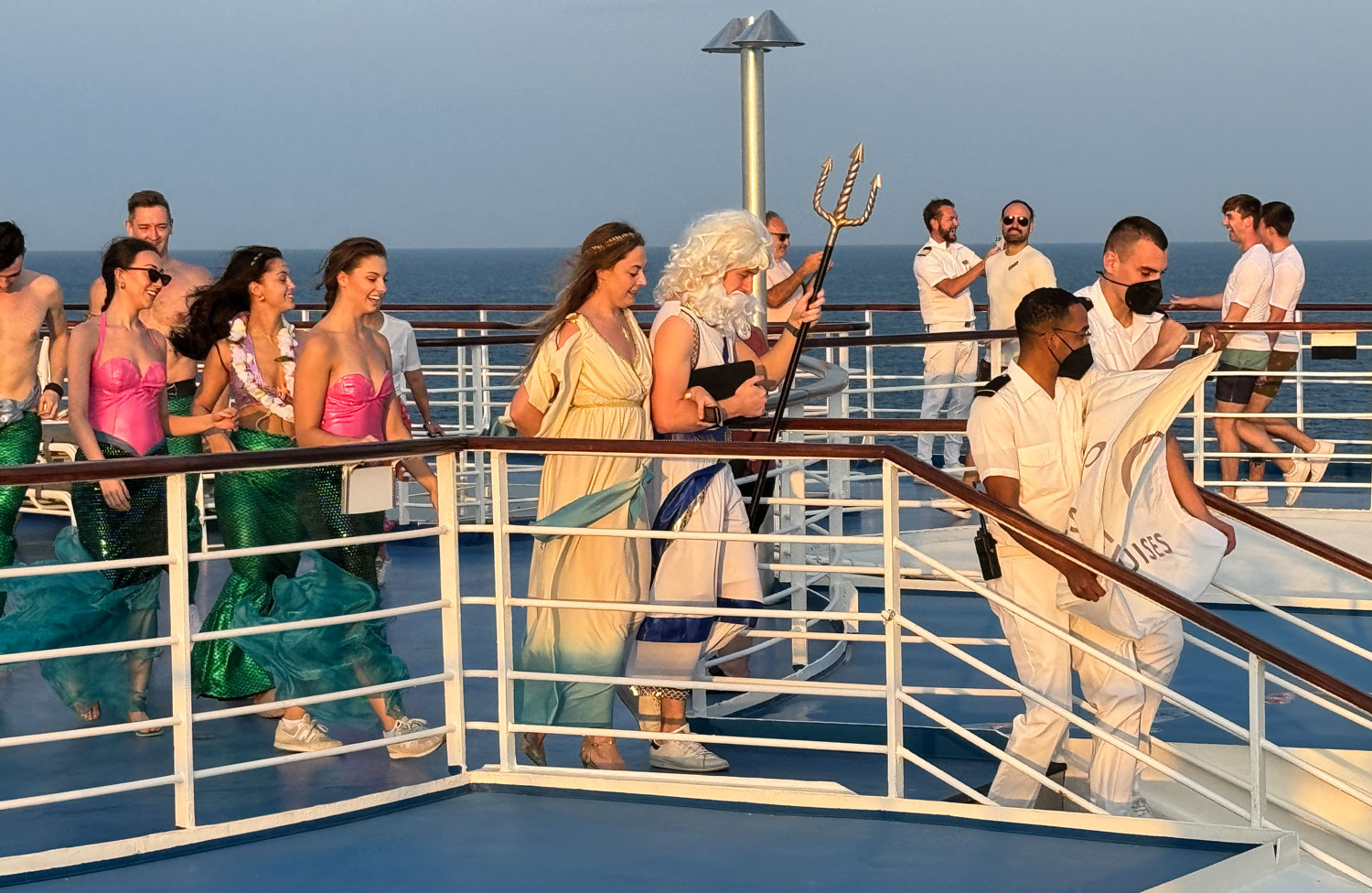
Here they are on the pool deck.
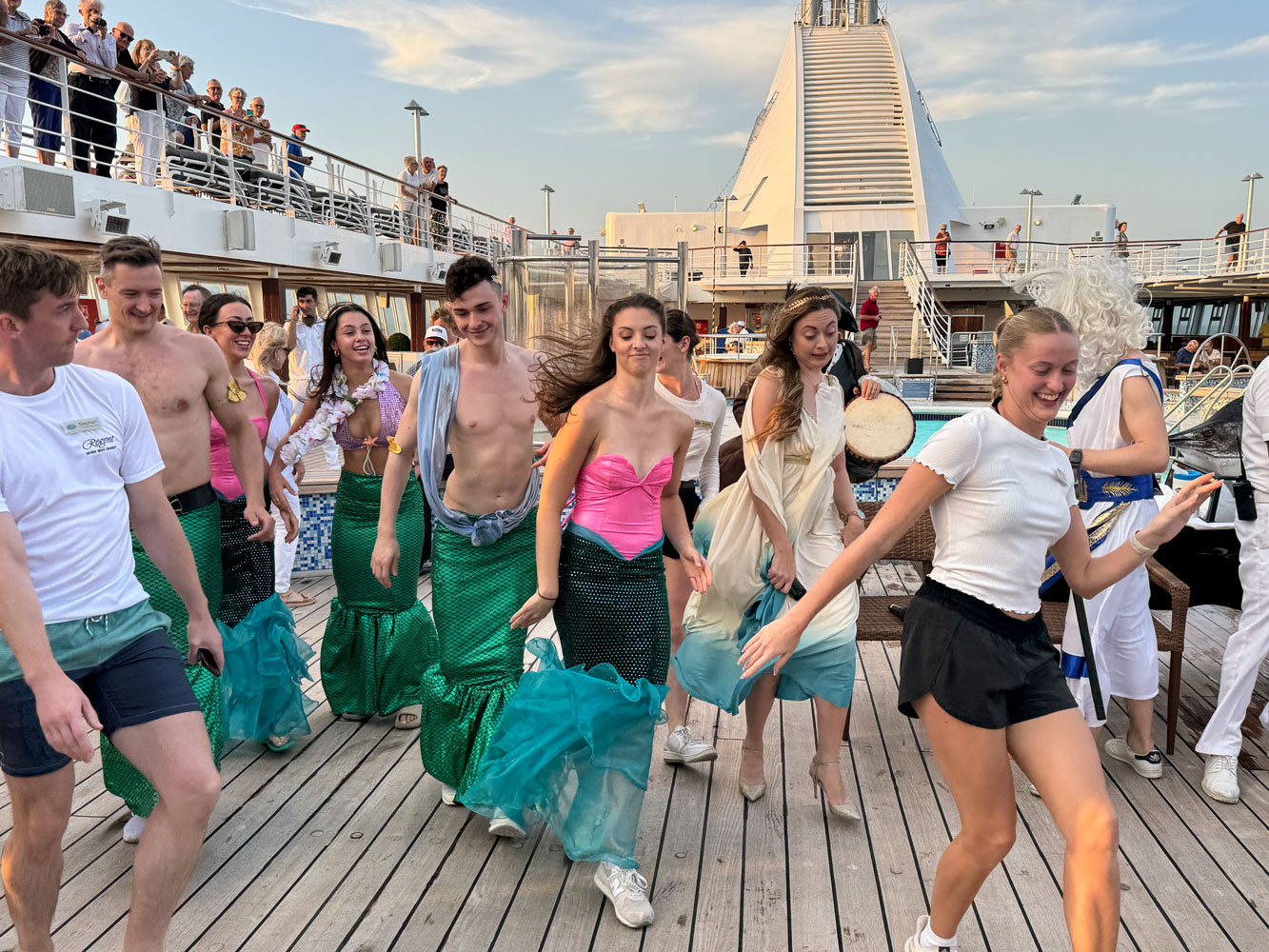
The mermaids, mermen, and pollywogs (those in t-shirts) danced for us, prior to the court convening .
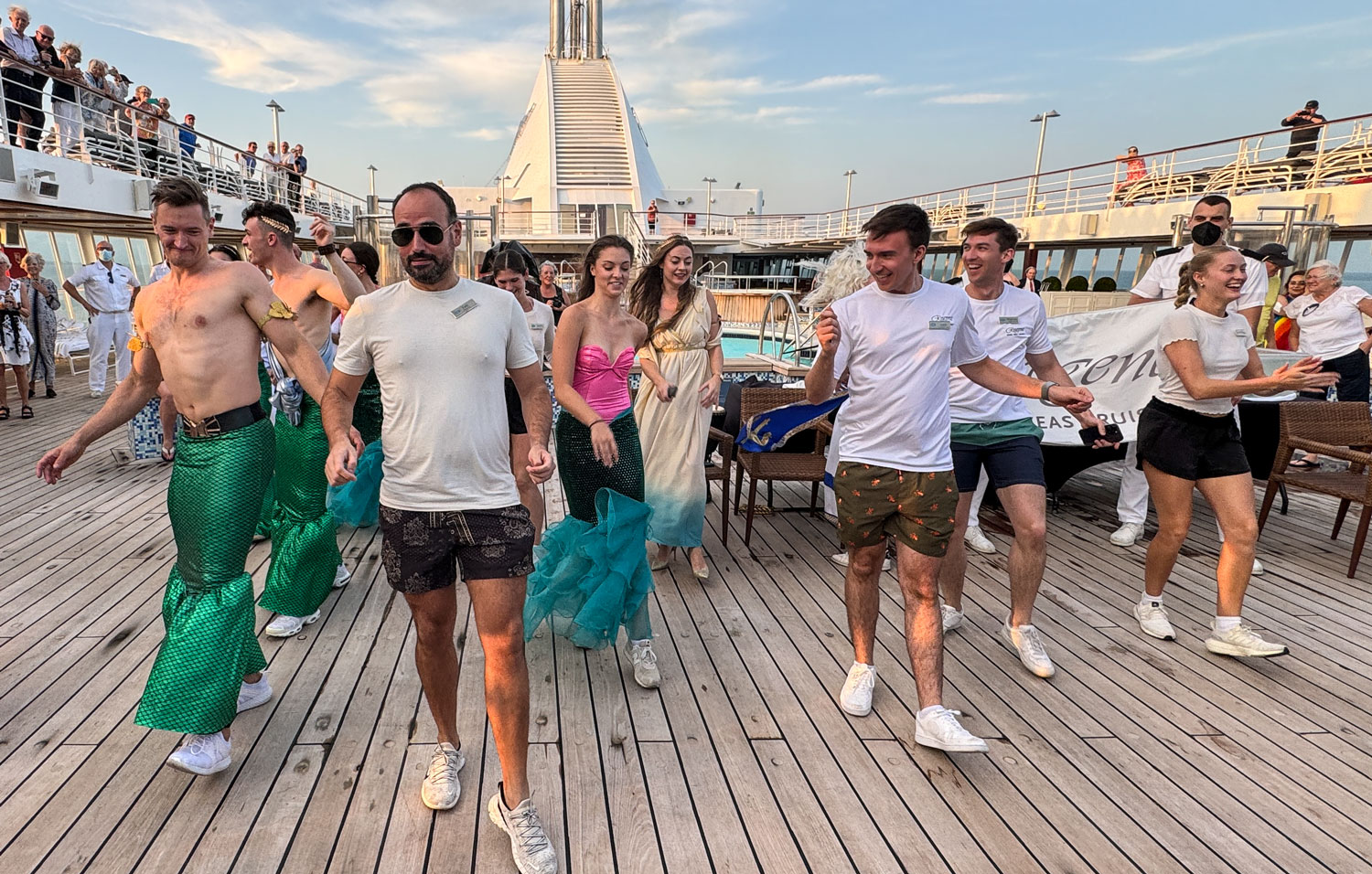
Davy Jones was there to take part in the court.
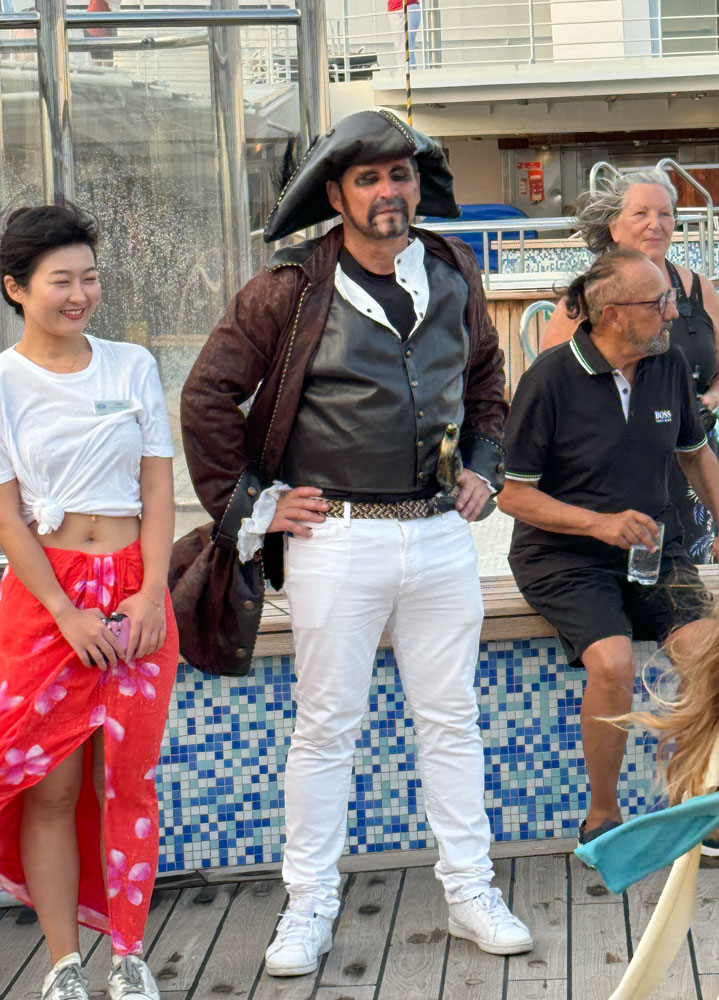
King Neptune reads the proclamation opening the court.
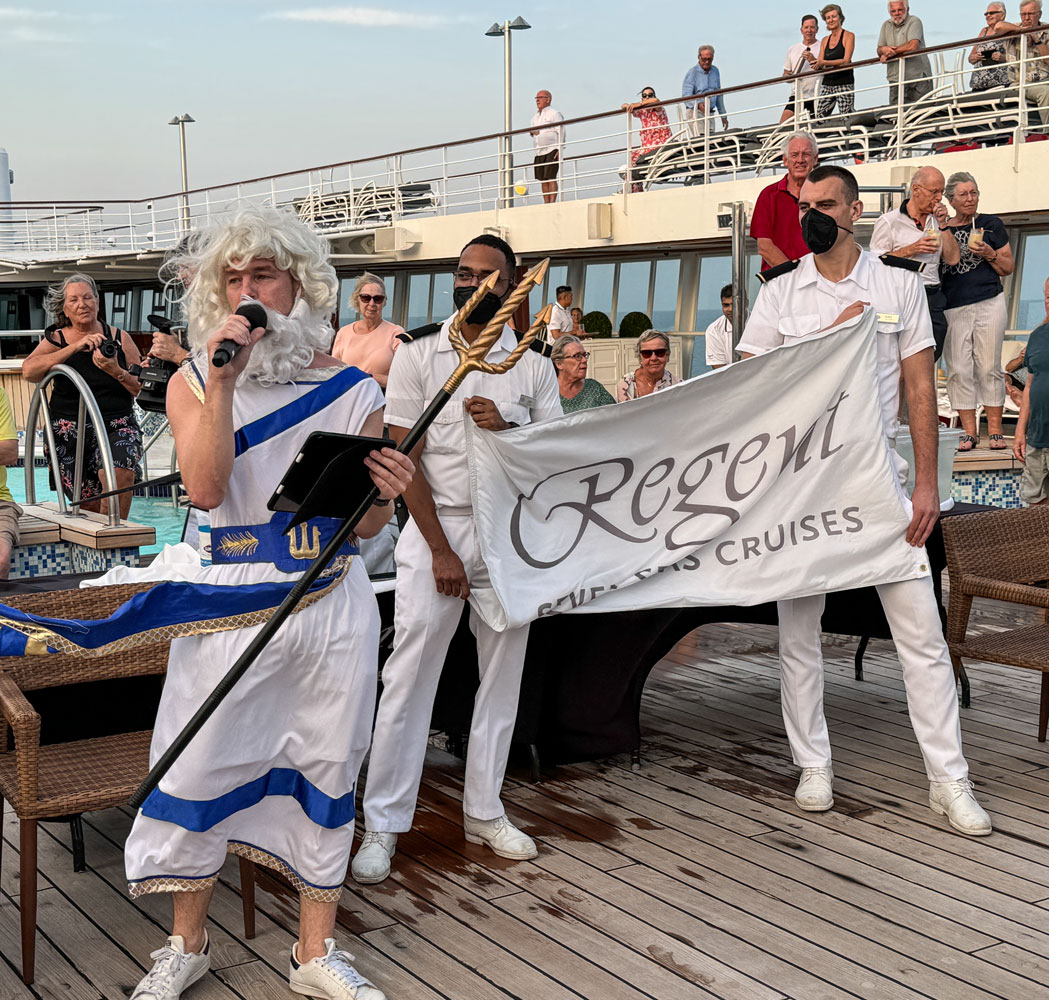
He commands all pollywogs to get down and squirm before him.
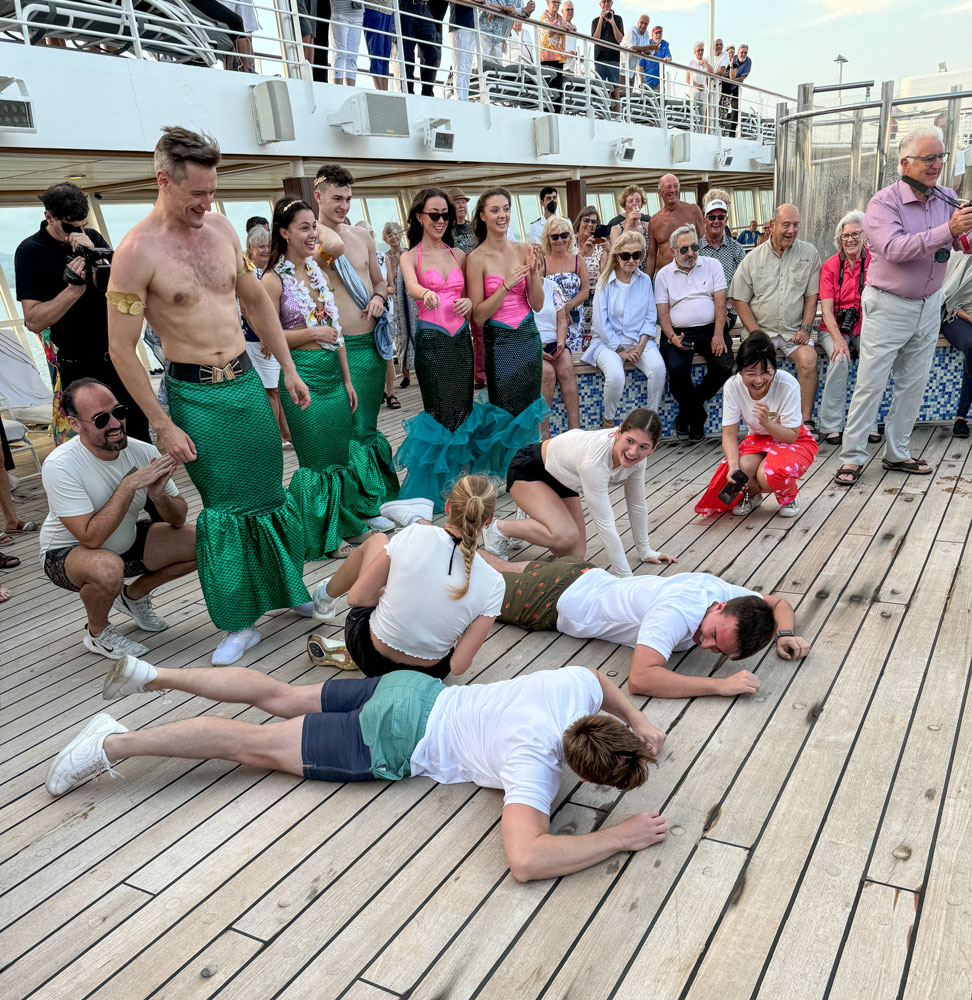
Two of the ship's officers were pollywogs. In King Neptune's court, no pollywog can escape the court's jurisdiction.
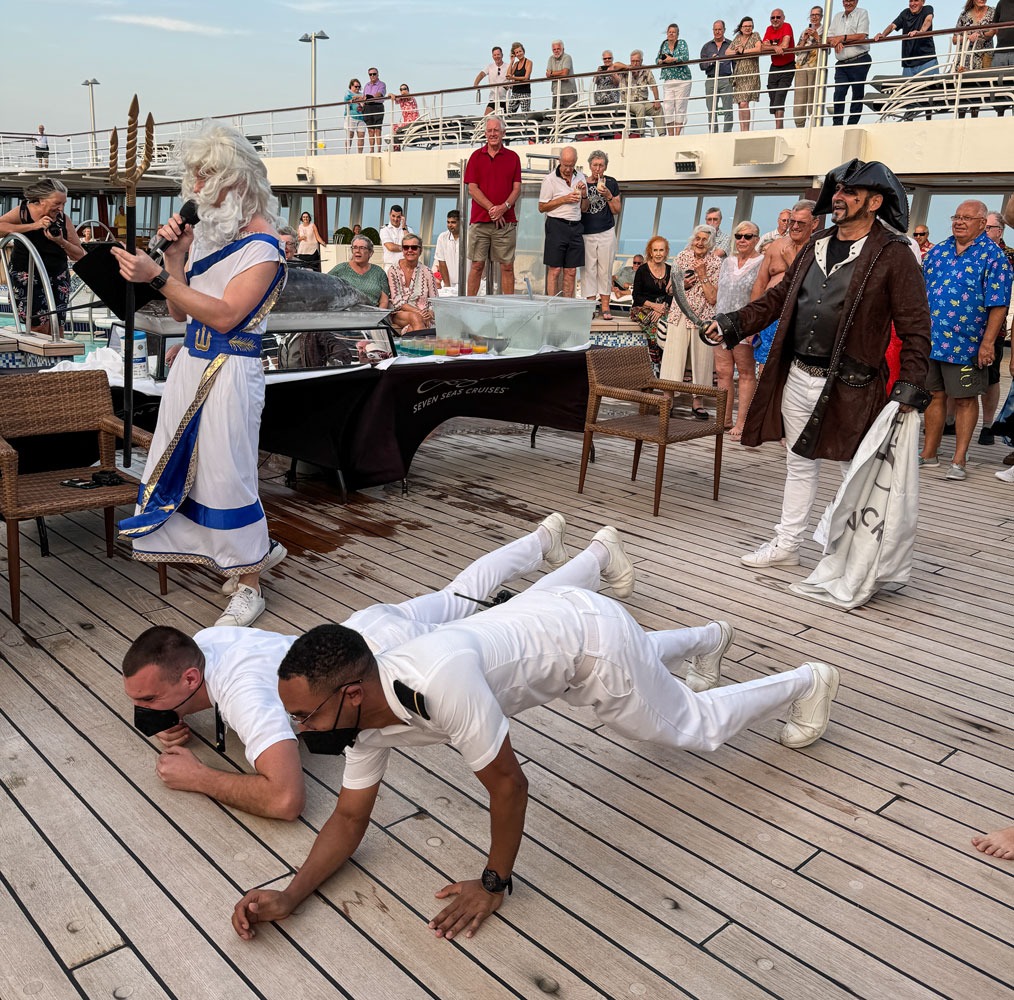
King Neptune calls the first pollywog forward. Davy Jones and Queen Neptuna look on. Note the swordfish behind King Neptune (better picture of the fish later).
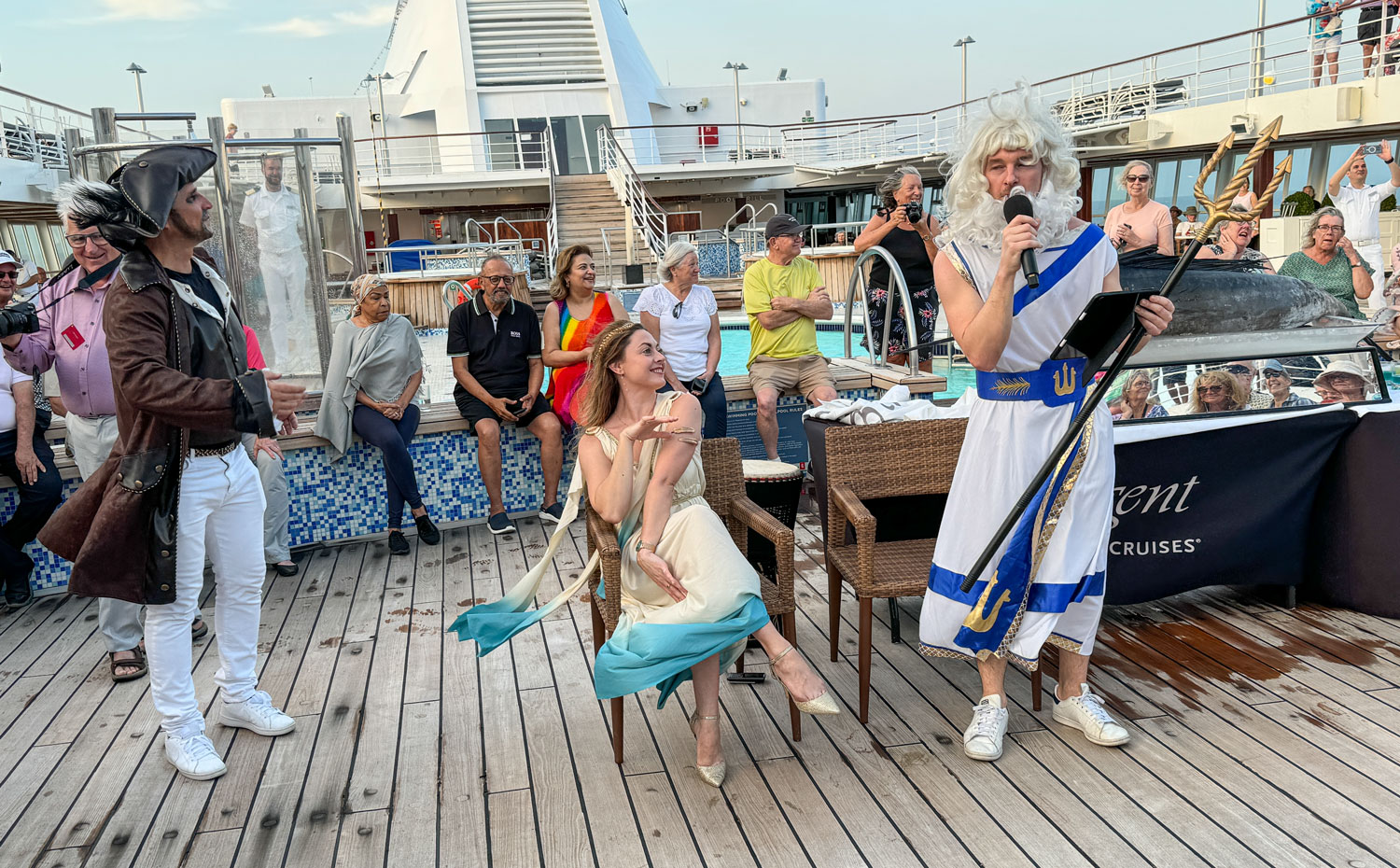
The first challenge for the pollywog is to "kiss the fish".

Then the pollywog is transformed into a shellback by, first, having fruit juice poured on his head by one of the mermen.
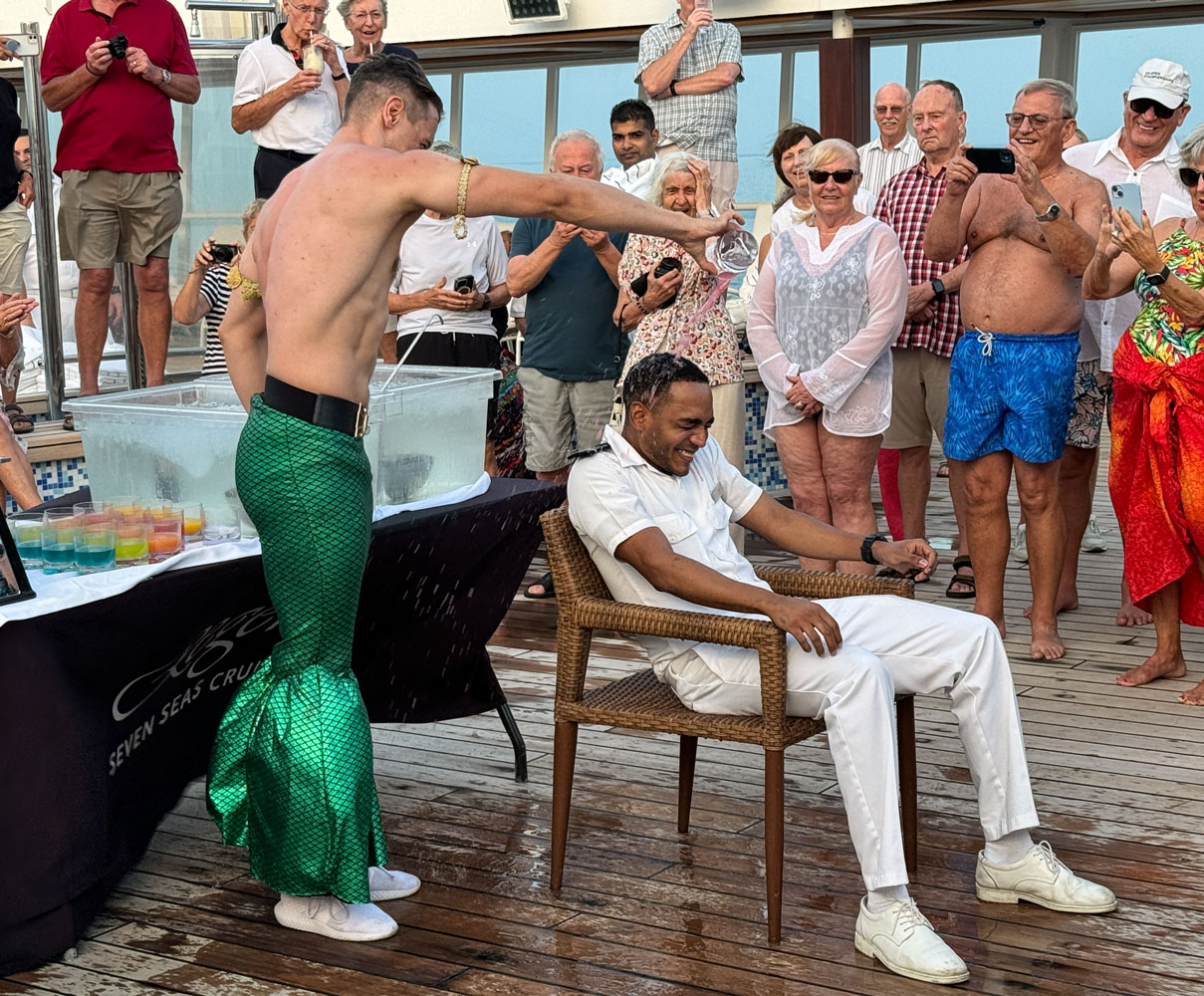
Followed by ice water. You can see the fish in the background of this picture.
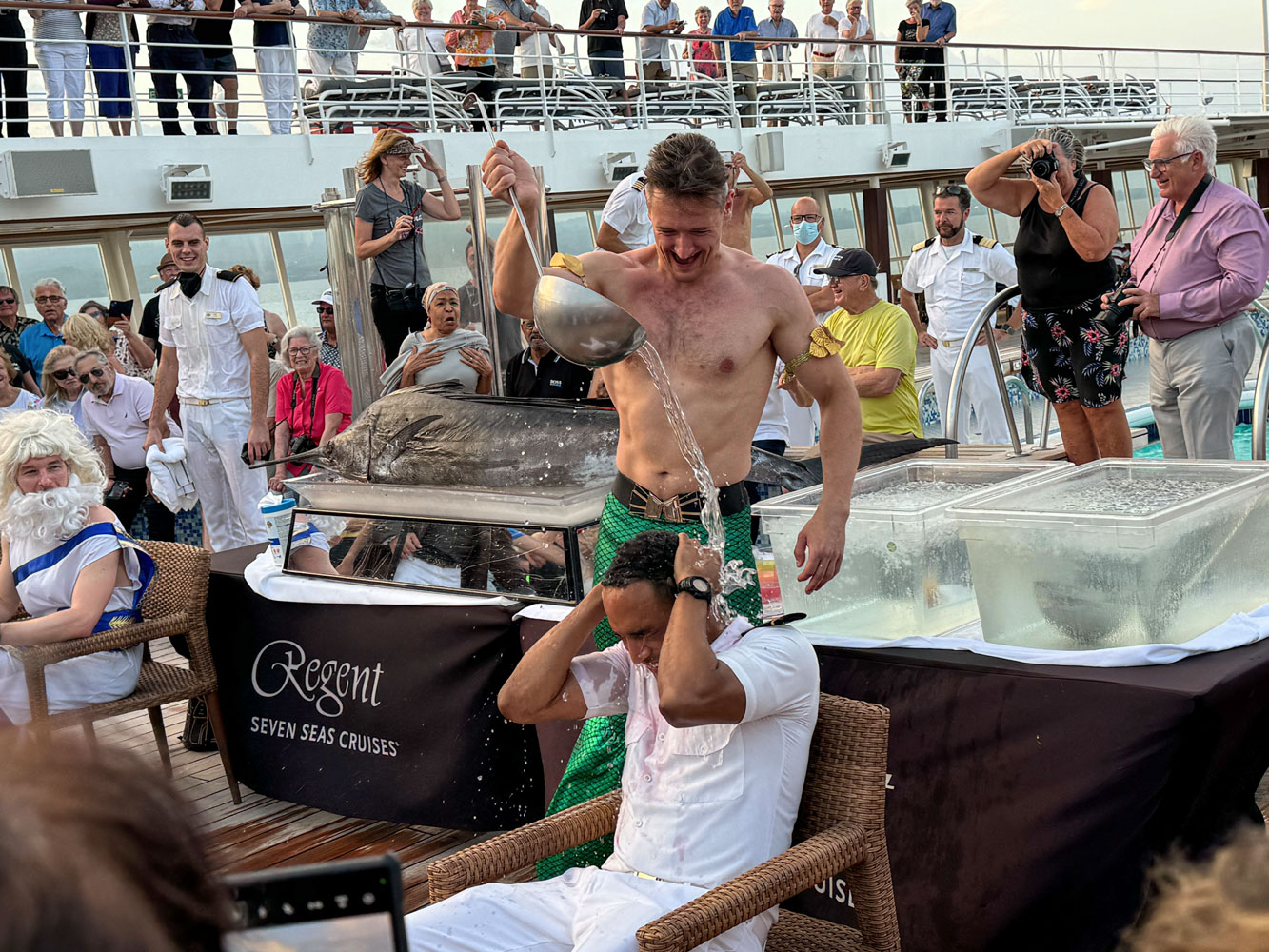
At least you only have to become a shellback once in your life. Here's a member of the entertainment cast being initiated as Davy Jones holds his cutlass to the pollywog's throat.
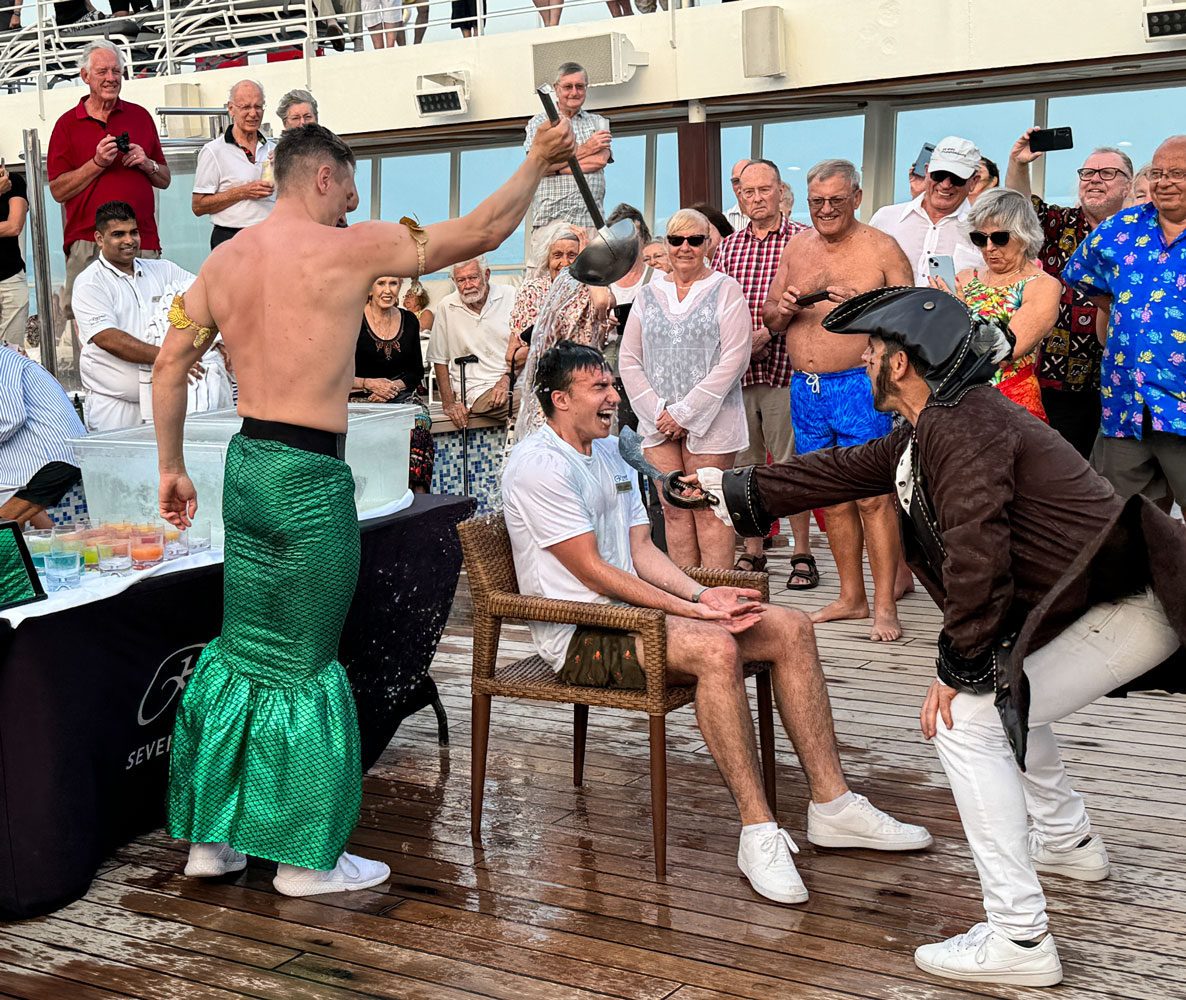
Each slimy pollywog was initiated, but I won't bore you with all the pictures.
After the ceremony, we went back to our cabin and Judy was able to take a picture of the beautiful sunset about 5:30. The outline of São Tomé is in the distance.
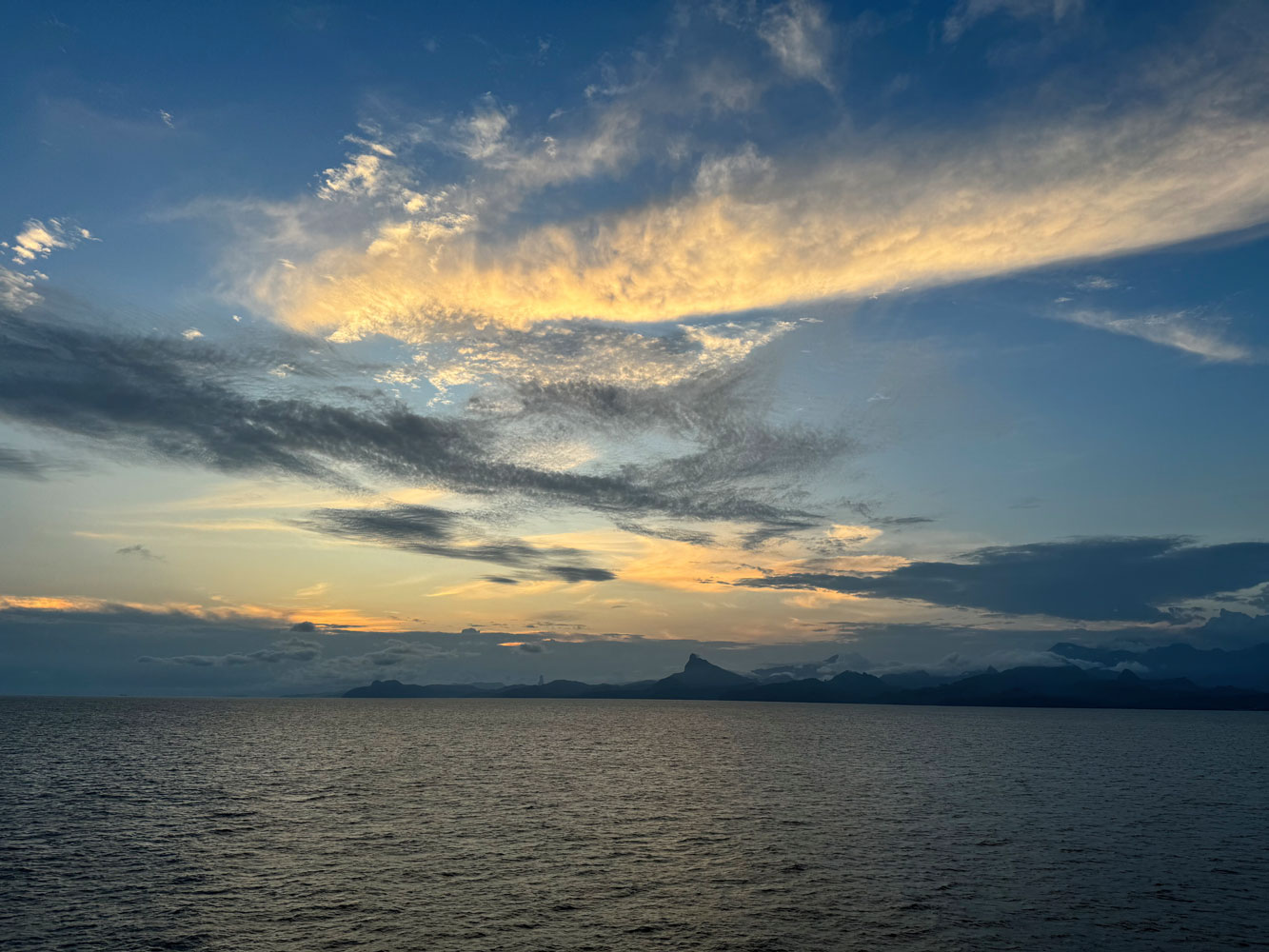
I was monitoring our approach to the equator, and we didn't cross it until just after 6pm. We were heading a bit west of south at the time.

We received certificates this evening attesting that we had crossed the equator on the Regent Voyager.
That was the end of our day. Judy is still recovering from her cold, but getting better. I'm feeling fairly normal, but still have an occasional cough.
+++++++++++++++++++++++++++++++++++++++++
12/7/2023 (Thursday, Pearl Harbor Day) It's a sea day. We rested, but tried a couple of the games, and then played trivia in the afternoon.
In the evening we had a surprise birthday dinner for Anne's seventieth birthday. Judy is not completely recovered but she's doing well, as you can see in this picture.

The group gathered for a picture behind Anne. This was the small group that took the pre-tour extension to Montserrat, plus one additional couple.
Note the pieces of paper on the table. Anne's husband, Karl, printed each piece of paper with the word for "70" in a different language, and asked us to guess which language each was. Some of the languages were really obscure, such as Swahili. Our table won the contest with four correct. One of the words, however, was soixante. We each got a one-point Regent cruise prize card.
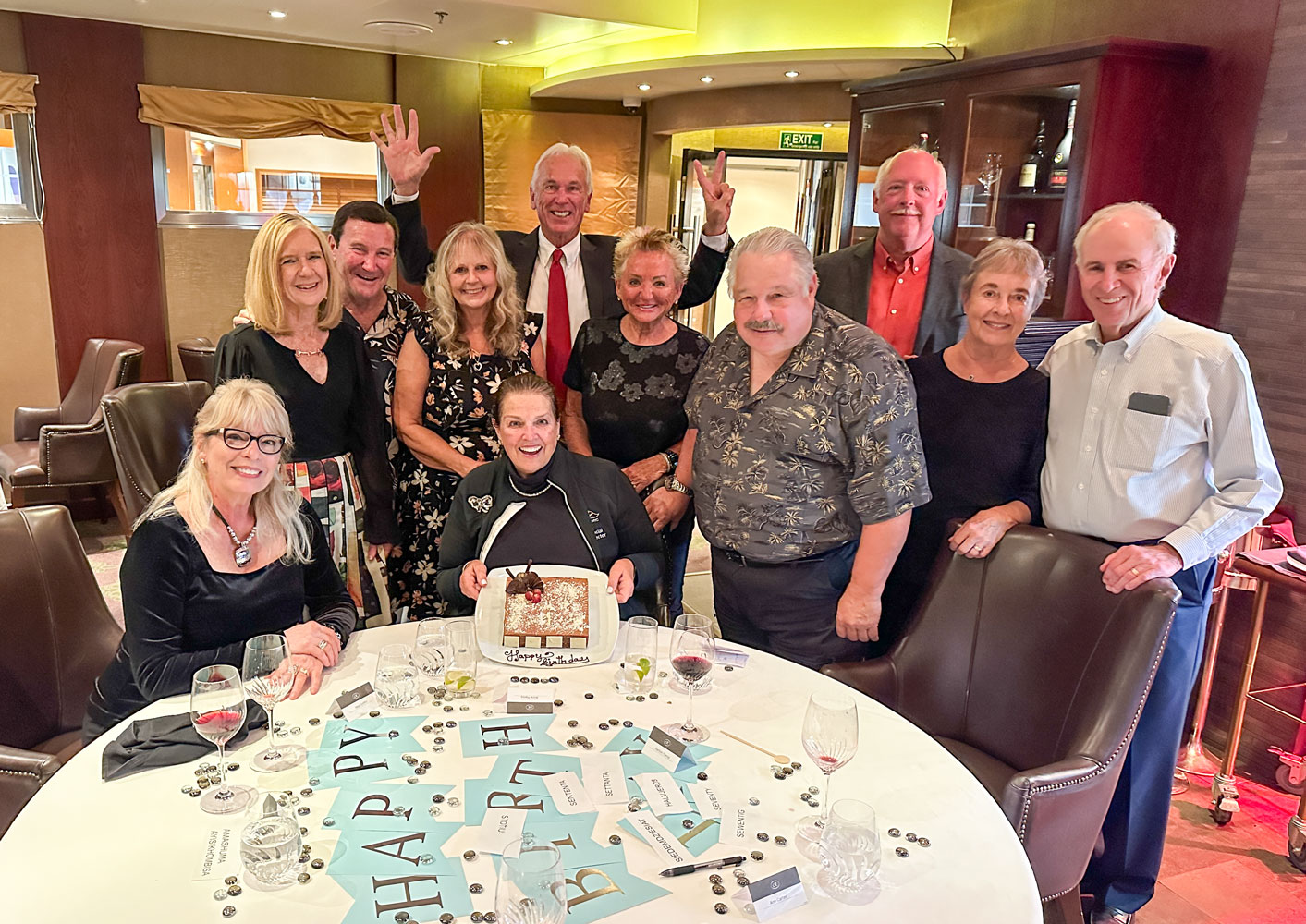
+++++++++++++++++++++++++++++++++++++++++
12/8/2023 (Friday) It's a sea day again today. We participated in some of the games, but struck out on all of them.
We did get a couple of points on the Mensa quiz but we failed miserably at the trivia game.
After dinner in Chartreuse restaurant with Eva and Richard, we set our clocks ahead one hour, bringing us to Cape Town time.
+++++++++++++++++++++++++++++++++++++++++
12/9/2023 (Saturday) Our last sea day before we get to Walvis Bay in Namibia (Walvis is Afrikaans for whale). We woke up late because of the time change.
We're not that far south of the equator (18°28'S as of 1pm today, about 1,275 miles), just south of the border between Angola and Namibia, but it was fairly cool today (16°C). This is spring in the southern hemisphere, so it should be warming up.
A side note is that the Tropic of Capricorn is at 23°26'10.2"S. We'll cross it after we depart Walvis Bay, which is almost at 23°S. We crossed the Tropic of Cancer as we sailed along the coast of north Africa (sometime after we departed the Canary Islands). Barcelona is about 41°N - all of Europe is above the Tropic of Cancer. On this trip, we cross three of the five major lines of Latitude.
The five major lines of Latitude are: The Artic Circle, Tropic of Cancer, Equator, Tropic of Capricorn and the Antarctic Circle.
The equator is the dividing line between the northern hemisphere and the southern hemisphere, and the prime meridian is the dividing line between the western hemisphere and the eastern hemisphere. Africa is the only continent that lies in all four hemispheres.
We played one of the games in the afternoon and participated in Mensa and trivia. We won two points for the game and four for Mensa, but missed at trivia.
We had dinner with Eva and Richard in the evening.
+++++++++++++++++++++++++++++++++++++++++
12/10/2023 (Sunday) We arrive at Walvis Bay today.
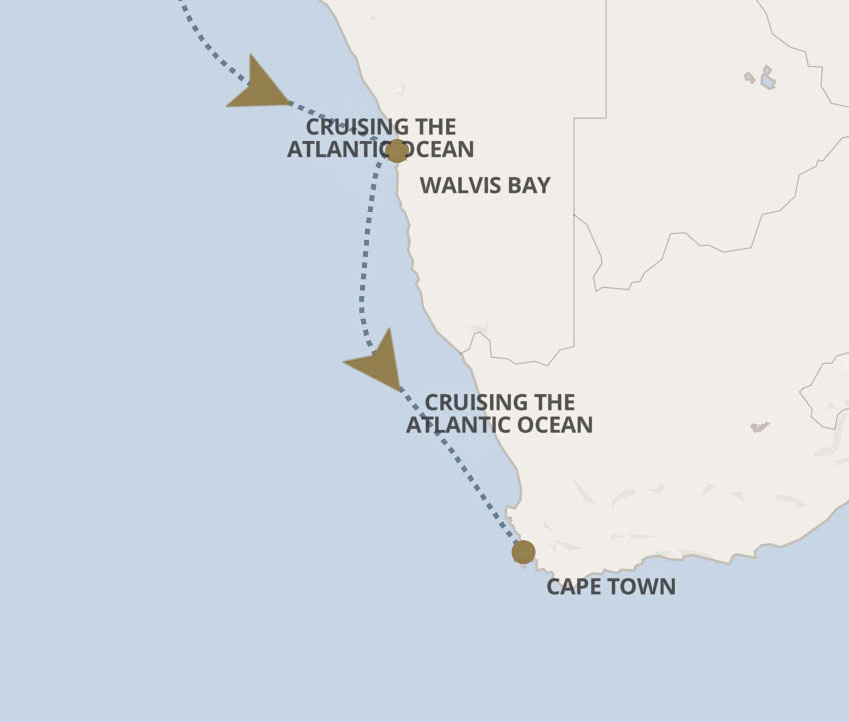
Namibia is mostly desert. I'll repeat this map of climate in Africa.

Here's an enlargement of the Namibia area. Besides the coastline, there's not much other than desert in the country.
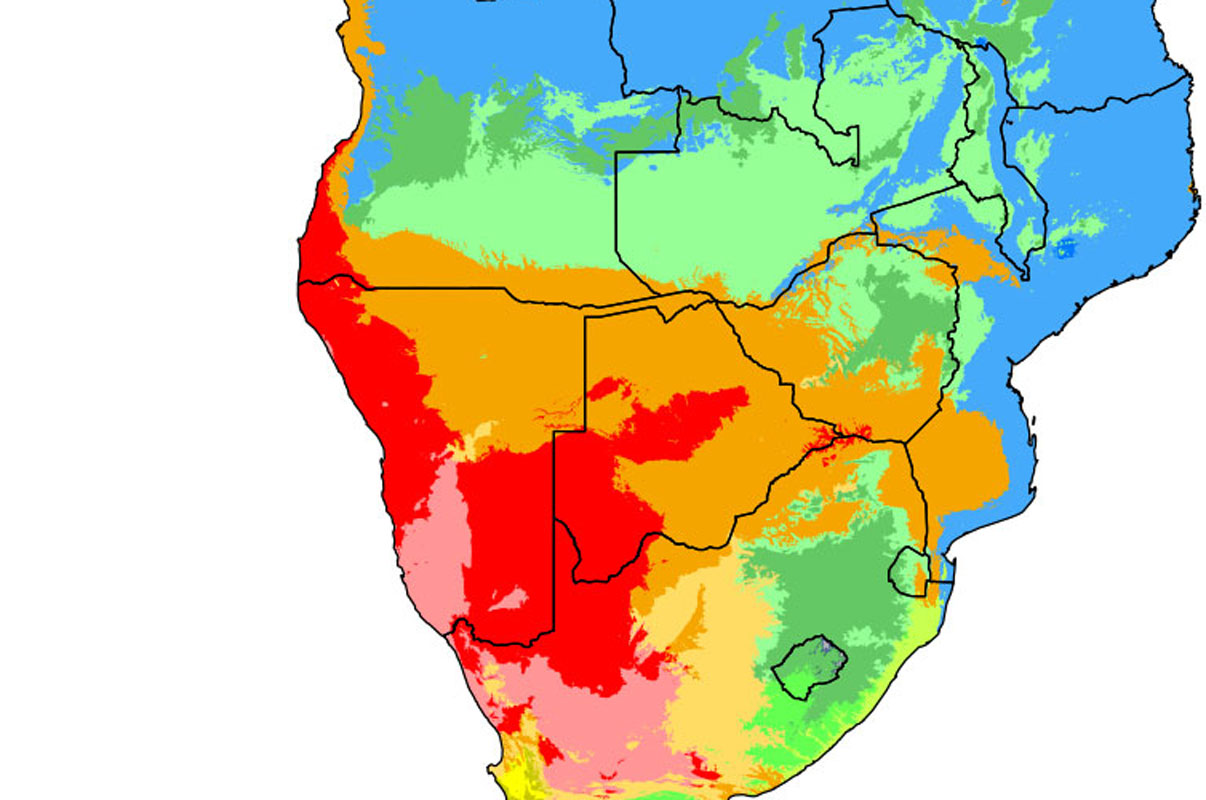
The reason Namibia is so dry is because of the cold Benguela Current that flows counterclockwise along it's shore. This cools the air and generally prevents precipitation. It looks to me that the Benguela current is the southern hemisphere version of the clockwise-flowing Gulf Stream current north of the equator.
The east coast of South Africa is affected by the Agulhas Current, also a counterclockwise current, that brings warm, moist air from the Indian Ocean to that part of the continent.
[Side note: Currents generally flow in a clockwise direction in the northern Hemisphere, and counterclockwise in the southern hemisphere because of the Coriolis force, which is not a real force, but an artifact of a rotating frame of reference. For example, if you were to fire an artillery shell directly north in the northern hemisphere, it would land east of where you aimed it. That's because the gun, and the shell, is moving east when fired (because of the rotation of the earth). But the place where you aimed it (further north) is not moving to the east as fast as your gun (because it's at a higher latitude) so the shell winds up to the east of the target. There's no lateral force involved pushing the shell to the east.]
Back in the 19th and early 20th Century, Walvis Bay was difficult to reach, other than by sea (because of the desert), so it was isolated from the rest of the country. It was administered by South Africa until 1994, when it was reintegrated into Namibia.
Because it was administered by South Africa, the policy of apartheid was applied to Walvis Bay, and the area around it. The area was segregated. Kuisebmond was a suburb north-east of the city restricted to blacks, Narraville was east of the city and restricted to coloureds, while whites lived in the city proper.
I think English is an official language in Walvis Bay - almost all the signs we saw were in English. The British had control of this area for quite a while after WWI. They also drive on the wrong (other) side of the road here.
Our tour today was titled "Highlights of Walvis Bay and Swakopmund" (a city north of Walvis Bay), so we did not see Kuisebmond or Narraville. They were definitely putting their best foot forward on this excursion. Our tour guide explained that economic apartheid still exists in Namibia.
When we returned to the ship, we talked to someone who had gone to Narraville and had seen Kuisebmond. They reported that Kuisebmond was similar to the slums we had seen in other countries.
But back to our tour. The first place we stopped was Flamingo Lagoon, which is on the south side of Walvis Bay and fairly close to where we docked.
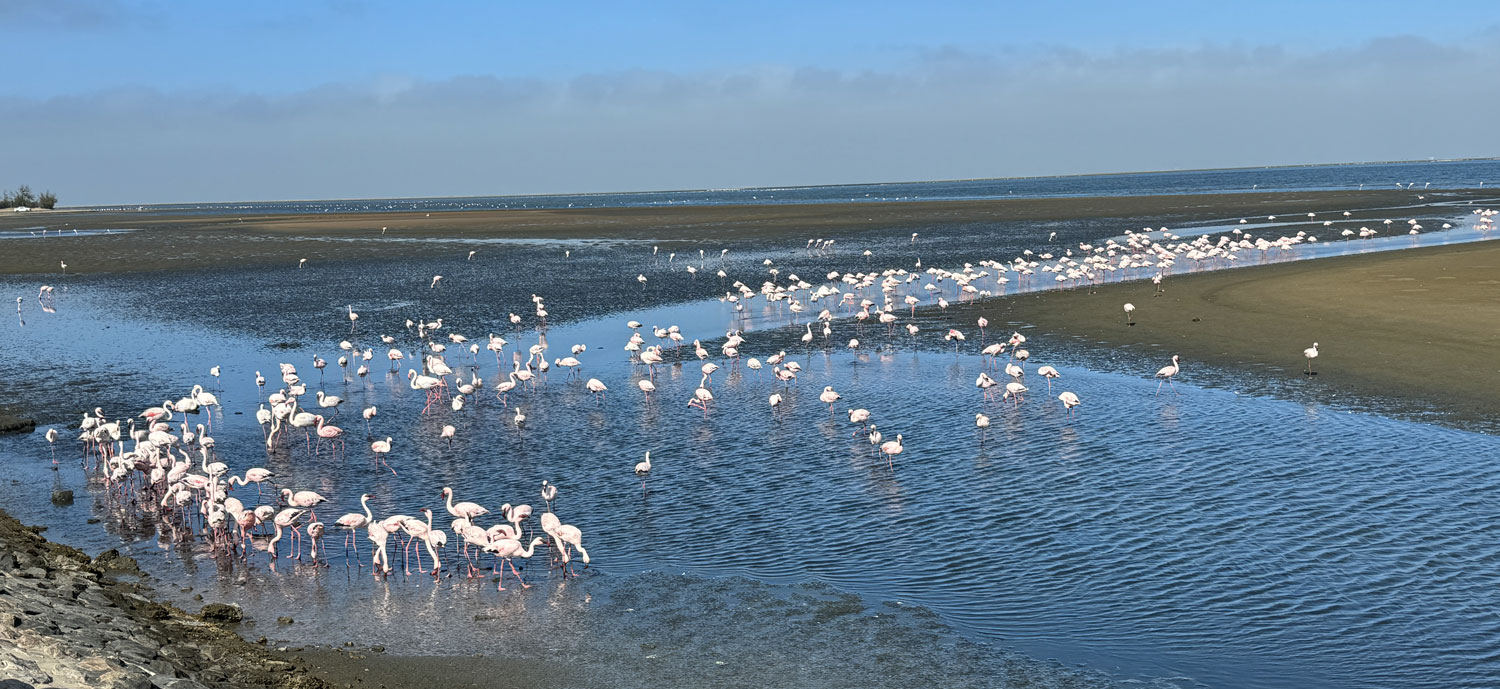
A closer view of some of the flamingos.

And a close-up of three of them. Look at those eyes!
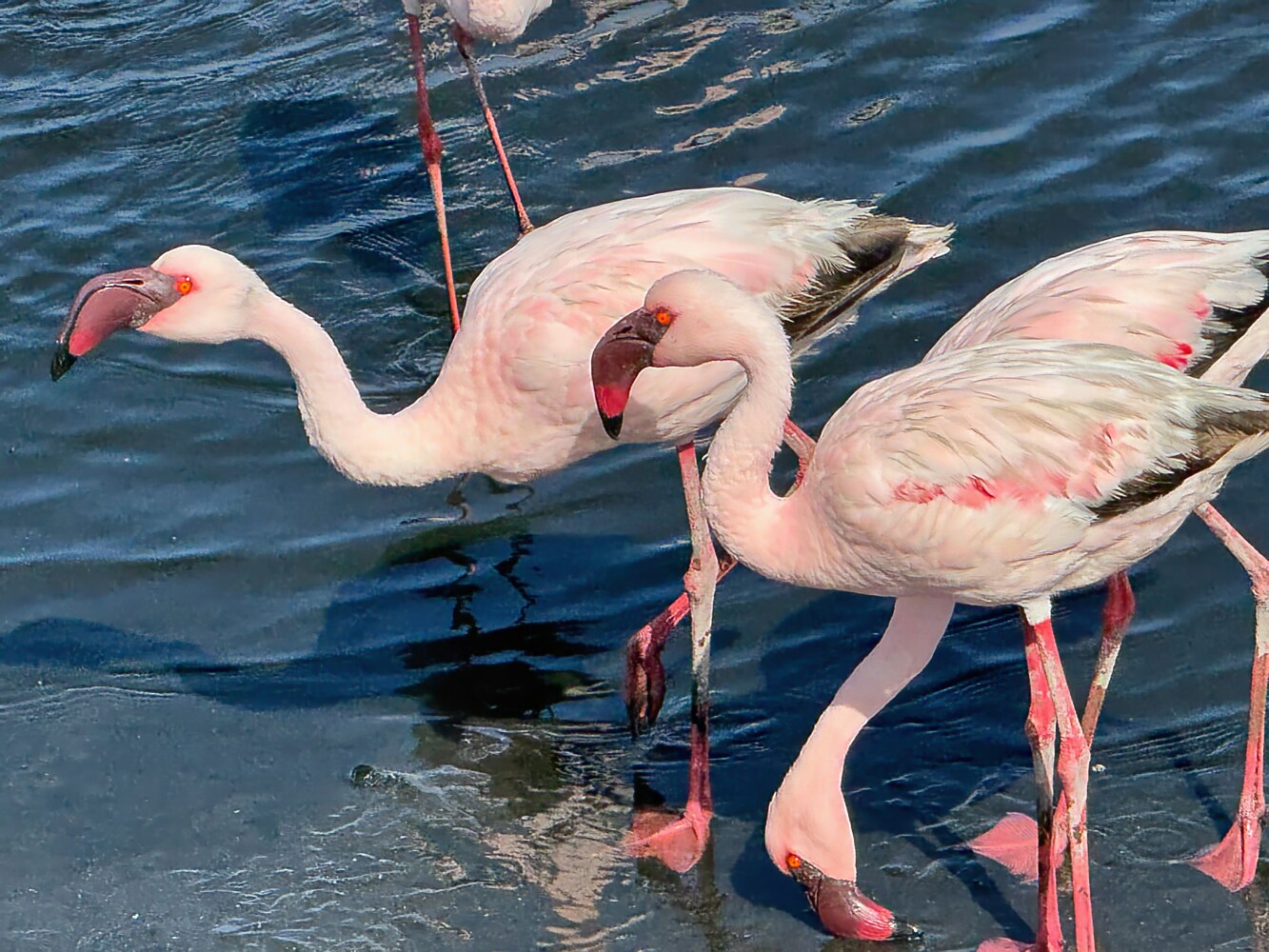
The housing in this area is very nice, pretty much equal to what you would find in the beach area of any industrialized nation.
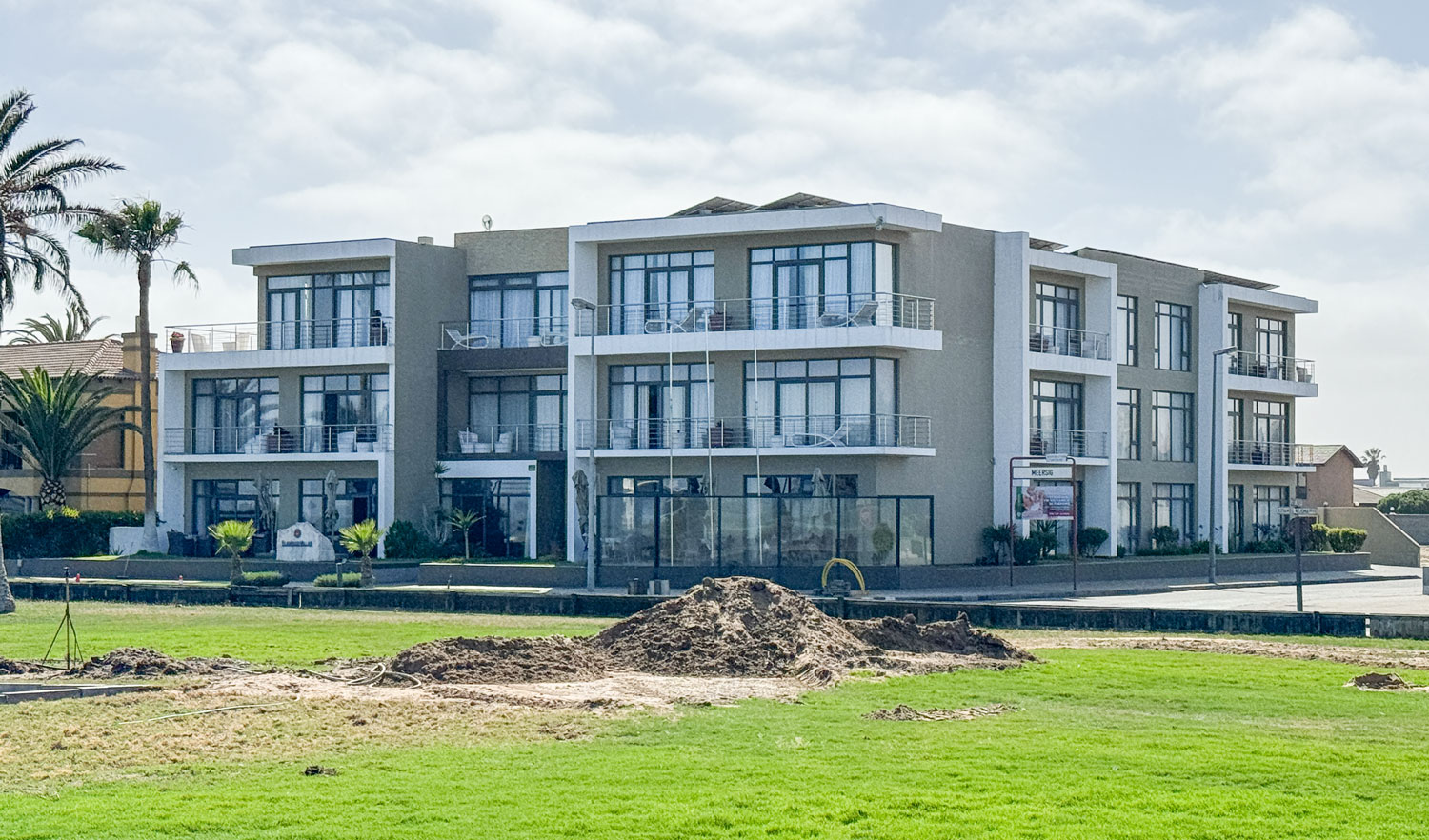
From here, we took the B2 highway to Swakopmund. The road goes along the ocean, but there's nothing but desert on the inland side.
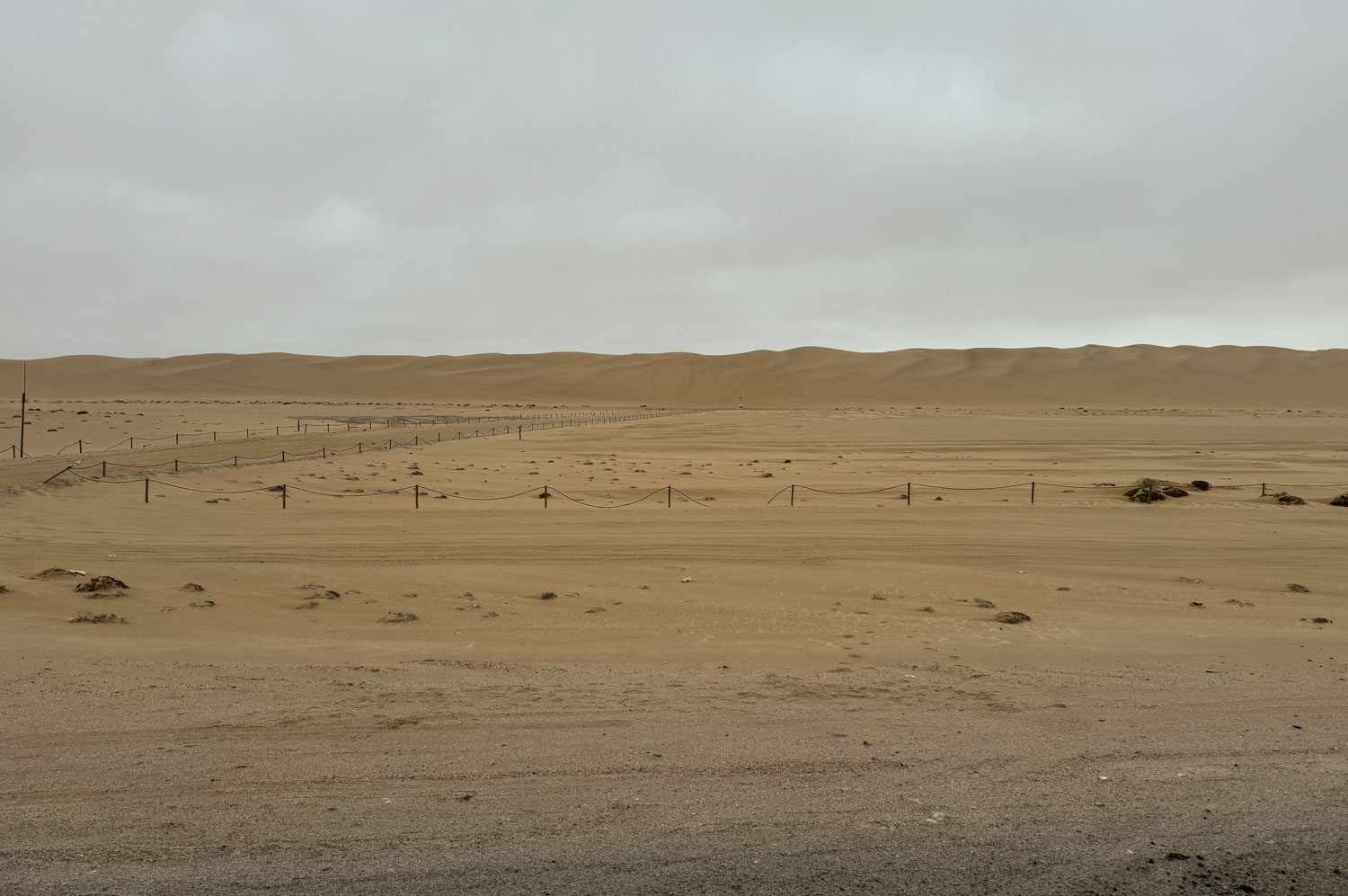
It took about 20 minutes to get to Swakopmund, and we stopped at a local craft place selling carpets and leather goods.
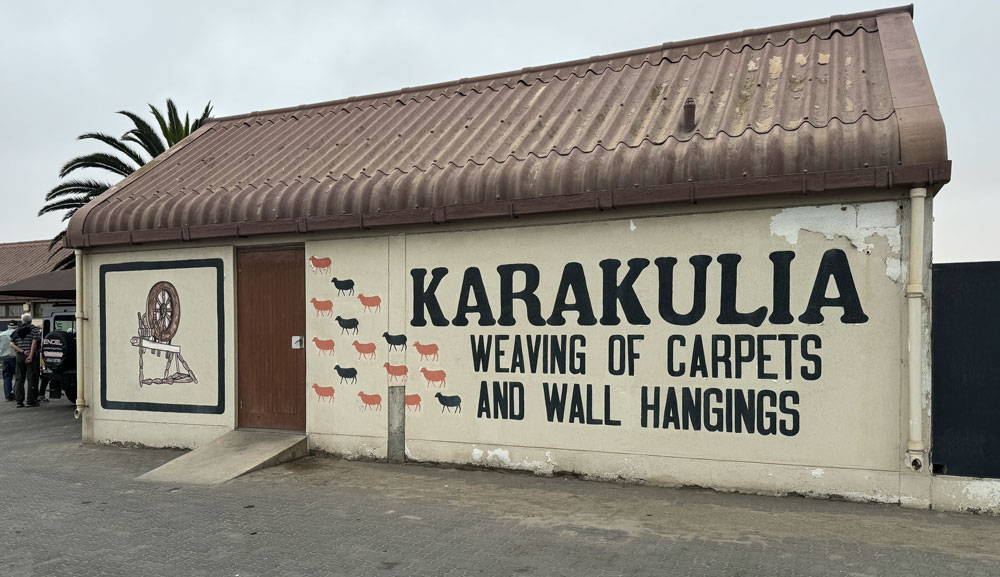

A weaver at the loom. Their carpets are in a style that did not appeal to me, but it would have been almost impossible to carry one home, in any case.
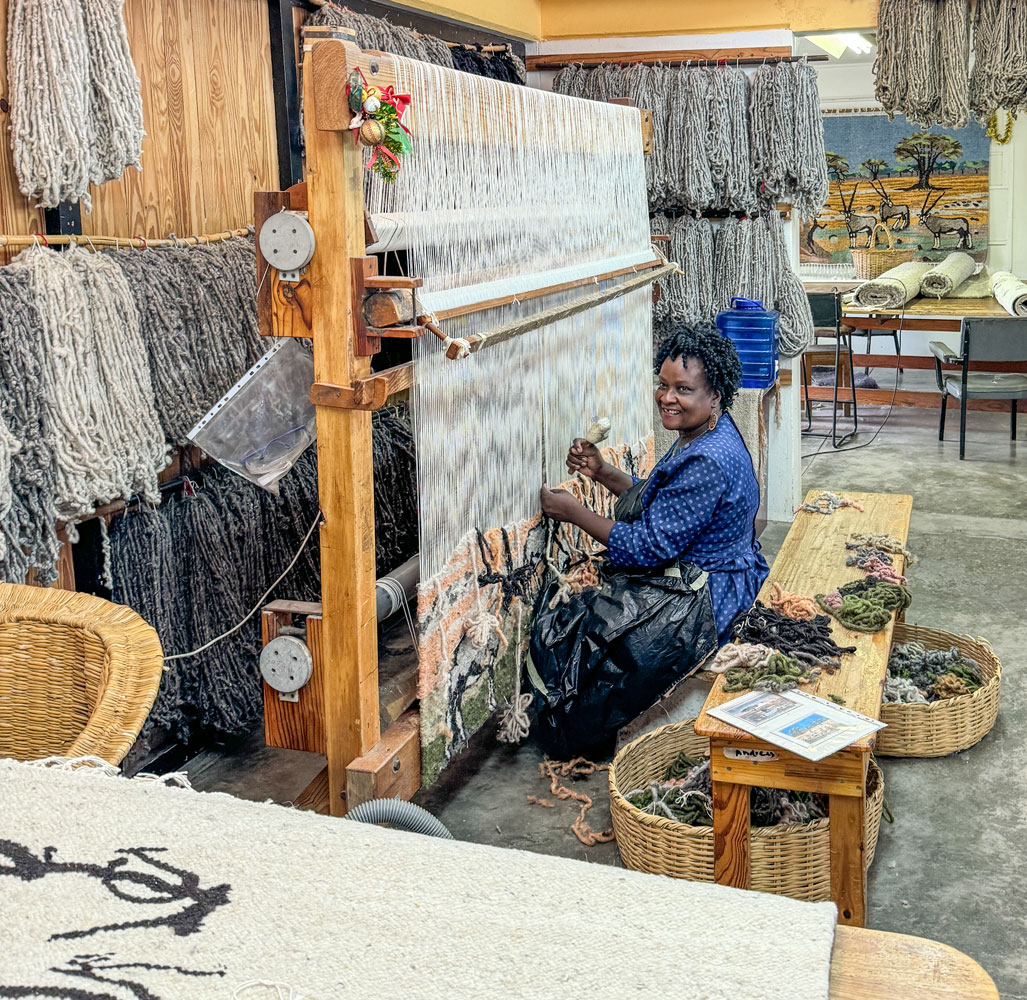
I bought a leather belt and a Namibia baseball cap. Richard bought a leather hat.
Then we drove further into Swakopmund. Swakopmund was founded by the Germans in 1892 and it still retains it's German character, even though the British took over the area after WWI. It is definitely an upper-end town. The buildings are modern and the city is basically clean. It's equivalent to a first-world beach city. We stopped at the Swakopmund Hotel, which was originally the train station.
We went into the hotel, just to look around. It's laid out with a central courtyard, similar to the hotel we stayed in at Victoria Falls.
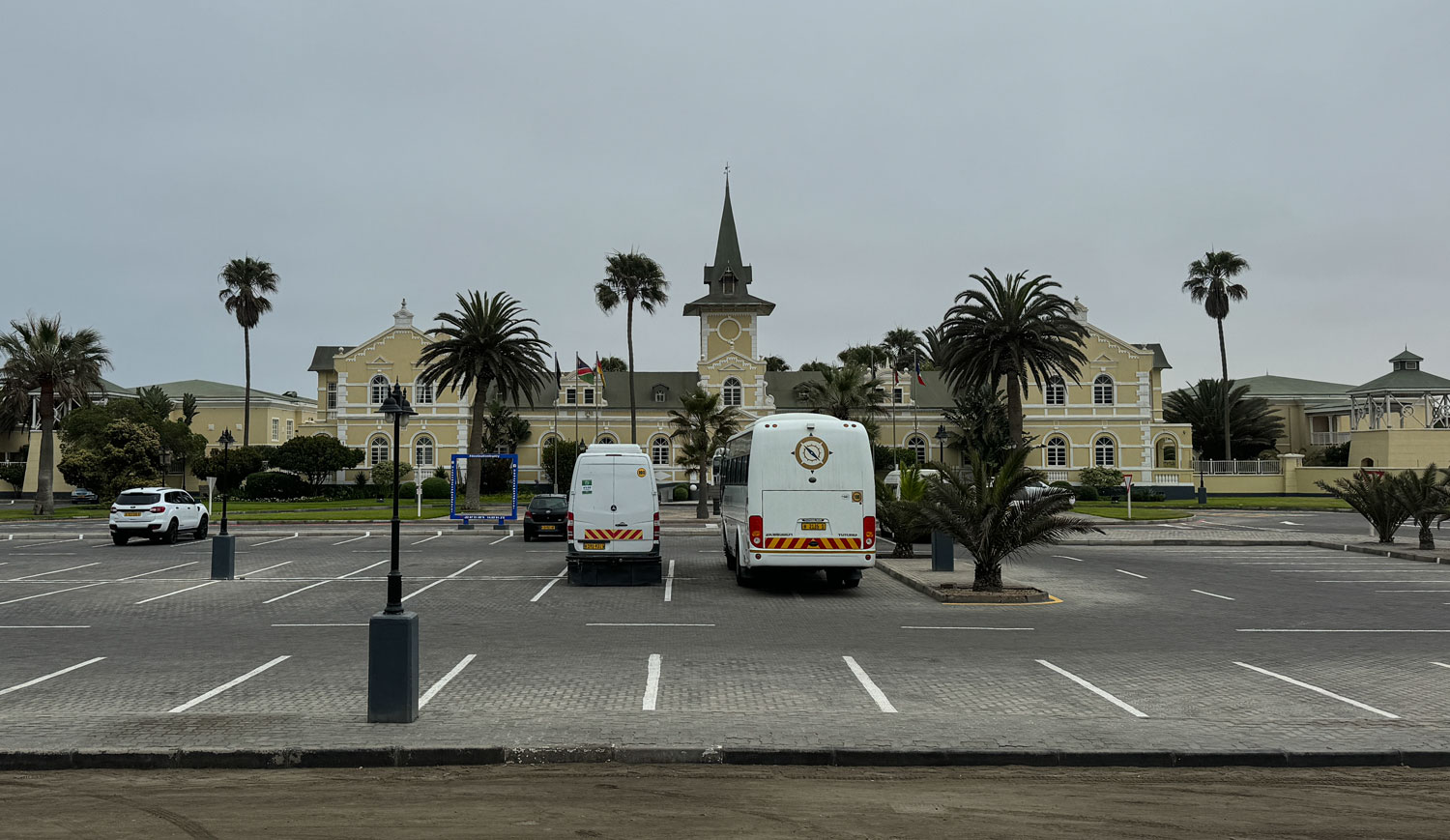
View across the interior courtyard.
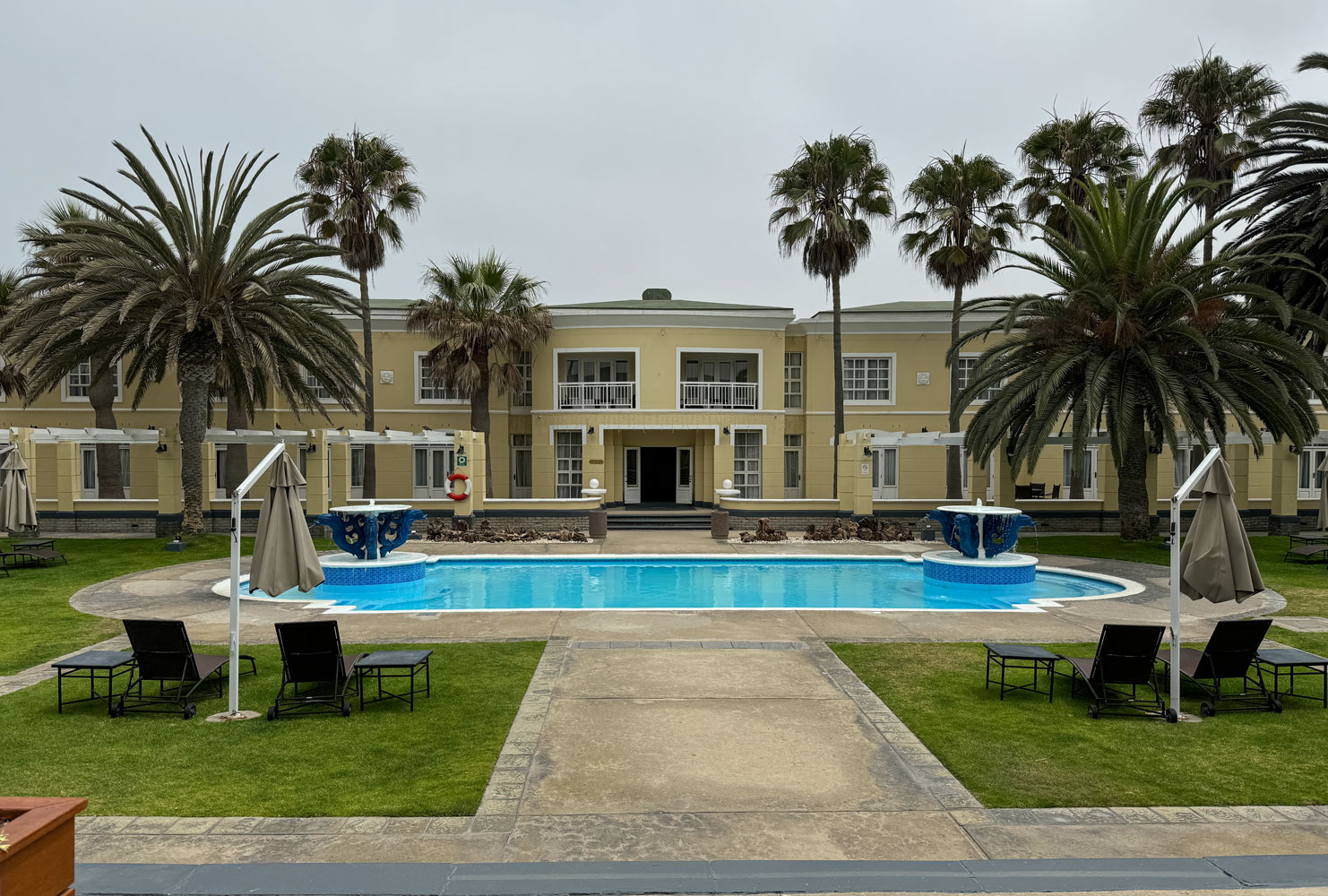
Judy at the hotel.
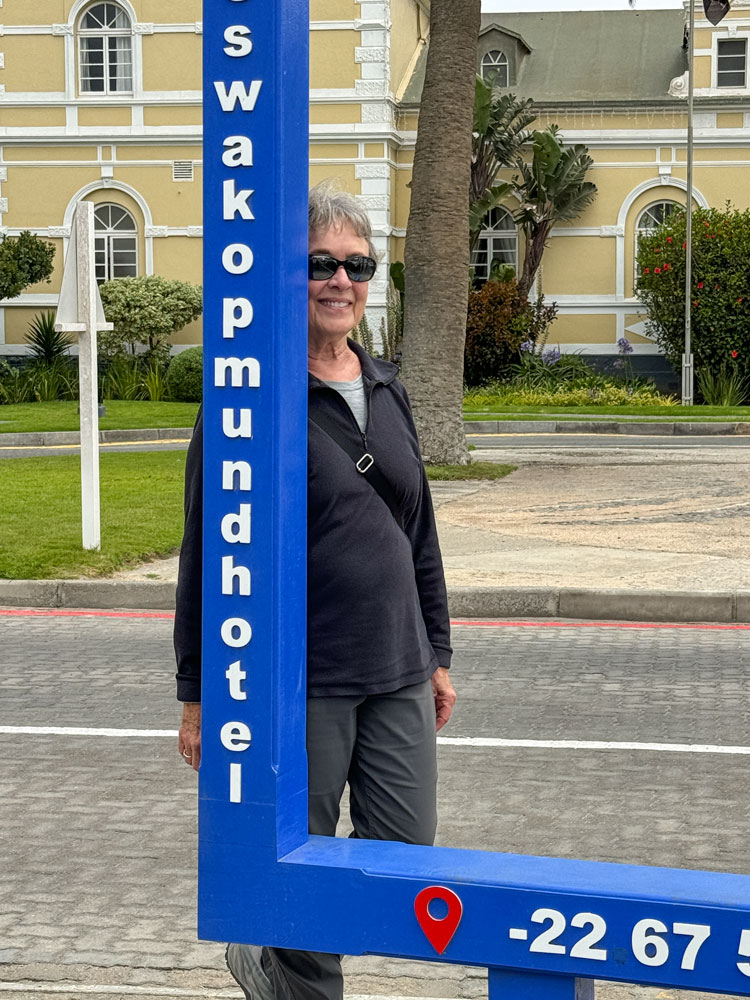
Then we went to the Swakopmund jetty. It was built of wood in 1904, and it accommodated ships for offloading. It was replaced with an iron one in 1914, and was renovated several times in the late 1900's.
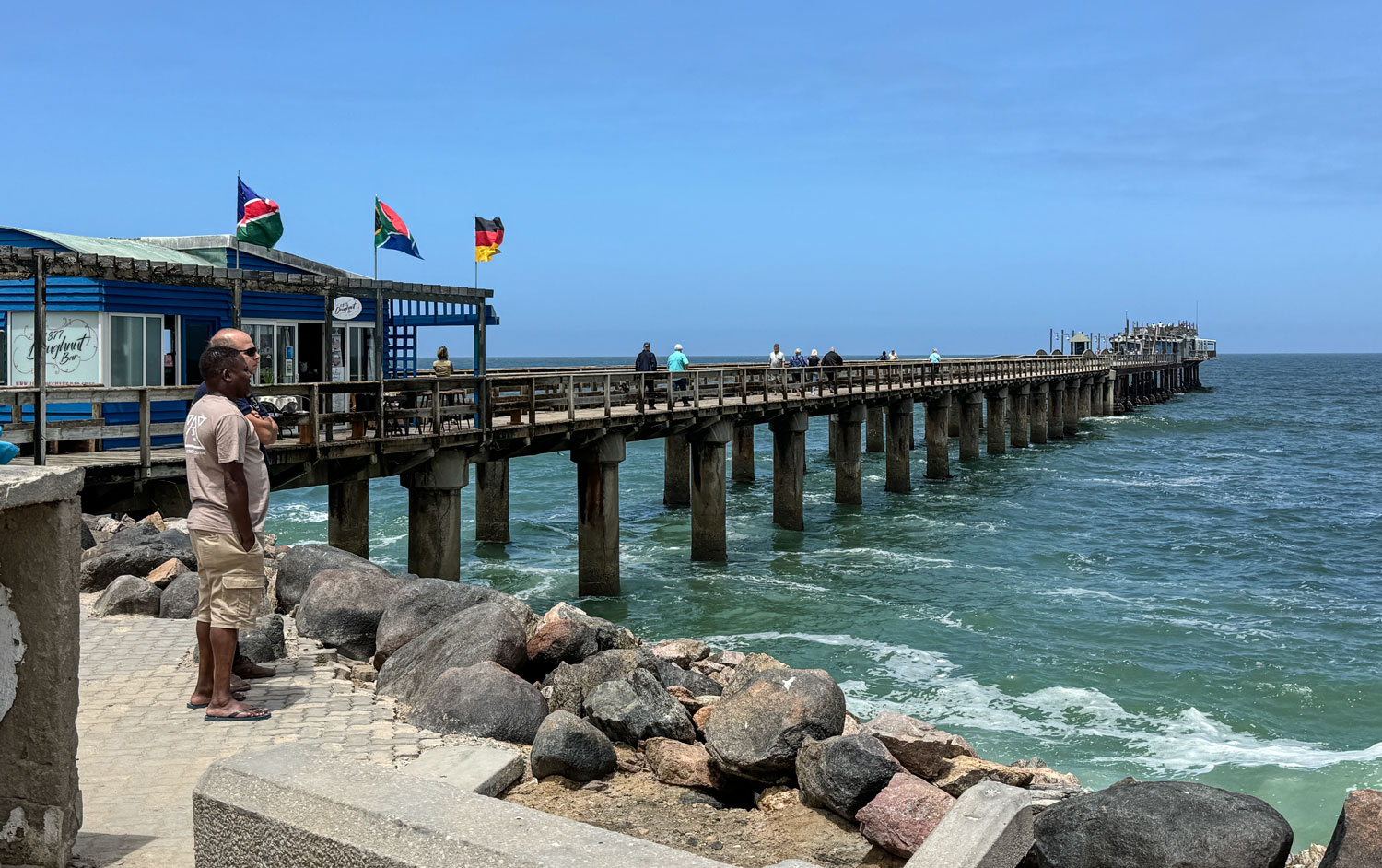
From here, we went to the beach area of Swakopmund where there is a memorial, known as the Marine Memorial, to the German soldiers who died during the Herero War from 1904 to 1908.
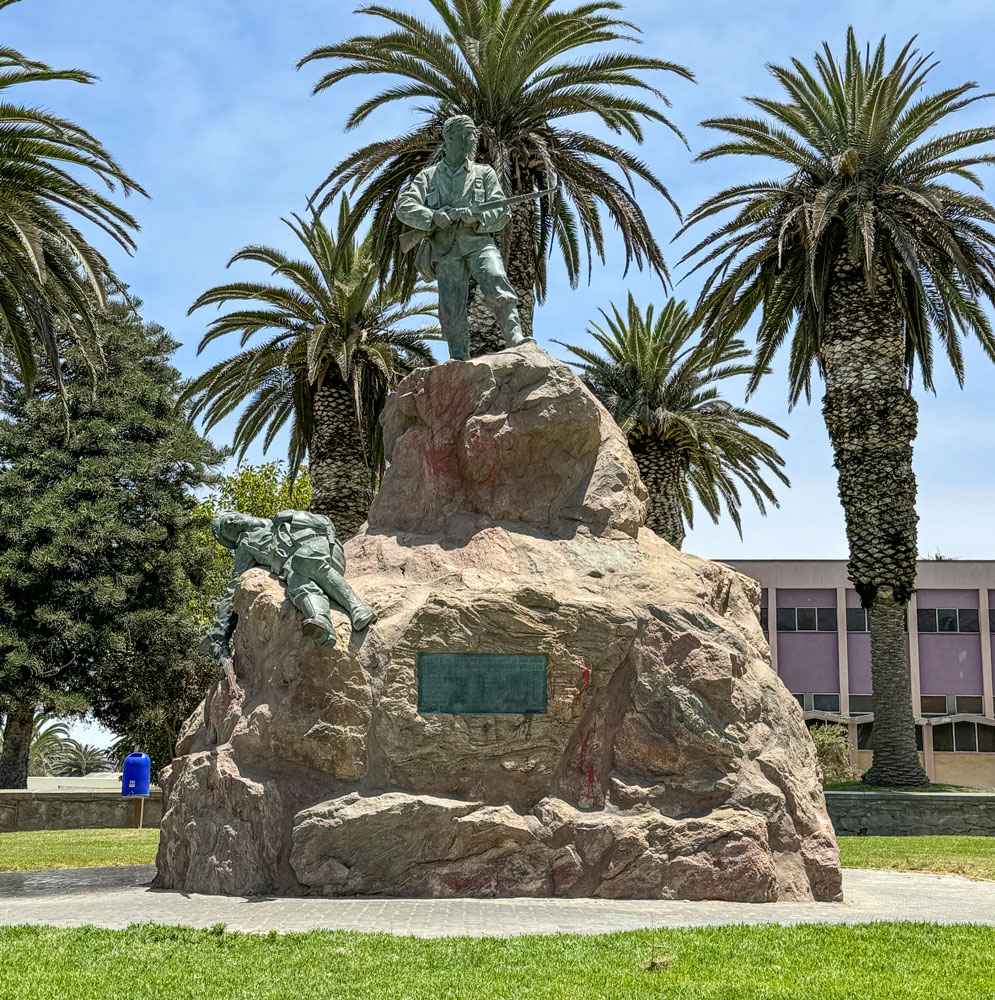
Then to the Swakopmund Museum.
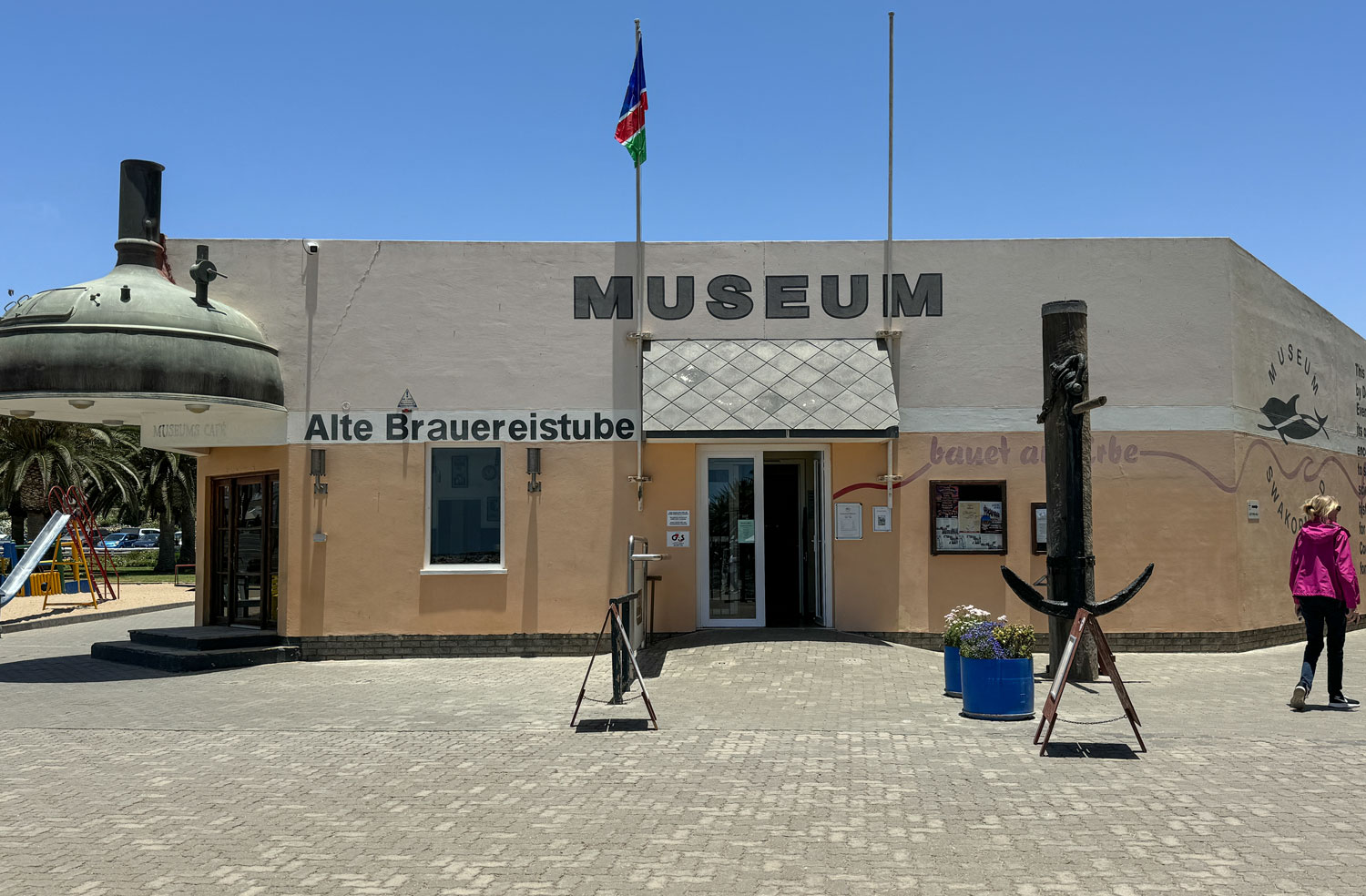
It's a private museum, and has a wide variety of items on display. You can see more of the items on display at the link above.
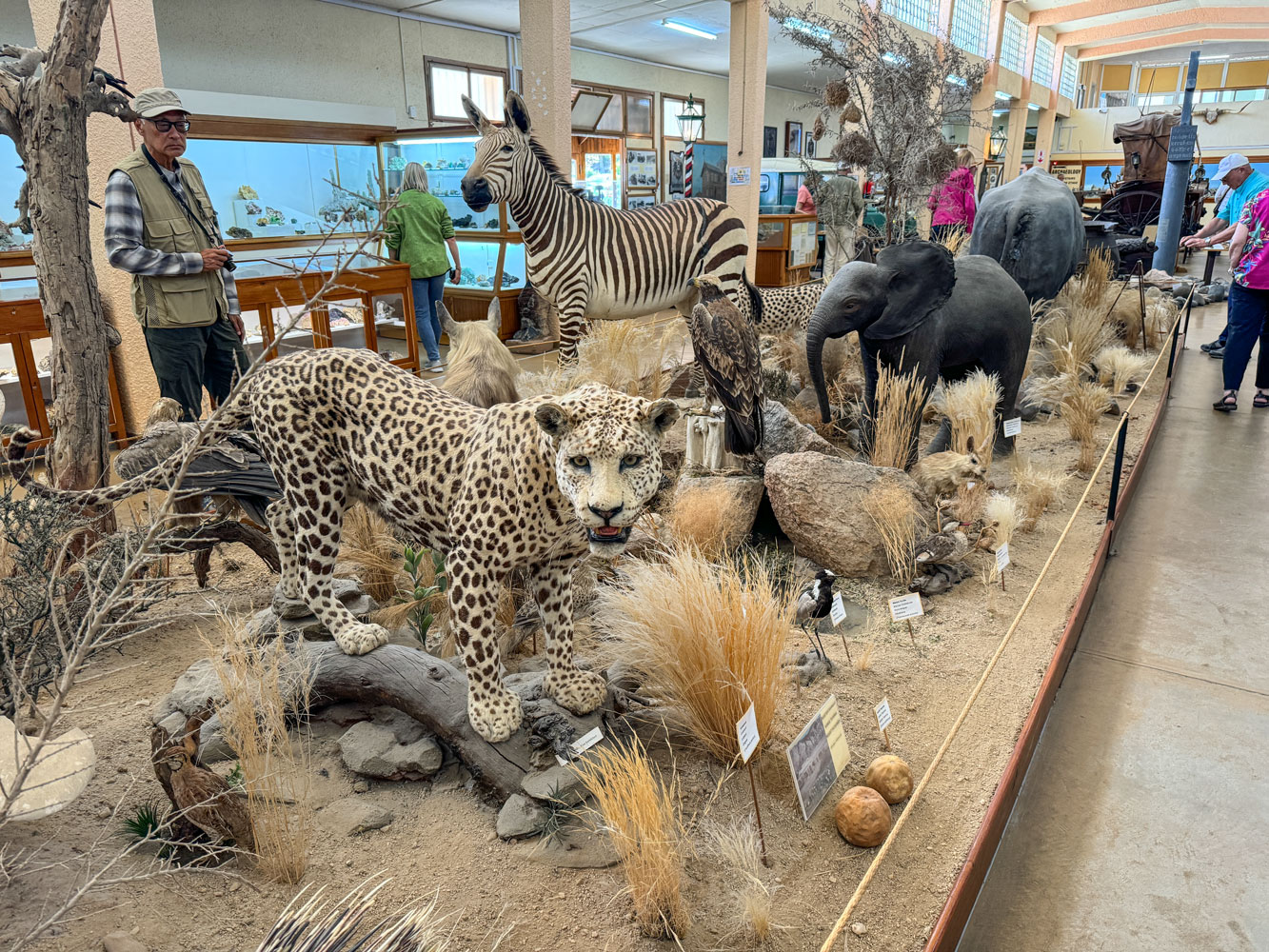
The museum is at the beach, and we walked along the beachfront.
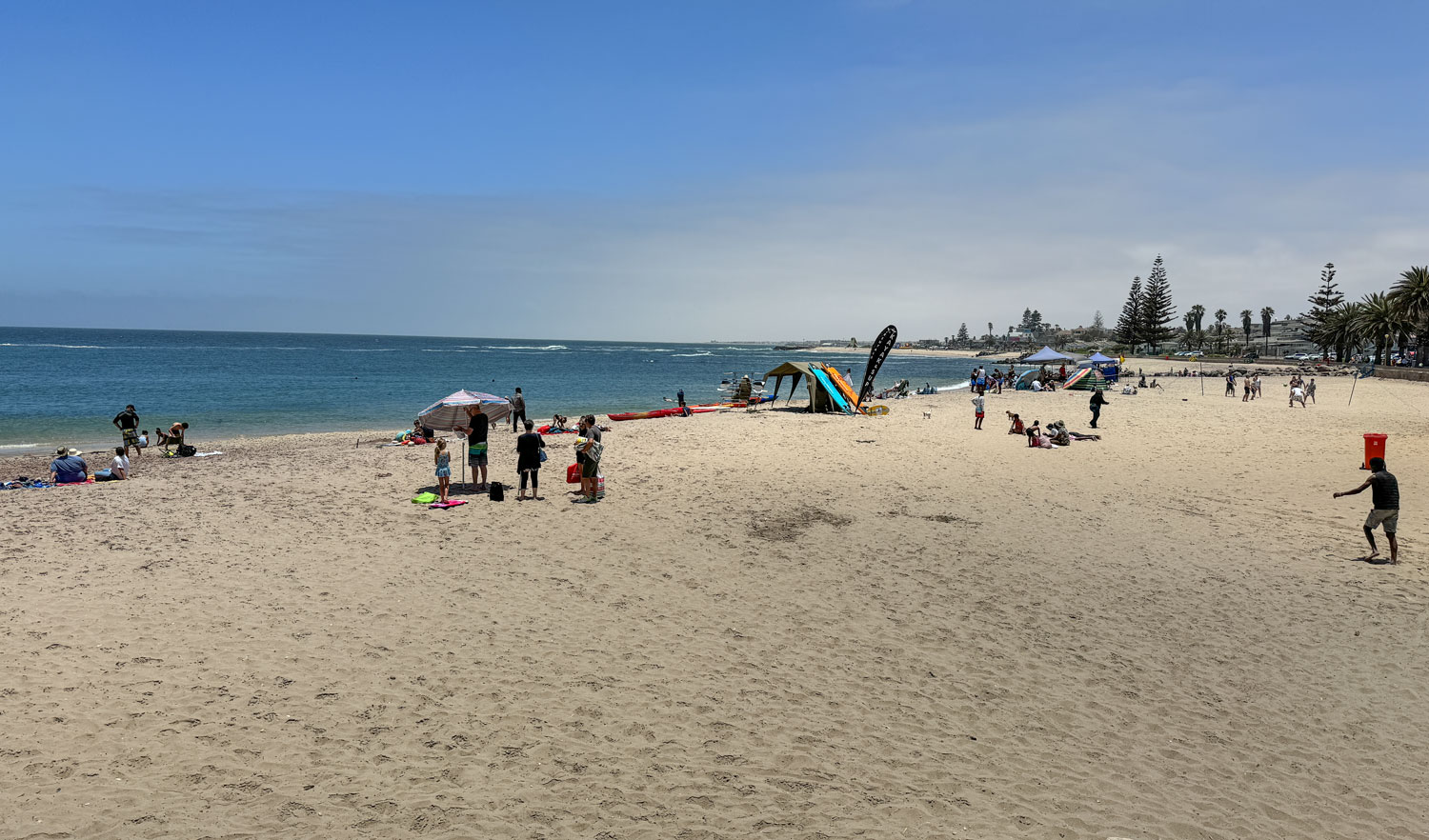
We stopped and sat for a few minutes with Eva and Richard, who is now wearing his new hat, just purchased at the leather place we visited.
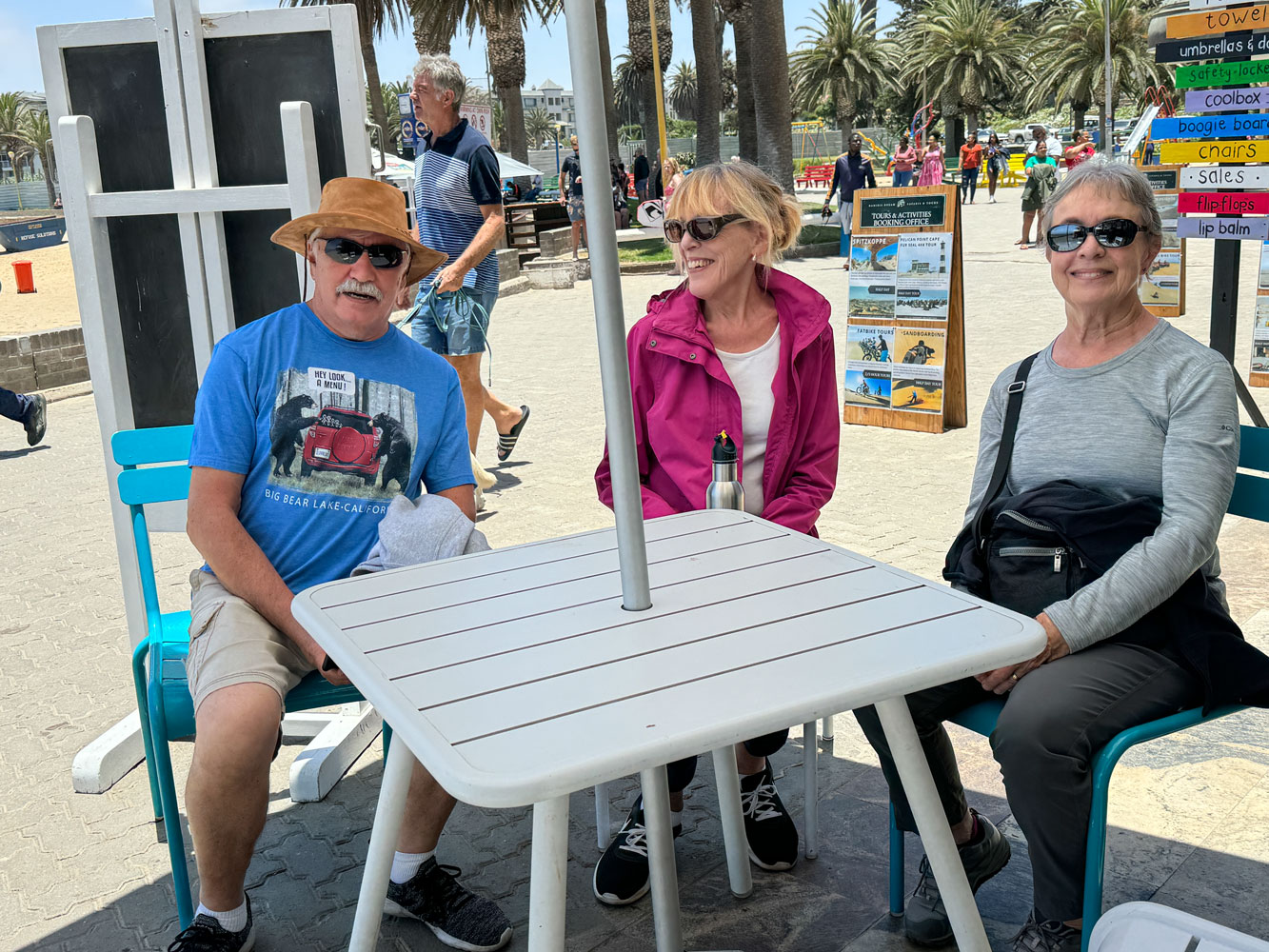
As we drove back to the ship, I took some pictures of the housing along the B2 road. The tour guide said that many of the people living here work in mines further inland and there are shuttle buses to take them to and from work. Overall, nice housing, especially considering the slums we've seen in other countries.
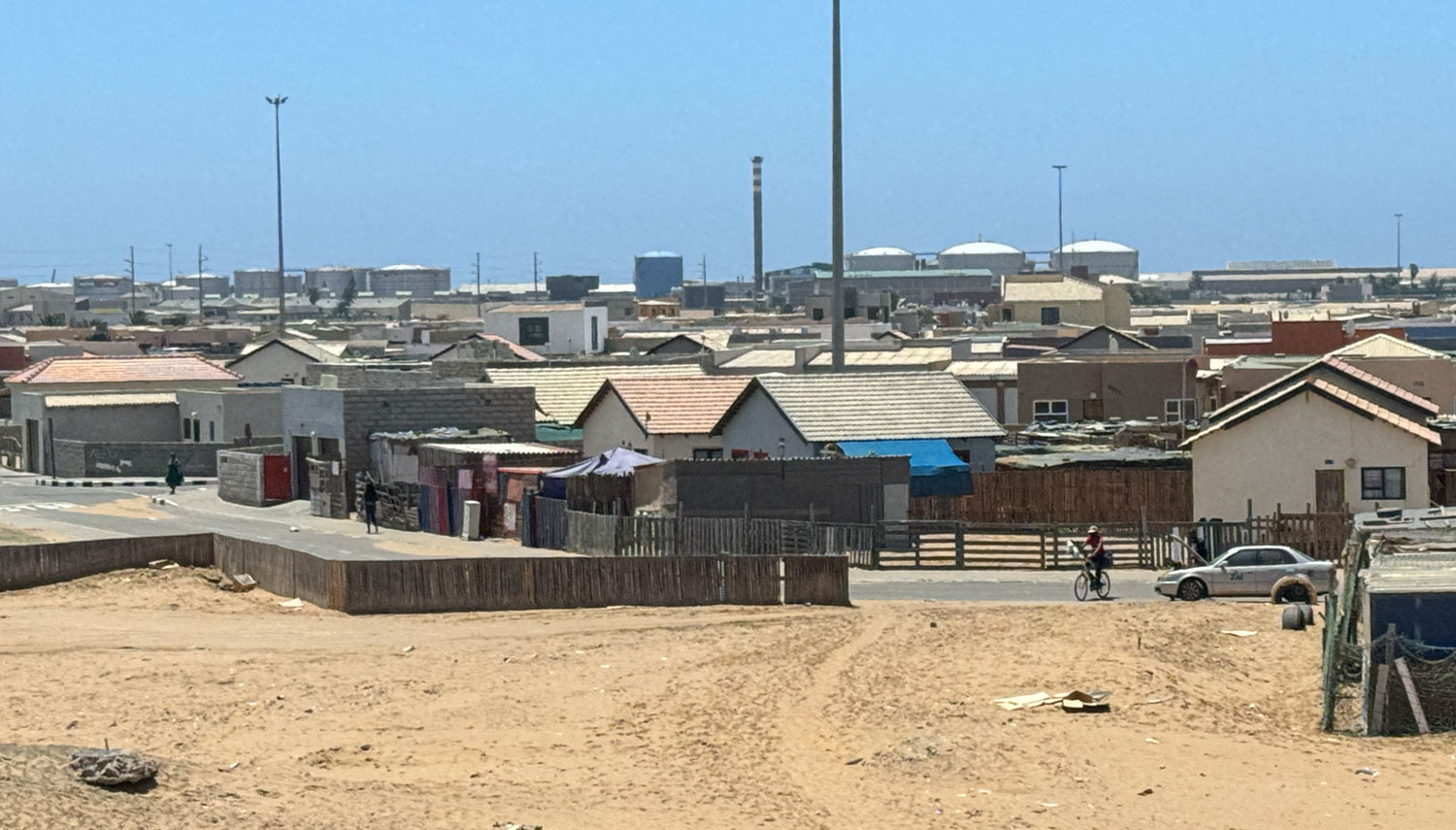
After we got back to the ship, we played trivia, and came out second. Then dinner and to bed.
+++++++++++++++++++++++++++++++++++++++++
12/11/2023 (Monday) Our last sea day. We crossed Tropic of Capricorn shortly after we left Walvis Bay, but I didn't monitor it.
Tomorrow we arrive at Cape Town, and our cruise will be over the day after.
The sea was a bit rough last night, continuing this morning. There was a lot of "thumping" during the night as the ship plowed into a wave, or dropped into a trough. It's fairly cool and windy outside. I'm guessing the temperature is in the 60's F.
The captain announced that he has to slow the ship because of the higher seas, meaning we'll arrive in Cape Town a few hours late, possibly too late to do any of the excursions planned for tomorrow.
We slept in, and then Judy had a massage while I worked on this blog. We'll trade in our Regent points for Regent merchandise this afternoon. We can get two long sleeved t-shirts and a purse hanger for our 100 points.
Here's the setup for redeeming our points. The sample merchandise is on the table in the foreground. We go to the table in the background to put in our order.
Our friends, Tim and Maria, are in this picture, and Billy, the assistant cruise director, is in the pink shirt.
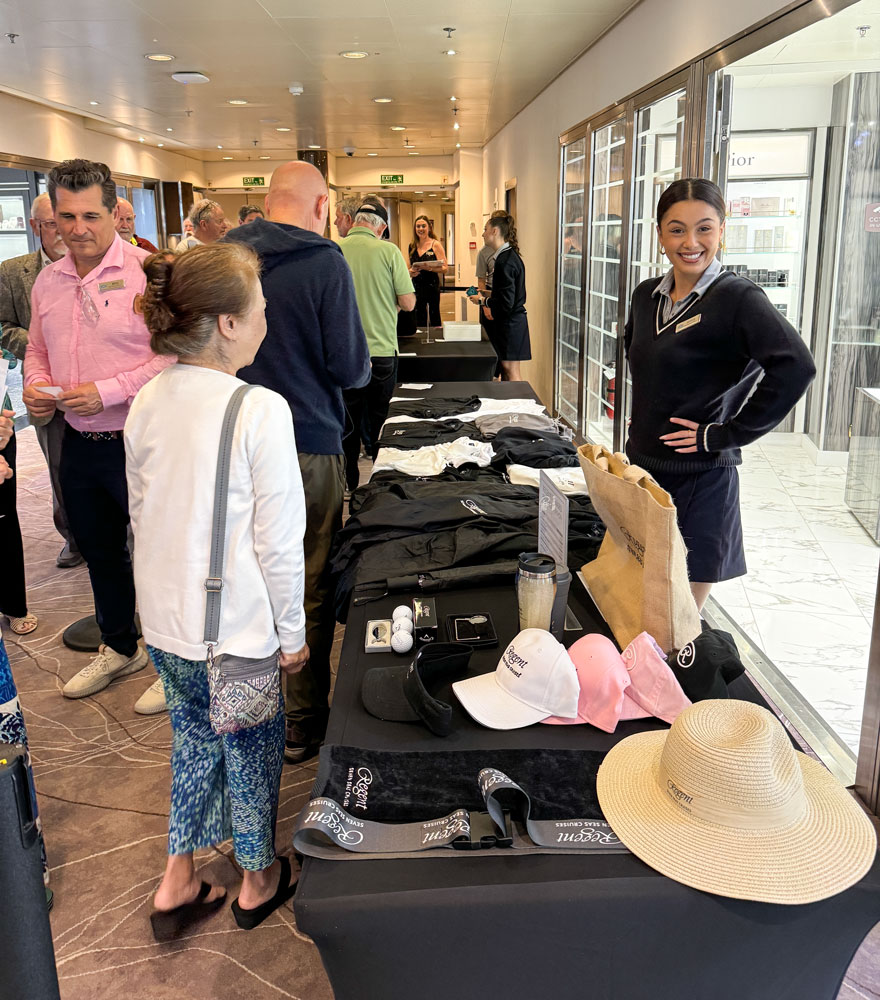
Judy modeling one of our new t-shirts.
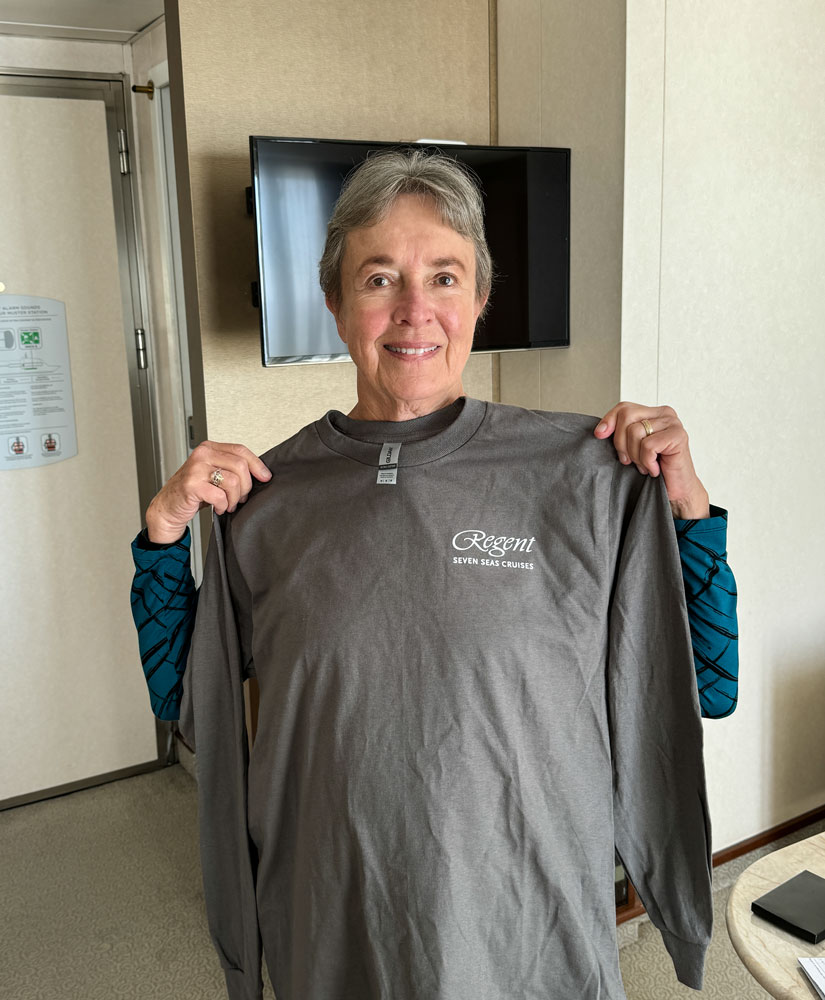
The traditional "Crew Follies" (called Krew Kapers) presentation preceded dinner. This features members of the crew presenting singing and/or dancing acts. Here are a few pictures. A group dancing.
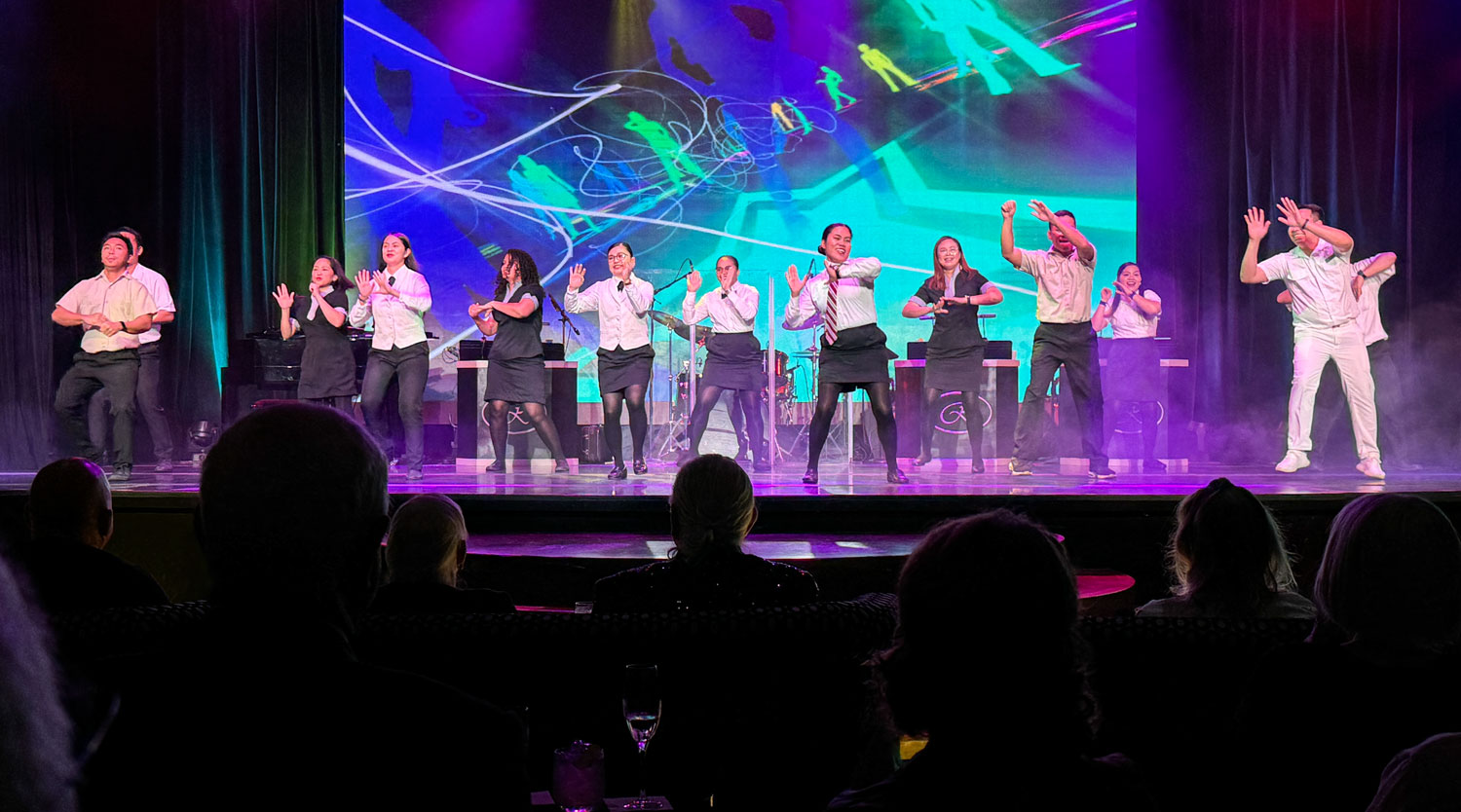
A singer. I like this picture because of the huge rose projected behind the singer.
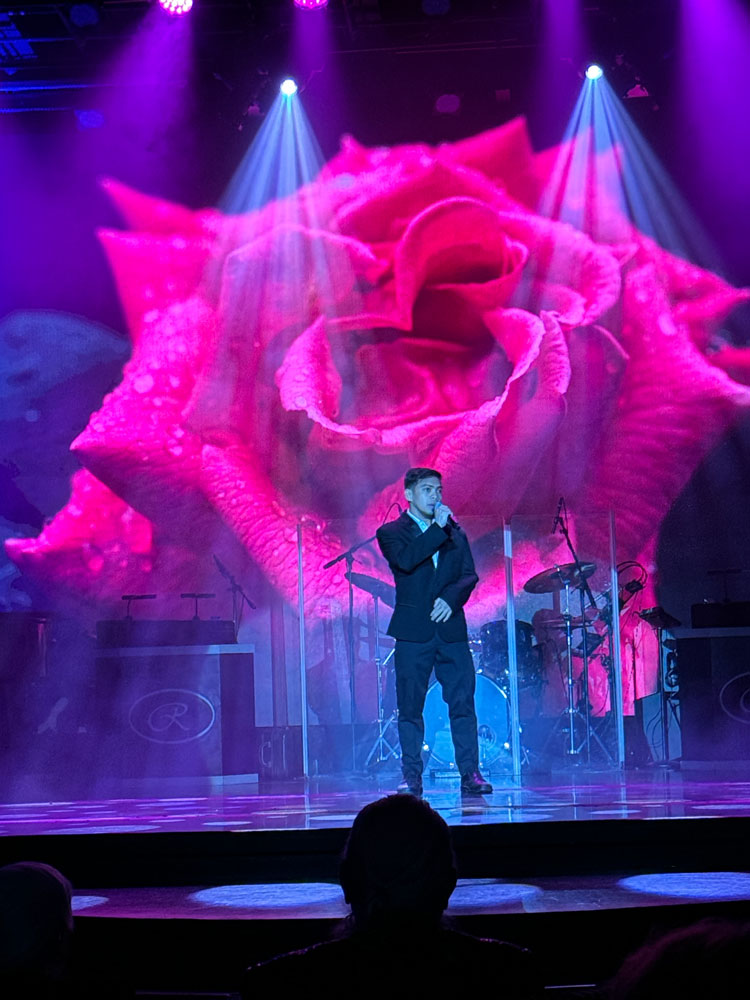
An ensemble cast doing that audience favorite, Village People's "Y.M.C.A." . They perform that song on every cruise and the audience always loves it. They also did Styx's "Come Sail Away" which is the perfect song for a cruise.

Then many of the crew took the stage and were recognized. In this picture, the members of the entertainment cast had just been recognized and are leaving the stage. All of the different parts of the ship were represented, including the deck crew, officers, kitchen, housekeeping, etc.

After the show, we went to dinner and then to bed. We don't know yet how our late arrival in Cape Town will affect our excursions. For the two of us, that's okay, because we were in Cape Town this past January.
We weren't scheduled to arrive until 1pm, so there's little slack for a late arrival.
+++++++++++++++++++++++++++++++++++++++++
12/12/2023 (Tuesday) At 8am we were still more than 100 nautical miles from Cape Town and we are traveling about 17nm/hr. (we're at 32°39'50" S and 17°28'48" E right now.) It's fairly cool outside, probably in the 60's and windy. Summer is slowly coming to South Africa.
Judy and I still have some congestion from our colds but we're much better.
The captain made up some of the time and we arrived in Cape Town about 2:30pm. Table Mountain is the one in the center, with Devil's Peak to the right, and Lion's Head to the left.
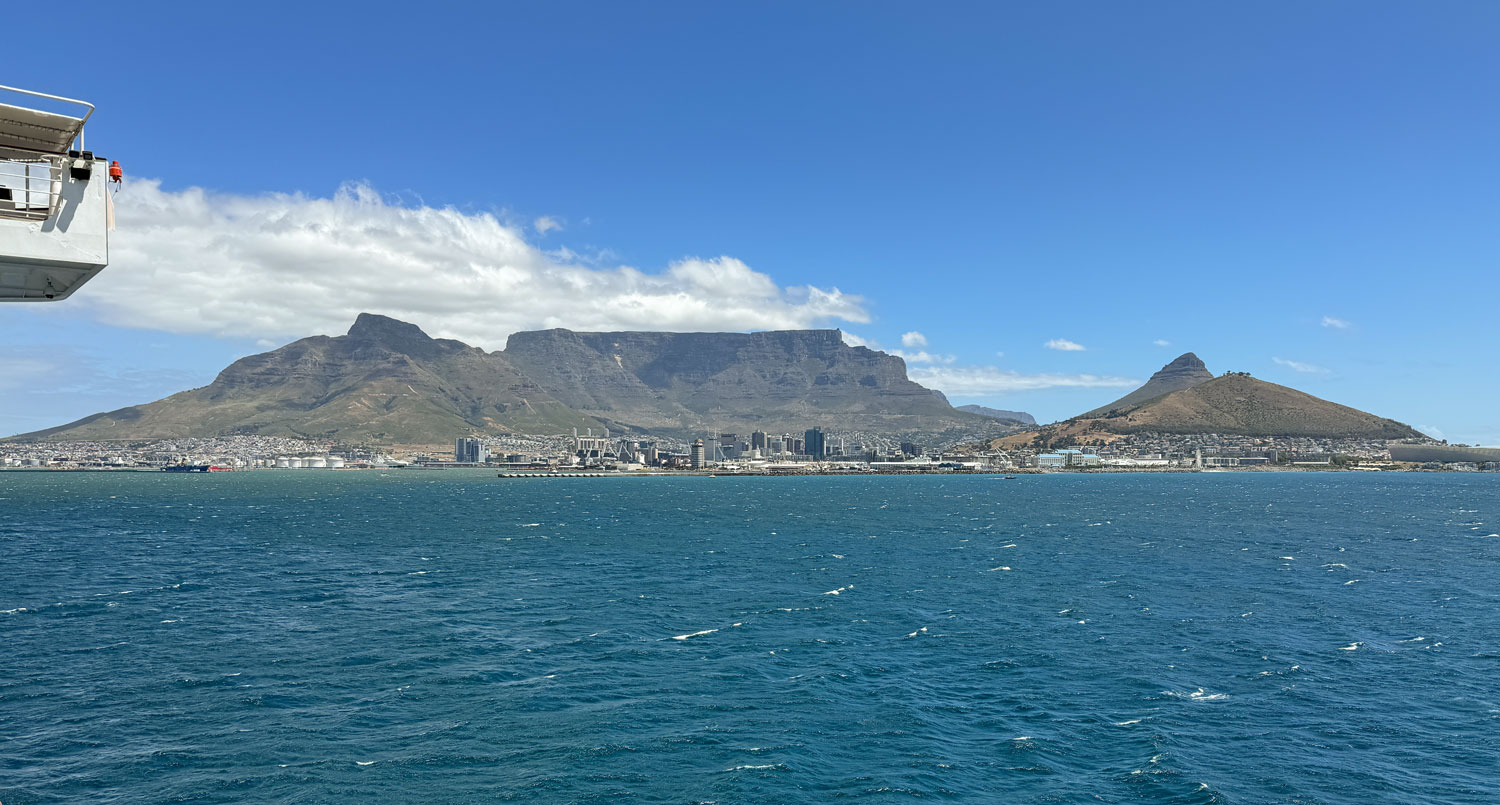
The excursions are going, but Judy and I decided to just stay on the ship and rest. Judy still has a lingering cough.
South Africa requires all passengers to go through a face-to-face passport control, which was done in one of the port buildings. Since we were not going on an excursion, we were some of the last to clear passport control. They never even mentioned yellow fever vaccination documentation (or waiver), even though we had stopped in Senegal, The Gambia, Cote d'Ivoire, Ghana, and Togo, all of which are listed by South Africa as "risk for yellow fever transmission" and should have required us to have a yellow fever vaccination or waiver.
All of the other countries we visited had the passport people come on board and go through the passports with a Regent representative. They stamped our passports, just the same as a face-to-face encounter, so we have visa stamps for all the countries.
We left the ship and walked around the waterfront. It's the same area as the Cape Grace Hotel, where we stayed back in March of this year. We found the big Clicks pharmacy where we bought our malaria medication in March.
Shoplifting is a serious problem for Clicks, and when you want to purchase certain products, the clerk puts the product into a cage and seals it with a zip-tie. Then you take it to the check-out counter where they cut the zip-tie off and remover the product. Judy is showing one of the cages here.

We had a buffet dinner with Eva and Richard. Our luggage must be outside our door by 11pm. No problem - Judy and I will be asleep by then:-)
+++++++++++++++++++++++++++++++++++++++++
12/13/2023 (Wednesday) We left our cabin by 8am and went to the theater to wait for transport to the Commodore Hotel in Cape Town, where we'll have a day room before leaving for the airport.
Our transfer van for our short trip to the hotel. Our luggage was put into the trailer. There were 13 guests and we were crammed tight in that van. But the hotel wasn't far away so it wasn't too bad.
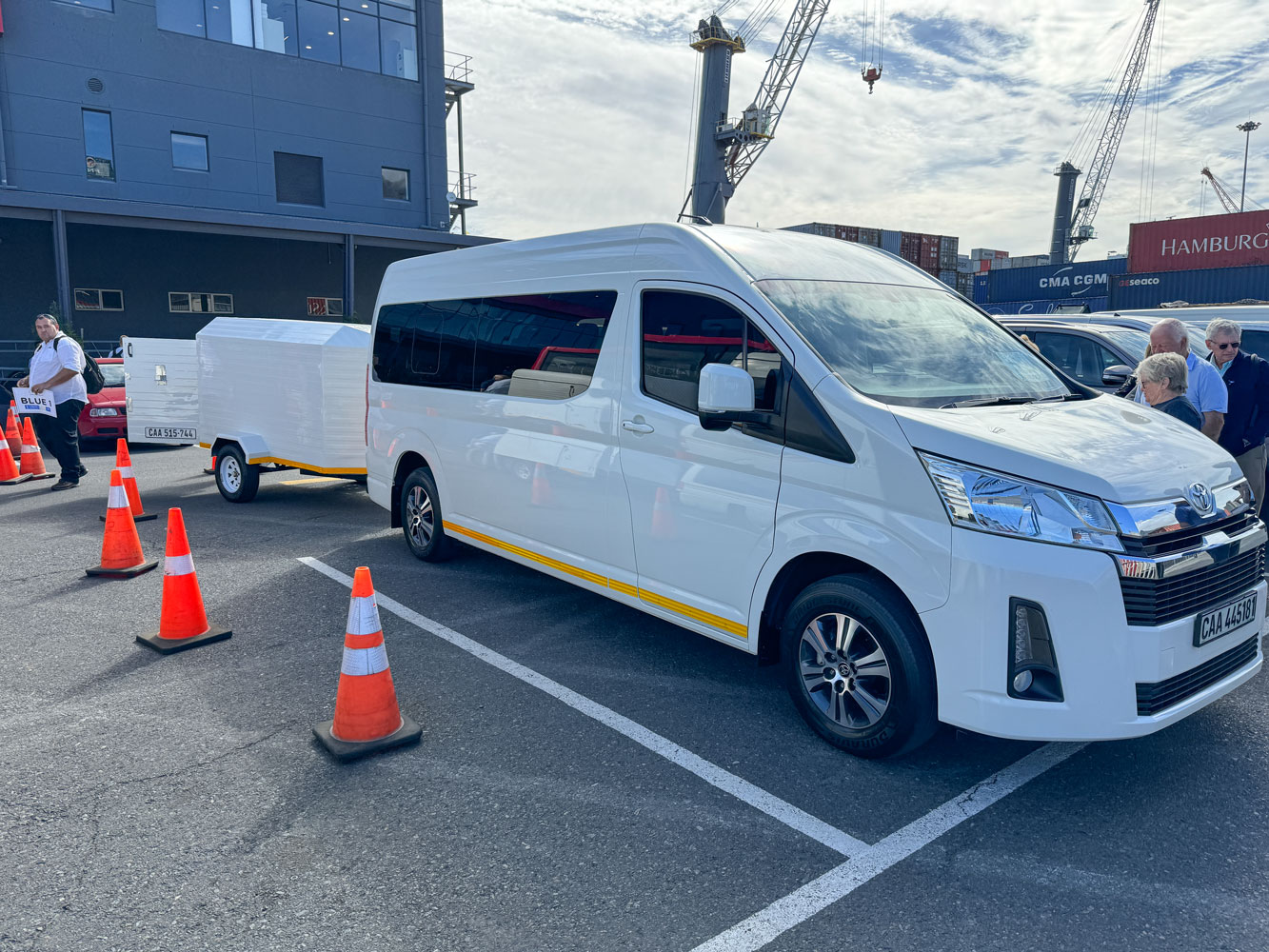
Neither of us are up to par, but better. Our flight out of Cape Town is at 9pm (BA flight 42, a Boeing 777-300). We went walking in the area and had lunch at a "fish and chips" place, but mostly just stayed in the room.
I was getting worried about whether we'd get to the airport on time with the Regent transport so I talked Judy into taking a cab to the airport. Cabs are not expensive here - it was less than $25 from the hotel to the airport. I also wasn't looking forward to being jammed into that van again for the longer ride to the airport.
The airport was "as usual", no real issues. We were able to use the British Airways lounge, and went to the gate about 8pm. Actual take-off was 10pm, delayed by baggage-loading problems. 10pm is past my bedtime and I was exhausted. As soon as the plane took off, I skipped dinner and went to sleep.
+++++++++++++++++++++++++++++++++++++++++
12/14/2023 (Thursday) Both Judy and I were surprised that we were able to sleep most of the night. It was an 11 hour flight. BA offered us breakfast before we arrived, and maintained Britain's claim to the free world's worse food (Russian food is worse).
We arrived at Heathrow airport about 7:15am (local time) but the plane had to wait for a parking space. Heathrow is not an easy airport to get around. We had to transfer from terminal 5 to terminal 3 via a bus. I thought for a little while that the bus was taking us to London - it was LONG drive between those two terminals. I found this map of Heathrow that shows where the terminals are. The map makes the terminals appear to be closer than they apparently are - or the bus goes on a really round about route. Heathrow really is a miserable airport for the passenger.
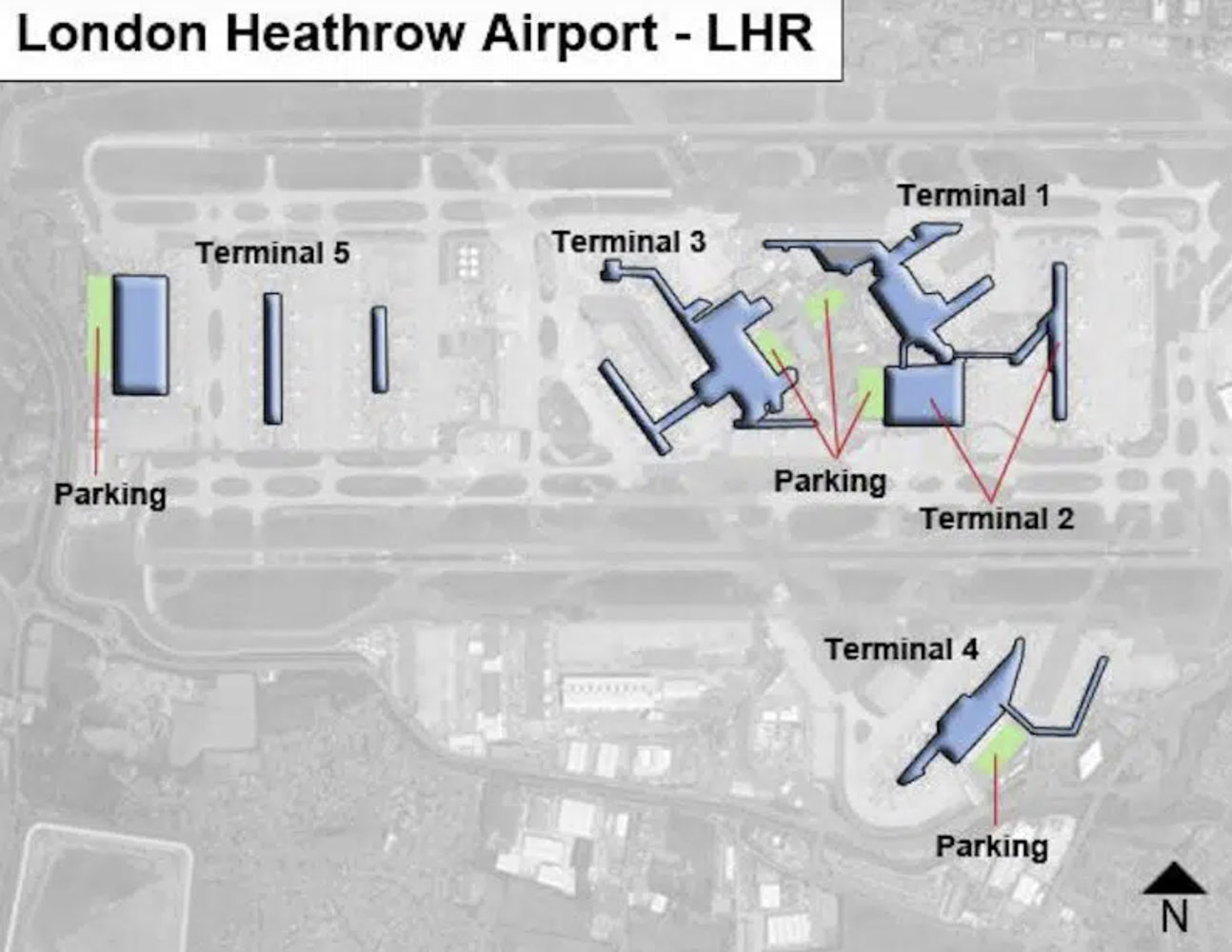
At terminal 3 we had to clear security again, but it moved fast. We found the American Airlines lounge and were able to wait there for our flight.
Our flight departed nearly on-time, 11:15am, on a Boeing 777-300. It's a 12 hour flight. We made our flight arrangements through Regent and they gave us first class from London to LAX. The seats are a bit larger but otherwise, not a lot different than business class. They served us a nice lunch, and we tried to sleep. There's not much else to do on these long flights. Maybe look at a few movies, if you can find one you want to see.
We arrived at LAX on time and the limo driver was waiting for us. It was good to get home - Greg and the girls were waiting for us and happy to see us.
We went to bed early and that was the end of this trip.
+++++++++++++++++++++++++++++++++++++++++
A few of the countries we visited require the yellow fever vaccination. But that vaccine is live virus and the CDC does not recommend it for people over 60 years of age. Judy and I got a waiver letter through Costco and never had a problem. We presented the waiver letter to Regent when we boarded the ship, along with our passports and COVID vaccination record, and they handled it from there. We had some concern about South Africa because they require the yellow fever vaccination if you've been to a country that has active cases of yellow fever, but didn't have a problem. We cleared South African customs in a face-to-face encounter and they never even mentioned yellow fever.
+++++++++++++++++++++++++++++++++++++++++
The end of the year is almost here. Judy and I wish you the best holiday season and a great New Year, filled with happiness and travel.
+++++++++++++++++++++++++++++++++++++++++
Added note: The shacks in the slums are all of very poor construction, and I was confused as to why this should be. Certainly they have the ability to build with better craftsmanship, and over time to improve their dwelling.
I think the reason is that there's no ownership of the home, or police protection of the people living there. It's almost certain that gangs develop in the slums - they do everywhere else - and the gangs would likely take over any shack that was well built. If this is true, having a poorly constructed shack may be the only way to keep a roof over your head - nobody else wants it.
You can get back to our main page here.